

How Many Cruise Ships Have Sunk?
The thought of a cruise ship sinking conjures images of historic maritime tragedies, sparking curiosity and concern among modern travelers.
Despite the advancements in safety and technology, the question lingers in the minds of many: How many cruise ships have actually sunk? In this article, we dive deep into the annals of maritime history and safety records to uncover the truth.
By examining the rare instances of cruise ship sinkings, we’ll provide perspective on the safety of cruising today.
Whether you’re a maritime history enthusiast or planning your next vacation at sea, understanding these incidents sheds light on the impressive safety standards that protect millions of passengers each year.
The Titanic Tragedy (April 1912)
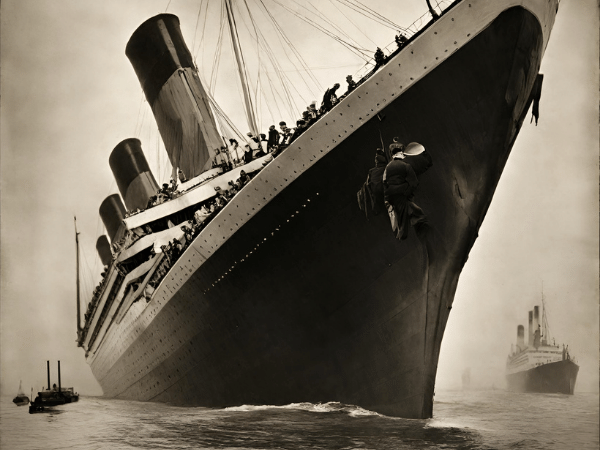
The Titanic’s sinking is one of the most well-known maritime disasters. On its first trip across the Atlantic Ocean, the ship hit an iceberg on the night of April 14, 1912. In just over two and a half hours, the Titanic was completely underwater. Sadly, most passengers couldn’t evacuate safely because there weren’t enough lifeboats for everyone.
The disaster led to more than 1,500 deaths, making it one of the deadliest incidents at sea. The freezing waters made survival even harder for those who couldn’t get on a lifeboat. The Titanic’s sinking is remembered as a tragic event in maritime history.
The Empress of Ireland Tragedy (May 1914)
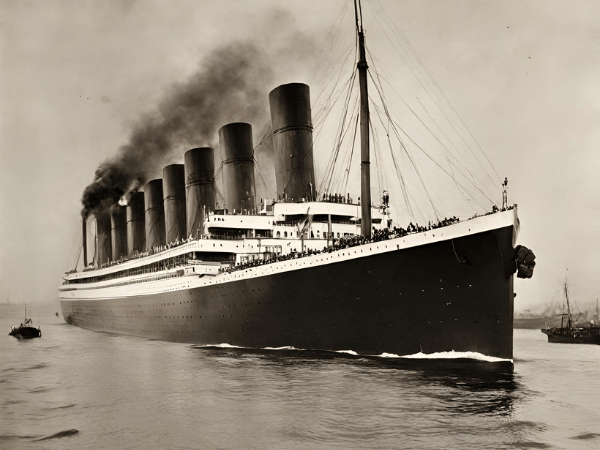
Just two years after the Titanic sank, the Empress of Ireland had its own tragic accident. In May 1914, this ship with nearly 1,500 passengers hit the Norwegian ship Storstad. They could see each other earlier, but then fog made it hard to see.
The crash caused 1,012 passengers and crew to lose their lives. The Empress of Ireland was close to making 1,000 trips without any problems, but this was not one of them. This accident is another sad event in the history of ships at sea.
The Sinking of the Lusitania (May 1915)
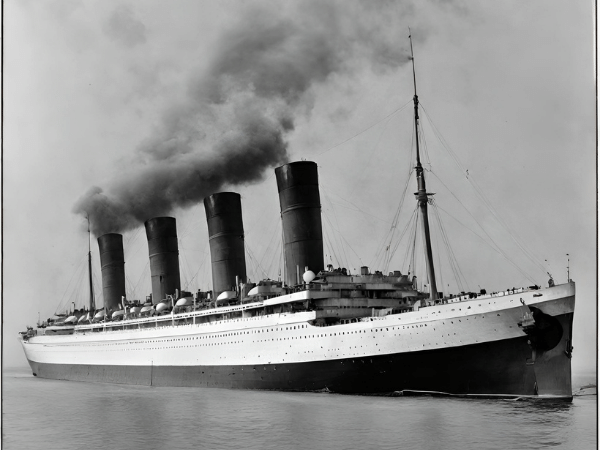
Cunard Line has been operating ships since 1940 and is still active today. One of its famous ships is the Queen Mary 2, the last ocean liner still in service.
The RMS Lusitania, built for Cunard Line, was the world’s largest passenger ship for three months. On May 7, 1915, while sailing off the coast of Ireland to Liverpool, England, a German U-Boat torpedoed the Lusitania. The ship started to sink faster than expected, and only six lifeboats could be launched.
Nearly 1,200 people died in the sinking of the Lusitania. This event is remembered as one of the major maritime tragedies of the early 20th century.
The Britannic’s Fate (November 1916)
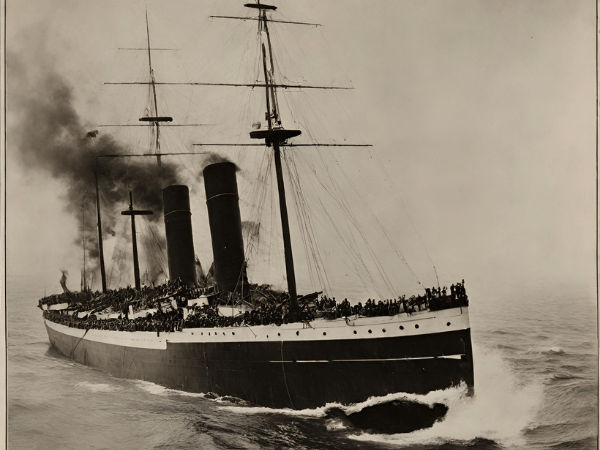
The Britannic was the younger sister of the Olympic (1911) and Titanic (1912). Although intended to be a passenger ship, the outbreak of World War I changed her purpose. She became a hospital ship in December 1915.
In November 1916, less than a year into her service, the Britannic hit a German naval mine in the Kea Channel between the Greek islands of Kea and Makronisos. She sank 55 minutes later.
Fortunately, the casualties were minimal. Most people on board managed to escape on the 35 lifeboats that were launched. However, around 30 people still lost their lives in the sinking of the Britannic.
The Sinking of the Principessa Mafalda (October 1927)
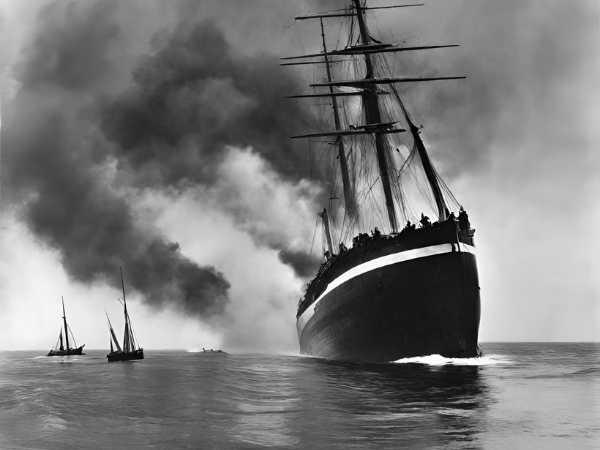
The Principessa Mafalda was an Italian ship named after a princess. It started sailing in 1909 between Genoa, Italy, and Buenos Aires, Argentina.
In October 1927, the ship had a big problem when its propeller shaft broke, damaging the bottom of the ship. It sank off the coast of Brazil, and sadly, more than 300 people died.
The Saint-Philibert Tragedy (June 1931)
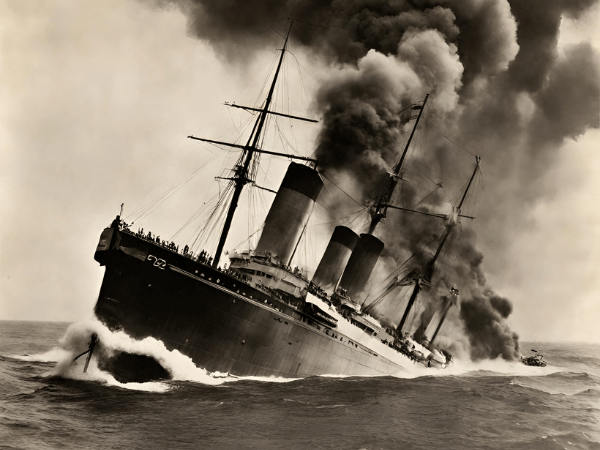
The Saint-Philibert, a small cruise ship, capsized and sank on June 14, 1931, off the coast of France. This tragic event led to the loss of nearly 500 lives, with only 8 passengers surviving.
Before this disaster, the Saint-Philibert was known for offering summer voyages along the French coast.
Check out: What Cruise Can You Go on Alone at 18?
The Sinking of the Georges Philippar (May 1932)
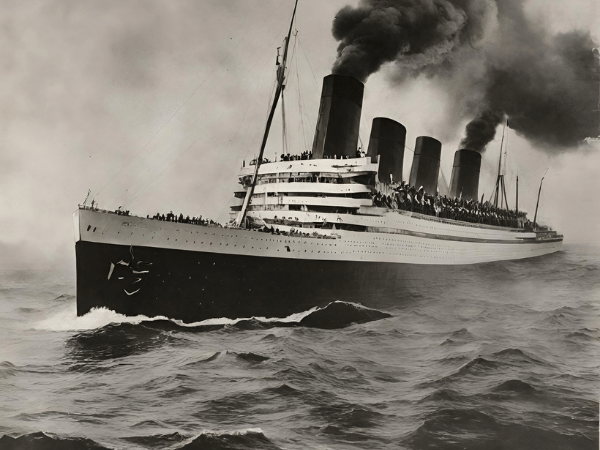
The French ocean liner Georges Philippar sank on the second leg of her maiden voyage near present-day Yemen, resulting in the loss of 54 lives.
The sinking was caused by an electrical fault. A fire started in one of the luxury cabins due to a faulty light switch that sparked and set the wood paneling on fire.
Before setting sail, there were worries about the ship’s safety. The ship’s launch was almost delayed to fix defects. However, these concerns were ignored to avoid penalties for delays.
The Tragedy of the SS Morro Castle (September 1934)
The SS Morro Castle, an American ocean liner operated by Ward Line, was traveling from Havana, Cuba, to New York City when it caught fire and ran aground on September 8, 1934.
The night before the disaster, Captain Robert Rennison Willmott, the ship’s captain, suddenly died after complaining about a stomach ache. Command of the ship was then passed to Chief Officer William Warms.
There were 137 casualties in total. Much of the blame was placed on the crew for not handling the emergency properly. Although the lifeboats could hold up to 408 people, they were launched with only 85.
The Sinking of the Empress of Britain (October 1940)
The Empress of Britain, an ocean liner of over 42,000 gross registered tons, holds the sad record of being the largest ocean liner sunk during World War II, and also the largest ship sunk by a U-Boat during the conflict.
On October 26, she was first bombed from above, then sunk by a torpedo launched by German U-Boats on October 28.
Most of the 416 crew members, 2 gunners, and 205 passengers managed to abandon the ship, leaving few people on board. In total, 45 people lost their lives in this tragic event.
The Collision of Andrea Doria and MS Stockholm (July 1956)
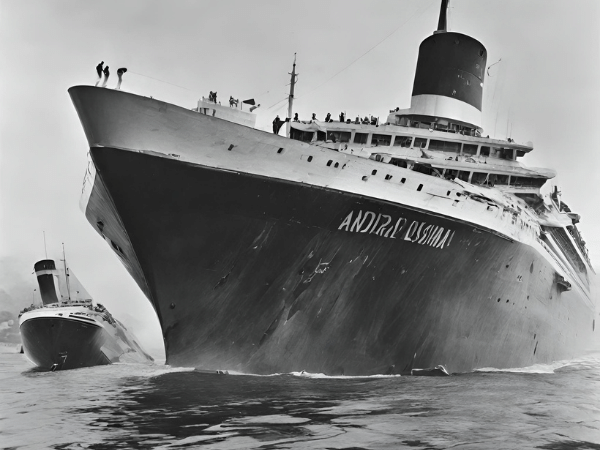
On July 25, 1956, the Andrea Doria and the MS Stockholm collided while on their way to New York City. The accident resulted in 51 deaths. However, this event is also known for one of the largest rescues in maritime history.
Thanks to improved communication systems, the crew of the Andrea Doria was able to quickly start rescue efforts and get help from other ships. Only five people died on board the Stockholm.
The damage to the Andrea Doria was so severe that the ship could not be saved. Those who lost their lives did so because of the initial collision.
The Story of the Bianca C (October 1961)
The Bianca C first sank during World War II when the Germans scuttled her before she was completed. Later, her hull was raised and refitted to become a cruise ship. She was first owned by Panama’s Arosa Line as their flagship but was eventually sold to Costa Line, where she got the name Bianca C after the owner’s daughter.
On October 22, 1961, while docked off the coast of Grenada, an explosion in the ship’s engine room led to fires breaking out. Thankfully, except for one person killed in the initial explosion, everyone was able to evacuate the ship before it sank.
The Journey and End of the Angelina Lauro (September 1979)
The Angelina Lauro didn’t always serve as a cruise ship. She started her journey in 1939 as the MS Oranje. Initially meant to be a passenger ferry, she was kept in Indonesia and turned into a hospital ship. After World War II, she sailed as a passenger liner for around 11 years, making trips around the world from Amsterdam to Australia through the Panama Canal and back via Singapore and the Suez Canal.
In 1964, she was sold to Lauro Lines and refitted as a cruise ship. She embarked on her maiden voyage as the Angelina Lauro on March 6, 1966. In the late 70s, Costa Lines chartered her.
While docked in Saint Thomas, the Angelina Lauro caught fire. The blaze lasted for several days. Before she could be towed to a scrapyard, her weakened hull began to take on water. She finally sank on September 24, 1979.
The Sinking of the MS Mikhail Lermontov (February 1986)
The MS Mikhail Lermontov was an ocean liner operated by the Soviet Union’s Baltic Shipping Company, entering service in 1972. A decade later, it was upgraded to serve as a cruise ship.
On February 6, 1986, the ship left Sydney for a two-week cruise around New Zealand. Ten days into the journey, while sailing past Cape Jackson, it hit rocks. Out of the 743 crew and passengers on board, the majority managed to escape on lifeboats. Tragically, there was one casualty: crew engineer Pavel Zagladimov.
The Tragic Collision of the SS Admiral Nakhimov (August 1986)
The SS Admiral Nakhimov started its journey in 1925 as the SS Berlin, a passenger liner of the German Weimar Republic. It later served as a hospital ship before becoming a Soviet Union passenger ship.
In August 1986, the ship met a tragic end when it collided with another ship in Tsemes Bay. The ship sank quickly, and sadly, 423 people lost their lives in the incident. This marked the third and final time that the ship sank.
The Sinking of MV Jupiter (October 1988)
The MV Jupiter, a Greek cruise ship, started sailing in 1961 as the Moledet. On October 21, 1988, it sank after leaving Piraeus, Greece. An Italian freight ship hit it.
The ship had nearly 400 British students, 84 adults, and 110 crew members on a study cruise. Sadly, one student, one teacher, and two crew members died. About 70 others were injured.
The Sinking of MTS Oceanos (August 1991)
The MTS Oceanos, another Greek ship, sank three years after the MV Jupiter. It was traveling from South Africa to Durban when rough seas hit. A storm made things worse.
The ship’s waste system wasn’t fixed right. A key pipe wasn’t replaced. It’s thought that huge waves broke the pipe, letting seawater flood in.
No one died, but the captain and crew were found guilty of leaving without helping passengers. The ship’s entertainers led all rescue efforts.
The Sinking of MS Estonia (September 1994)
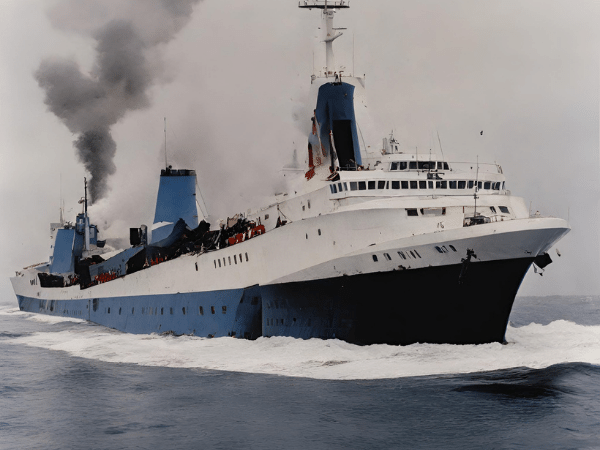
The sinking of the MS Estonia in 1994 was one of the worst maritime disasters of the 20th century. It was the deadliest peacetime sinking of a European ship after the Titanic and the Empress of Ireland. Over 850 lives were lost.
While sailing through rough waters in the Baltic Sea, a metallic bang was heard. Soon after, passengers and crew reported similar sounds. Around 1:15 am, the visor separated, opening the loading ramp and causing the ship to list as water flooded in.
It was difficult for those in cabins to reach the boat deck. Water was entering the ship through the car deck and the windows of public areas and cabins on Deck 6.
The Achille Lauro Incident (December 1994)
The Achille Lauro, originally the ocean liner Willem Ruys, was converted into a cruise ship by Italian businessman Achille Lauro in 1965. It had a series of unfortunate events, including collisions and onboard fires.
In 1985, the ship was hijacked by members of the Palestine Liberation Front. On November 30, 1994, the Achille Lauro caught fire while sailing to South Africa. There were 979 passengers and crew onboard. The majority evacuated the next morning when the ship listed, but two people were killed before it sank on December 2.
The Final Voyage of the Sun Vista (May 1999)
The Sun Vista started its journey in 1963 as the SS Galileo Galilei for the Lloyd Triestino line. Over the years, it sailed for five different cruise lines, including as the first-ever cruise ship for Celebrity Cruises, the Meridian. In 1997, it was transferred to Sun Cruises and renamed the Sun Vista.
On May 20, 1999, a fire broke out in the ship’s engine room. The Sun Vista sank in the early morning hours of May 21 in the Strait of Malacca. Fortunately, all passengers and crew were able to escape safely.
The Sinking of the Britanis (October 2000)

The Britanis began its life as the luxury ocean liner SS Monterey in 1932. It later sailed for Chandris under their “Fantasy Cruises” division starting in February 1971. When Chandris shifted focus to the Celebrity Cruises brand, all Fantasy Cruises operations ceased. In 1998, the ship was sold to AG Belofin and renamed Belofin-1.
Instead of being refurbished, the Britanis was sold to scrappers. While being towed to a scrapyard from Brazil, it developed a leak at the back of the ship. With no one on board, the ship was cut free and capsized off the coast of Cape Town, South Africa.
The Sinking of SeaBreeze (December 2000)
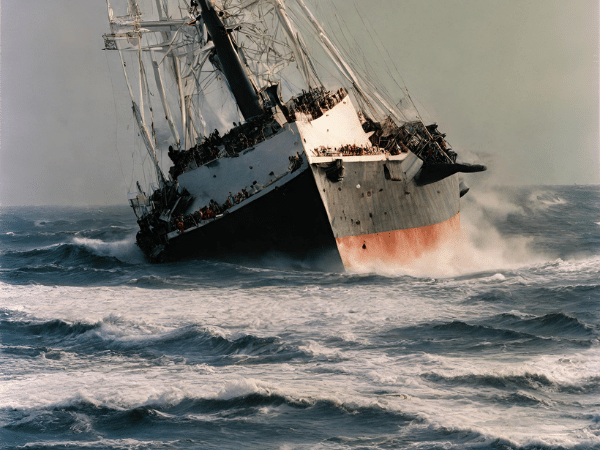
The SeaBreeze, originally named Federico C., was launched in 1958 and sailed for Costa Cruises. In 1983, it was transferred to Premier Cruises and renamed three times.
Premier Cruises went out of business in September 2000, leading to the ship being laid up. While being moved from Halifax, Nova Scotia, to Charleston, South Carolina, by its new owner, Cruise Ventures III, the SeaBreeze sank about 225 nautical miles off the coast of Virginia. All 34 crew members on board were rescued safely.
The ship sank due to the boiler breaking off, causing significant damage to the vessel.
The Sinking of MV Explorer (November 2007)

The MV Explorer, originally the MS Lindblad Explorer, began her career in 1969 as the first ship of her kind to sail through the Antarctic Ocean.
On November 11, 2007, she set sail from Ushuaia, Argentina, for a 19-day cruise. After visiting the Falkland Islands, she hit an iceberg in the Bransfield Strait on November 23, causing a gash in the hull that let water in.
All 91 passengers, 53 crew, and 9 guides were able to escape on lifeboats. They stayed there for five hours until the MS Nordnorge rescued them.
The Sinking of MS Sea Diamond (April 2007)
The MS Sea Diamond, originally known as Birka Princess, operated for Birka Line for most of her time at sea. In 2006, she was sold to Louis Cruises Line and renamed. A year later, she ran aground on a reef near Santorini, with 77 students from Paisley Magnet School in North Carolina on board.
Initially, it was believed that all passengers and crew were safe. However, two French citizens, Jean Christophe Allain, 45, and his daughter Maud, 16, were reported missing and never found.
Greek authorities later announced plans to charge the captain and five other officers with negligence.
The Capsizing of Costa Concordia (January 2012)
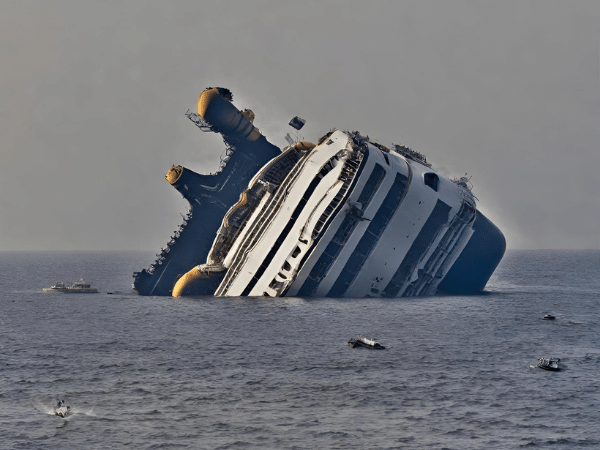
The Costa Concordia was the first ship of Costa Cruises’ Concordia Class, entering service in 2006. On January 13, 2012, she set sail on a 7-night Mediterranean cruise with 3,206 passengers and 1,023 crew members.
Captain Francesco Schettino veered off course, sailing too close to the island of Giglio. The ship struck a large rock, causing a 174-foot gash in the hull, leading to flooding and loss of power. The ship’s rudder position made it unsteerable, and it began tilting toward the starboard side.
The evacuation took over six hours and resulted in 32 deaths. An investigation focused on the crew’s actions, particularly Captain Schettino’s, as he left the ship while passengers were still on board.
Leave a Comment Cancel reply
Save my name, email, and website in this browser for the next time I comment.

Tragic List: Discover How Many Cruise Ships Have Sunk Throughout History
How Many Cruise Ships Have Sunk: Millions of people choose cruise ships for their vacations every year because they provide opulent amenities, thrilling activities, and the chance to see several places in one journey. But sometimes people doubt these enormous floating hotels’ safety, especially when you consider that they might sink.
There have been very few cruise ships that have sunk in the past century. Because of the safety procedures followed by the cruise liner industry, most or all of the passengers and crew survive when a cruise ship sinks.
How Many Cruise Ships Have Sunk
Only twenty-four cruise ships—both river and ocean liners—have sunk since 1912. It’s important to remember that some cruise ship capsizings happen while the ship was being towed or berthed.
Because cruise ships are built sturdy and have current safety mechanisms, we can explain why there aren’t many cruise ship sinkings.
Today’s cruise ships are extremely resistant to sinking because of their emphasis on safety throughout construction. Modern cruise ships are outfitted with a plethora of safety precautions to preserve as many lives as possible in the event of an unfortunate disaster.
Consequently, the death toll from these kinds of incidents is usually rather low.
Sadly, several people lost their lives in some of the first sinkings.
Since 1912, a cruise ship has sunk an average of once every 4.5 years, underscoring how uncommon these incidents are. However, as safety and technology advance and we continue to learn from past tragedies, the number of cruise ship disasters is declining.
While cruise ship sinkings are uncommon, there have been a few famous cases, like the Titanic and the Costa Concordia catastrophe. However, despite these high-profile incidents, the cruise industry does have a remarkable overall safety record.
What percentage of cruise ships sink?
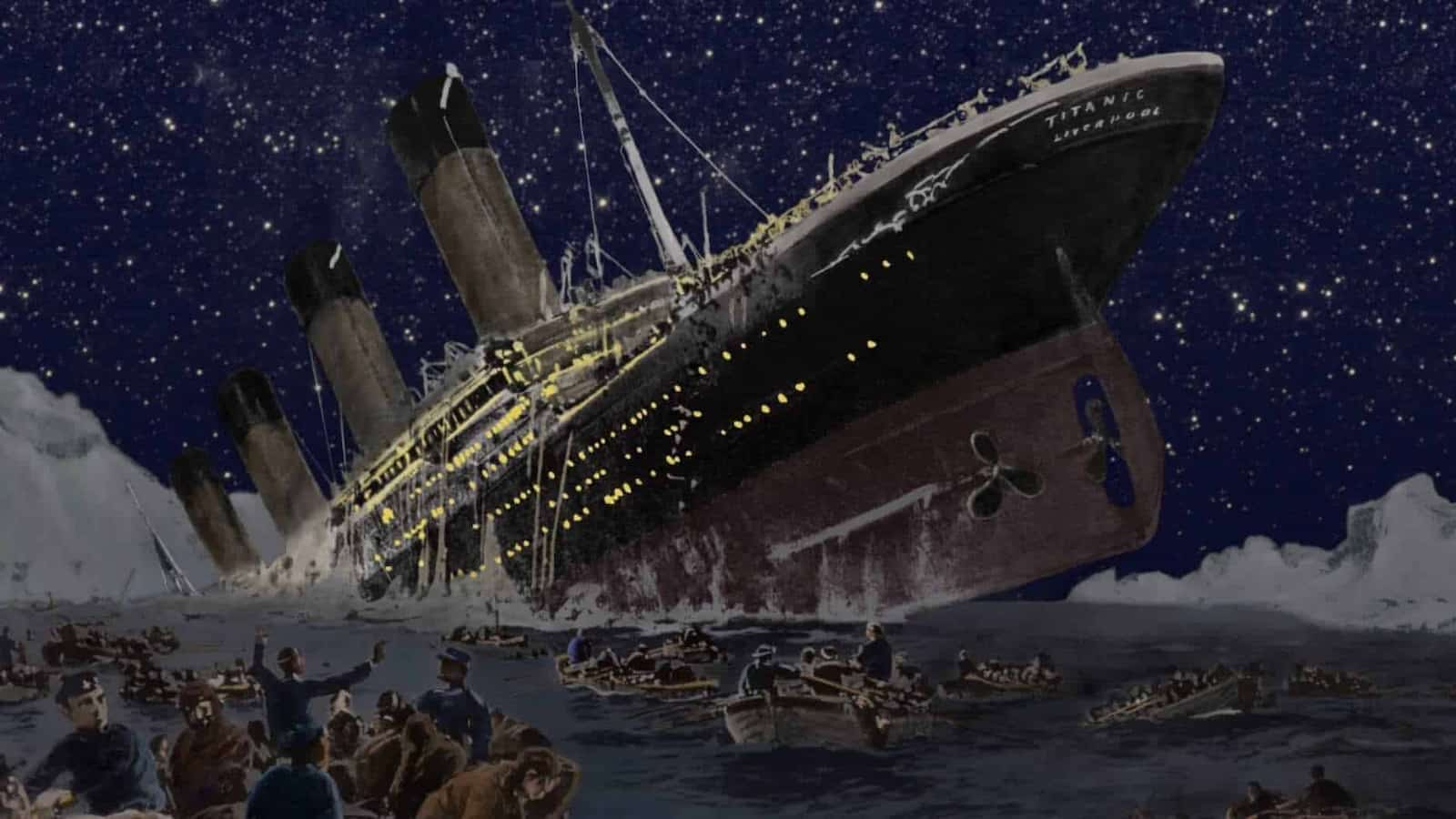
It’s critical to realize that cruise ship sinkings are quite uncommon. There have only been 22 cruise ship sinkings in the last 100 years.
Still, a number of shipwrecks happened while docked or being towed. Given the quantity of cruise ships that are in operation all year round, cruise ship sinkings are quite unusual.
Many safety precautions included into contemporary cruise ships reduce the possibility of a sinking. Strict rules and inspections also contribute to the high standard of safety that is maintained on these boats. Cruise ship sinkings are uncommon, which is partly due to these efforts and technological developments.
Cruise ship worker salary: How much do they make?
In contrast to this total, cruise ships in particular have an even lower frequency of sinking. Although it is difficult to pinpoint the exact number of cruise ship sinkings in the recent past, it is widely accepted that these incidents are uncommon and do not pose a serious threat to passengers.
In conclusion, the rarity of cruise ship sinkings can be attributed to stringent safety rules and contemporary technology. Travelers may relax knowing that their cruise ship experiences will be stable and safe.
Do Cruise Ships Sink Frequently?
Because of stringent restrictions and advanced safety systems, cruise ships seldom sink. In the last century, there have only been 20 cruise ship sinkings.
It is noteworthy that not all of these sinkings contained passengers or caused a sizable number of casualties.
The frequency of cruise ship sinkings has decreased due to advances in navigation technology.
Are Cruise Ships Capable of Sinking?
Cruise ships do occasionally sink, but this is extremely uncommon.
Contemporary cruise ships come with cutting-edge safety technologies that reduce the chance of capsizing. In addition, watertight compartments and improved hull construction keep a ship from absorbing too much water. Cruise ship crew members are also regularly trained in safety exercises and emergency procedures.
Despite these safety precautions, 24 cruise ships and ocean liners have sunk since the RMS Titanic disaster in 1912.
In spite of the disconcerting prospect of a cruise ship sinking, safety remains the cruise industry’s top priority. Compared to other means of transportation, passengers may travel with peace of mind on one of the safest modes.
When Did a Cruise Ship Most Recently Sink?
The last time a cruise ship capsized while carrying people on board was the Costa Concordia, which grounded in Italy in 2012. Thirty-four people perished when the Italian cruise liner struck rocks and subsequently capsized. The accusations made against the ship’s crew, especially Captain Francesco Schettino, who is currently serving a 16-year manslaughter term, made the incident noteworthy as well.
To provide the highest level of security for its patrons, the cruise industry has enacted a number of safety rules and procedures in recent years. These modifications have greatly decreased the quantity of mishaps and sinkings, which has helped to explain why we don’t hear about them as frequently.
Why Do Ships Stay Afloat?

Even while cruise ships, in particular, might be extraordinarily large buildings, their purpose is to float on water with ease. It is because of the buoyancy principle that cruise ships may float. Any object submerged in a fluid (such as water) experiences an upward force equal to the weight of the fluid the object has displaced. This is known as Archimedes’ principle, or the physical law of buoyancy.
The hull form of a ship is a major component that affects its buoyancy. Because of their wide, flat bottoms, ships are able to move a lot of water. This displacement produces an upward force that balances the ship’s weight.
If the density of the cruise ship is lower than that of the water, it will still float.
Steel and aluminum are two examples of strong, lightweight materials used in ships that offer structural support while maintaining a low overall density. In addition, the hull is separated into waterproof sections so that, in the event of damage, water does not flood the entire ship. This design keeps cruise ships from toppling over and aids in maintaining the ship’s buoyancy.
Preventing a ship from capsizing also depends on its stability. A low center of gravity is a feature of ship design. Heavy parts of the ship, including engines and fuel tanks, are located in the lowermost part of the structure to provide a low center of gravity. Even in choppy waters, the ship will stay upright and steady thanks to the design philosophy.
Best Cruises for Adults: 4 Perfect Cruise Lines for Adult Only experience
Overview of How Many Cruise Ships Have Sunk Throughout History
1912’s rms titanic.
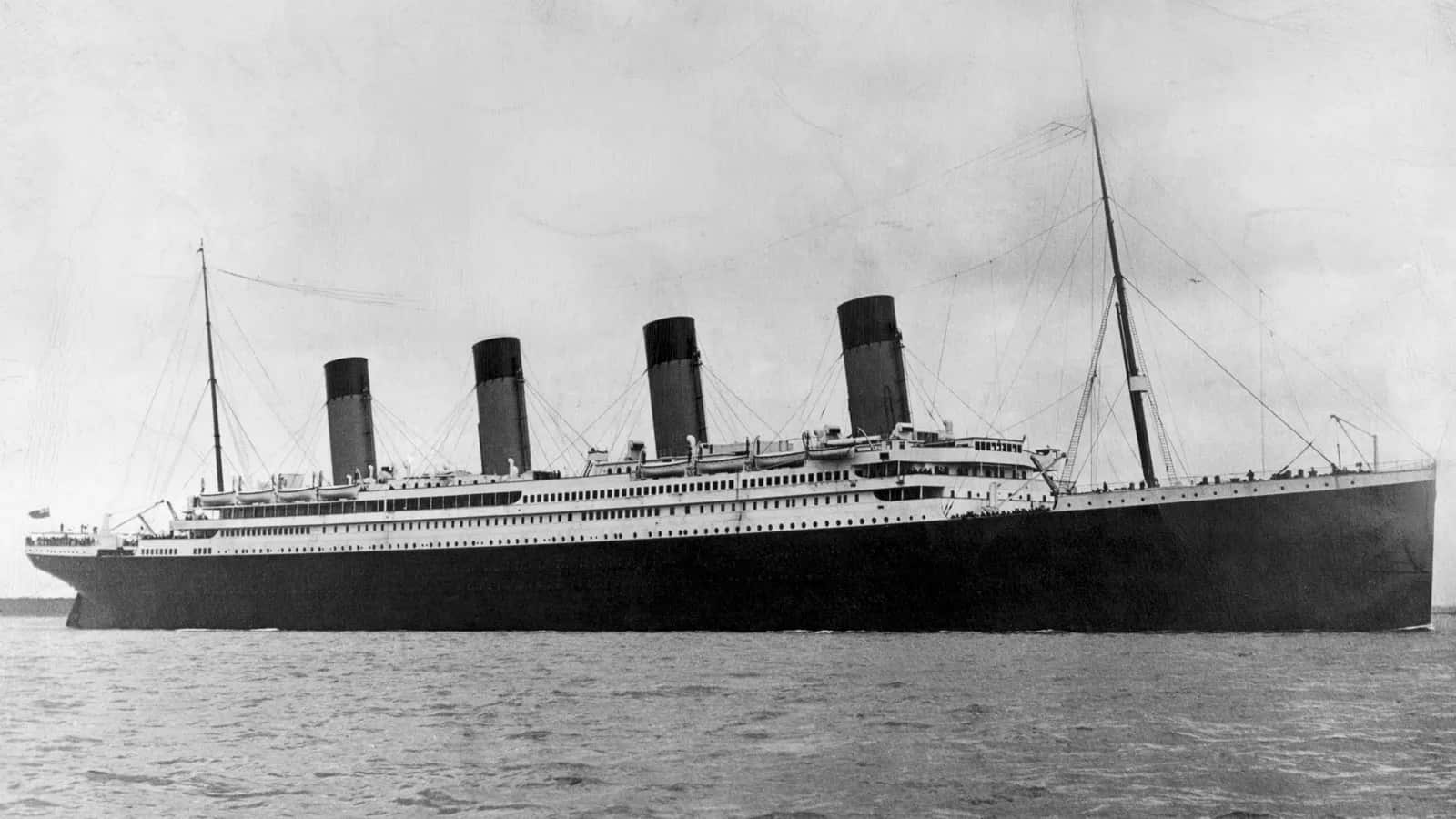
On April 15, 1912, the British passenger ship RMS Titanic sank in the North Atlantic Ocean. When the ship struck an iceberg on its first trip from Southampton, UK, to New York City, it sank. Out of the estimated 2,224 passengers and crew, 1,517 are thought to have perished in the accident.
The Titanic was regarded as an engineering wonder when it was built and was the largest ship ever to sail. With more than 2,200 passengers and crew members on board, she sailed for her maiden transatlantic voyage. Despite multiple alerts of icebergs up ahead on April 14, the Titanic proceeded to travel at a speed of 22 knots.
Lookouts noticed an iceberg on the ship’s course just before midnight. The Titanic suffered damage below the waterline when she met the iceberg on her starboard side due to her inability to turn quickly enough.
It was obvious the ship would sink when water began to fill it. There was a significant death toll from the Titanic accident because there were not enough lifeboats and the water was quite cold. Laws about maritime safety have significantly improved as a result of the disaster.
Empress of Ireland in 1914
Early on May 29, 1914, in the thick fog, the ocean liner RMS Empress of Ireland collided with another ship and sank in Canada’s St. Lawrence River.
There were 1,477 passengers and staff members on board the Empress as it traveled from Quebec City to Liverpool. The Norwegian collier Storstad struck the Empress, causing significant damage and rapid submersion. Despite hasty attempts to evacuate passengers, the ship sank in about fourteen minutes. The accident claimed 1,012 lives from those on board, making it the deadliest marine accident to occur in Canadian history during a peacetime.
1915’s RMS Lusitania
On May 7, 1915, during World War I, a German U-boat torpedo sank the British ocean liner RMS Lusitania, killing 1,198 people—passengers and crew. The Cunard Line-owned Lusitania was torpedoed off the coast of Ireland when it was making her 202 transatlantic voyage from New York to Liverpool.
A second explosion burst from the ship’s hull shortly after the torpedo hit. Due to the significant damage and degree of listing, only six lifeboats were able to descend from the starboard side of the ship.
The ship sank around eighteen minutes after the torpedo hit. Seventy-six out of the 1,962 passengers and crew on board the Lusitania made it out alive.
The RMS Lusitania was allegedly carrying 173 tons of weapons and ammunition, according to the German authorities. Apart from the small arms ammunition listed on the ship’s military cargo, the British government disputes that the ocean liner carried any war weaponry.
1916’s HMHS Britannic
HMHS Britannic was the third and largest Olympic-class ocean liner that White Star Line operated. Constructed as a transatlantic passenger liner, the ship was launched shortly before the outbreak of World War I.
Before Britannic could be used for passenger travel following the start of the war, the British Admiralty seized her and renamed her Britannic as a hospital ship. The Britannic ran into a naval mine that a German U-boat had planted while it was in the Aegean Sea in November 1916.
In approximately 55 minutes, the explosion destroyed much of the ship and caused serious damage. Despite the sinking’s rapid pace, the prompt evacuation saved 1,030 lives. 30 persons sadly lost their lives in the sinking.
1927’s Principessa Mafalda
Off the coast of Brazil in 1927, the Italian transatlantic liner SS Principessa Mafalda sank. The ship departed on her 14-day voyage after a technical delay.
The ship made multiple stops in the ocean during the voyage, indicating that it was not in good shape. The breakage of the starboard propeller shaft on October 25 resulted in numerous hull gashes.
The ship started to absorb water, and the watertight doors could not be closed all the way. It took the ship more than four hours to sink completely. However, miscommunication resulted in 314 fatalities.
1932-Georges Philippar
In 1932, the French passenger liner Georges Philippar caught fire and sank in the Gulf of Aden, killing fifty-four people. On May 16, during her inaugural journey off the coast of Italian Somaliland, Mme Valentin’s opulent cabin’s wood paneling caught fire due to a malfunctioning light switch.
The fire was allowed to spread quickly since there was a delay in reporting it. Captain Vicq tried to put out the fire and beach the ship, but things worsened.
The engine rooms were evacuated, leaving the Georges Philippar adrift. The captain issued a distress call and told the crew and passengers to get off the ship. The French ship Andre Lebon, the two British cargo ships Mahsud and Contractor, and the Soviet tanker Sovietskaïa Neft were the three neighboring vessels that came to the rescue.
Rescuers were able to save 698 people. 54 people died, nevertheless, some of them from desperate jumps overboard.
1934’s SS Morro Castle
On September 7, 1934, at around three in the morning, a fire broke out on board the opulent ocean liner SS Morro Castle, which was traveling from Havana to New York City. Strong winds contributed to the fire’s rapid out-of-control spread.
Chaos broke out as terrified passengers had to decide whether to leap into the sea or stay on the blazing ship, even as efforts were made to put out the fire and launch lifeboats. The ruined Morro Castle ran aground close to Asbury Park, New Jersey, after only six hours.
Only 312 of the 549 occupants, including the crew, made it out alive.
Following investigations, it became clear that a lack of training and preparation for fire safety contributed to the shockingly high death toll. The burned-out wreck, which served as a somber reminder of the horror everyone on board had to endure, remained on the beach until 1935.
The fatal incident made it clear that ocean liners need to strengthen their fireproofing, safety exercises, and crew training.
Empress of Britain – 1940
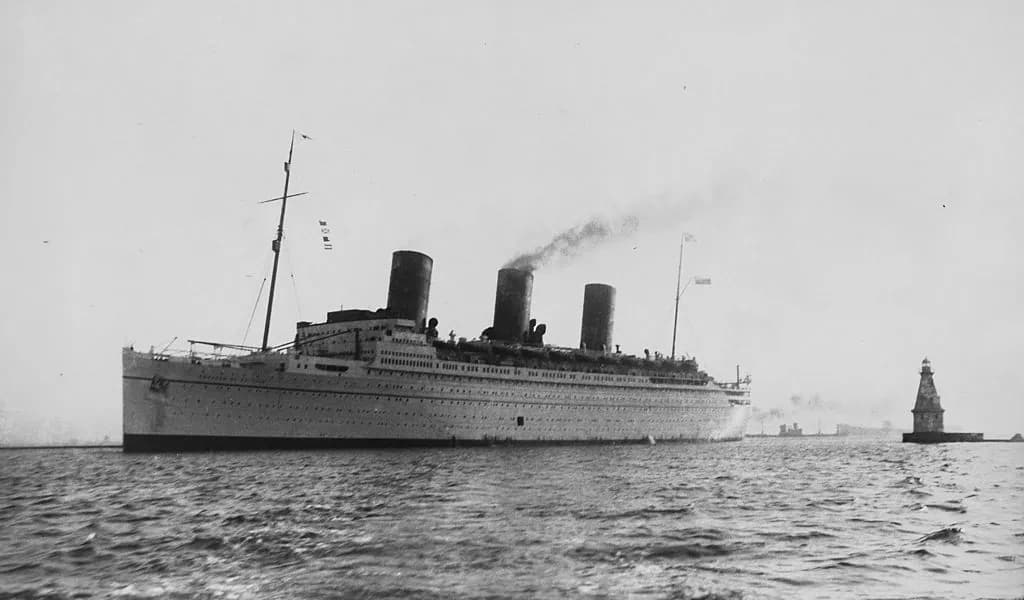
The Canadian Pacific Steamship Company, which the Canadian Pacific Railway and the RMS Empress of Britain owned, transported people and soldiers across the Atlantic during World War II.
The German submarine U-32 fired two torpedoes at the Empress of Britain early on October 26, 1940, as it was cruising roughly 450 miles west of Ireland. The damage was too great, leading the ship to list badly in spite of efforts to prevent flooding.
Lifeboats were hastily lowered into the darkness after the order to evacuate the ship, with some capsizing in the confusion as flares lit up the sky. British navy ships saved 1,259 people from the sinking liner, but 45 unfortunate people perished in the early explosions or drowned.
The graceful British Empress had disappeared under the seas by sunrise, exposing civilian ships to Germany’s merciless submarine warfare techniques.
Andrea Doria – 1956
In July 1956, the Italian ocean liner SS Andrea Doria carried more than 1,700 passengers and crew members on a normal trip from Italy to New York. In extremely foggy conditions, the Andrea Doria and the Swedish ship Stockholm collided on July 25, off the coast of Nantucket, Massachusetts.
Below the waterline, the Stockholm’s bow caused catastrophic damage by severing passenger compartments and stabbing into Andrea Doria’s side. Ten hours later, in excess of 200 feet of water, the mortally damaged Andrea Doria sank in spite of attempts to contain flooding.
Thankfully, 1,660 individuals made it out of the lifeboats. Nevertheless, 46 people died as a result of impact injuries and drowned during the intense crash.
How Cruise Ships Are Built: A 2-Year Process
1961’s Bianca C
The ship Bianca C is special since it sank twice. The first sinking occurred during World War II when a German-operated passenger ferry was sunk.
Before it sank in 1961, the ship’s hull was lifted and converted into a cruise liner.
With more than 600 passengers and crew, the Italian cruise liner Bianca C sailed from Grenada to Italy overnight on September 22, 1961. An explosion in the engine room at midnight caused a fire that swiftly spread throughout the ship.
The captain gave the order for the staff and passengers to leave the burning ship as smoke filled the halls. As other ships raced to help, liferafts and lifeboats were lowered into the murky tropical waters. While the majority of passengers safely evacuated the Bianca C, one staff member unfortunately perished in the explosion. However, the crew and all other passengers made it out safely.
1979 Angelina Lauro
In March 1979, Costa Lines acquired the aging Italian ocean liner Angelina Lauro. When the new cruise line was chartering the ship, it caught fire while berthed in Saint Thomas.
After burning for a few days, the ship was declared completely destroyed. The fire did not claim any lives.
1986’s MS Mikhail Lermentov
Around 1,000 guests and crew perished when the Soviet cruise ship Mikhail Lermentov struck rocks and sank off the coast of New Zealand on February 16, 1986. During the frantic evacuation, the chief electrical engineer sadly drowned, although no passengers were lost.
In a matter of hours, rescue ships and aircraft safely evacuated everyone else on board the sinking ship before it submerged beneath the water. A subsequent investigation found that inadequate navigation had caused the enormous ship to veer dangerously near the rocky reef in low light, rupturing a huge hole in the hull and quickly flooding the liner.
1986’s SS Admiral Nakhimov
On our list, SS Admiral Nakhimov has the most intriguing tale. The ship has sunk three times in total.
It served as a hospital ship for Germany during World War II before being lost.
The ship was turned up to the Soviet Union as payment for reparations. The Germans had hidden mines in the ship’s hull, which detonated and caused the ship to sink a second time, despite Soviet attempts to retrieve its hull.
On August 31, 1986, the SS Admiral Nakhimov sank for the third and last time. In the Black Sea, close to the Strait of Kerch, the Soviet passenger liner and the bulk freighter Pyotr Vasev collided. Admiral Nakhimov’s hull sustained a huge hole from the accident, which quickly caused the ship to flood.
When the electricity went out, the evacuation process became disorganized due to a lack of lifeboats and inadequate leadership. The Admiral Nakhimov sank after capizing in thirty minutes. Sadly, more than 423 people perished.
1988’s MV Jupiter
The British roll-on/roll-off ferry MV Jupiter and the tanker Phoenix II collided on June 21, 1975, as the two were traveling from Dover to Zeebrugge across the English Channel. The accident caused catastrophic flooding by rupturing open the car deck of the MV Jupiter.
The majority of the 585 passengers and crew were evacuated as the Jupiter began to list alarmingly. Tragically, two passengers—a teacher and a student—as well as two crew members perished.
1988 Achille Lauro
As the Italian cruise ship Achille Lauro sailed off Somalia on November 30, 1994, a destructive engine room fire broke out and swiftly got out of control. Tragically, during a nocturnal emergency evacuation, two passengers perished.
Rescue ships and aircraft were able to successfully evacuate all remaining passengers and crew from the burning liner. The ship sank following two days of fierce firefighting.
An engine room explosion was found to be the cause of the safety systems’ deactivation.
MTS Oceanos – 1991
The Greek cruise liner Oceanos sank off the coast of South Africa on August 3, 1991, as a result of severe waves that broke a ventilation pipe. It’s thought that a poor repair made the pipe susceptible to impacts.
A broken ventilation pipe was to blame for the severe flooding. The captain and a few other crew members left the ship as soon as they realized it was sinking.
Amazingly, the entertainment crew stepped up and assisted guests in getting off the sinking ship. Over the following two days, nearby vessels saved all 571 people.
Sun Vista (1999)
The Sun Vista, a cruise liner from Malaysia, capsized in the Malacca Strait on August 8, 1999, due to extreme listing caused by an engine room fire that took off power. The well-trained crew quickly boarded lifeboats with all of the passengers and crew after making a call for assistance from nearby ships.
SeaBreeze (2000)
A catastrophic mechanical failure caused the cruise ship Seabreeze I to swiftly sink on December 17, 2000, when it was sailing about 225 nautical miles off the coast of Virginia. The 21,000 GT, 9-deck passenger ship had just been purchased by Cruise Ventures III, who was traveling from Halifax to Charleston when the catastrophe occurred.
According to reports, the boiler broke away, seriously injuring the engine room of the ship and resulting in significant flooding. The captain yelled “abandon ship” as the 40-year-old Seabreeze quickly began to take on water, requesting that the 34 crew members be rescued right away.
There was a lot of suspicion surrounding the sinking since some people thought it was intentional. The old Seabreeze had a $20 million insurance policy even though its scrap value was probably about $5–6 million.
The vessel capsized in international seas. Maritime authorities questioned Panama’s thoroughness and were dismayed when the ship, which was flying the flag of another country, sank in international waters. This placed Panamanian jurisdiction over the probe.
The captain’s decision to abandon the ship rather than try to salvage it also raised suspicion.
Rescuers from the US Coast Guard thought it was extremely unusual that the ship could sink that quickly. The captain insisted on a full evacuation instead of asking for salvage tugs, which shocked the Coast Guard.
Britannis (2000)
The Britanis experienced a leak in the ship’s rear while en route to an Indian scrapyard. The boat’s owners let it sink after determining that fixing the leak would be too expensive.
The boat was being pulled by tug boats with no one on board. Additionally, no one was hurt in the incident.
2007’s MS Sea Diamond

Sea Diamond sank on April 5, 2007, after going off course and hitting coral near Santorini. When the ship lost power and listed, the crew quickly rescued nearly all 1,195 passengers.
Tragically, two passengers perished in the sinking. The damaged Sea Diamond had submerged in 500 feet of water by the afternoon.
The captain was first accused of veering dangerously near to shore during the investigation; however, it was later found that the area’s maritime charts were erroneous. The boat came aground 131 meters from shore, while the reef was shown on the map as 57 meters.
2007’s MV Explorer
The cruise ship MV Explorer struck an iceberg early on November 23, 2007, causing it to sink off the coast of Antarctica. The iceberg tore open the ship’s hull, resulting in catastrophic flooding.
The well-trained crew quickly evacuated all 154 passengers and crew members onto lifeboats as the crippled ship lost power and leaned precariously close to King George Island. A great emergency reaction saved every life in the dramatic sinking in icy Antarctic waters.
After a five-hour drift on the lift rafts, MS Nordnorge recovered all 154 survivors.
2012’s Costa Concordia
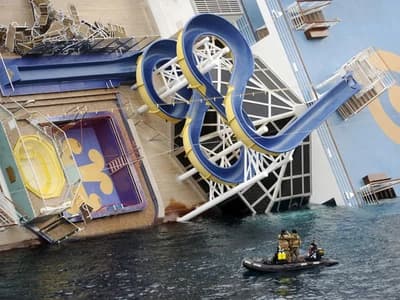
On January 13, 2012, the Costa Concordia cruise ship was wrecked off Giglio Island, Italy. Leaving Civitavecchia in Lazio, the ship, carrying 4,252 people from all over the world, struck a reef during an unofficial salute to local islanders. The Costa Concordia crashed off the Italian island of Giglio on January 13, 2012, killing around 4,252 passengers and crew. A 951-foot cruise liner veered off course and approached too closely.
The impact that ripped a 160-foot gash in the hull led to significant listing and partial sinking.
Despite the ship’s lifeboats, helicopters, and ships, 34 people died in the chaotic aftermath.
Captain Francesco Schettino caused the incident by carelessly deviating from the course. Authorities convicted him of manslaughter and he is currently serving a 16-year prison sentence.
2016’s Ocean Dream
After the owner of the cruise ship went bankrupt in 2015, the Ocean Dream was abandoned without a crew or maintenance personnel at Laem Chabang, Sri Racha, Thailand. In February 2016, the abandoned ship overturned and sank in shallow waters off the coast.
There were unsuccessful attempts to raise the sunken ship. The authorities decided to disassemble and demolish the Ocean Dream on location instead of refloating it. By the end of 2019, the disaster’s visible remnants had been disassembled and salvaged, leaving only the bottom hull of the wreck on the seafloor.
2020’s Orient Queen
The cruise ship Orient Queen suffered terrible damage 1,000 feet away from the big 2020 explosion that tore through Beirut’s dock. The strong blast wave severely damaged the Orient Queen’s hull, which also caused fires to spread, killing two crew members and injuring seven others.
The abandoned cruise ship capsized where it was parked, terminating its 40-year cruise career over the following 48 hours. It was not possible to salvage it.
Related Posts
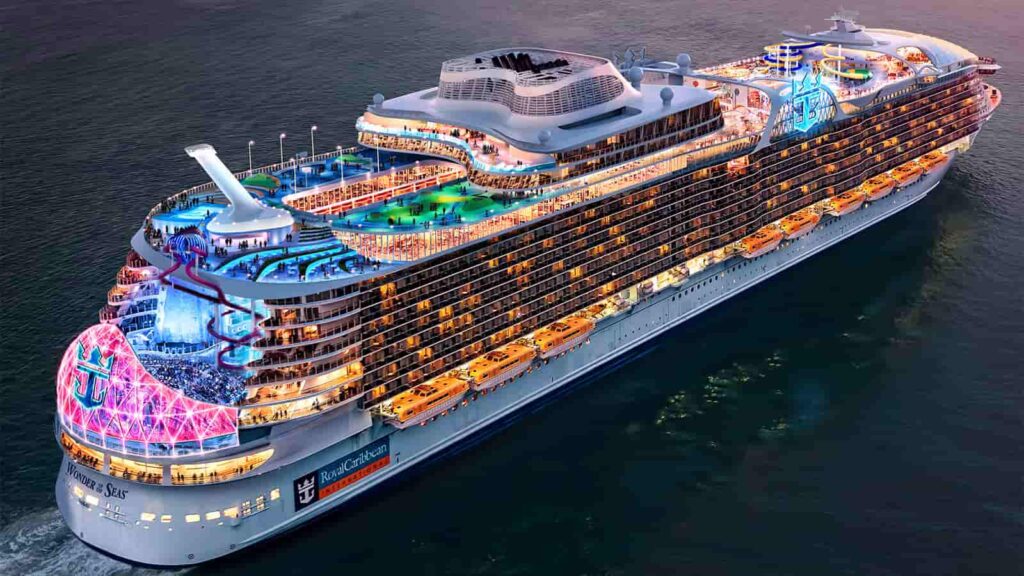
Royal Caribbean Cruises, History, Destinations and Itineraries

Ambassador Cruise Line: Ownership and History
Leave a comment cancel reply.
Your email address will not be published. Required fields are marked *
Save my name, email, and website in this browser for the next time I comment.

How Many Cruise Ships Have Sunk?
- February 15, 2024
- Cruise Ships

Cruising is often seen as the perfect getaway, filled with exciting activities and opportunities for relaxation. It is usually seen as a safe way of traveling, though you still may have wondered: How many cruise ships have sunk?
In the past 100 years, approximately 24 cruise ships have sunk. The causes and impacts of these incidents vary, including wartime activities, accidents, and severe weather conditions. In some cases, ships sank only while being towed.
In modern times, cruise ships rarely sink, thanks to strict safety rules, ship stabilizers, modern technology to help avoid rough seas, and regular practice drills for emergencies. These advancements have significantly improved the safety and reliability of cruise travel, making incidents of sinking exceedingly rare.
Cruise lines have implemented numerous precautions to enhance passenger safety. Advanced weather tracking systems, improved life-saving equipment, and rigorous safety protocols are now standard. Continuous crew training in emergency response and evacuation procedures further ensures that cruising remains one of the safest forms of travel.
But, there have still been some cases where cruise ships have gone down due to bad weather , mistakes by people, or problems with the ship itself.
In this article, we’re going to look at these rare events, talking about how many cruise ships have sunk, what led to these sad moments, and how they’ve helped make cruise ships safer today.
List of Cruise Ships That Have Sunk Throughout History
Here is a list of cruise ships that have sunk throughout history, including ocean liners, as they are considered early versions of modern cruise ships. The list is organized chronologically, from the earliest to the most recent sinkings.
Titanic (1912)
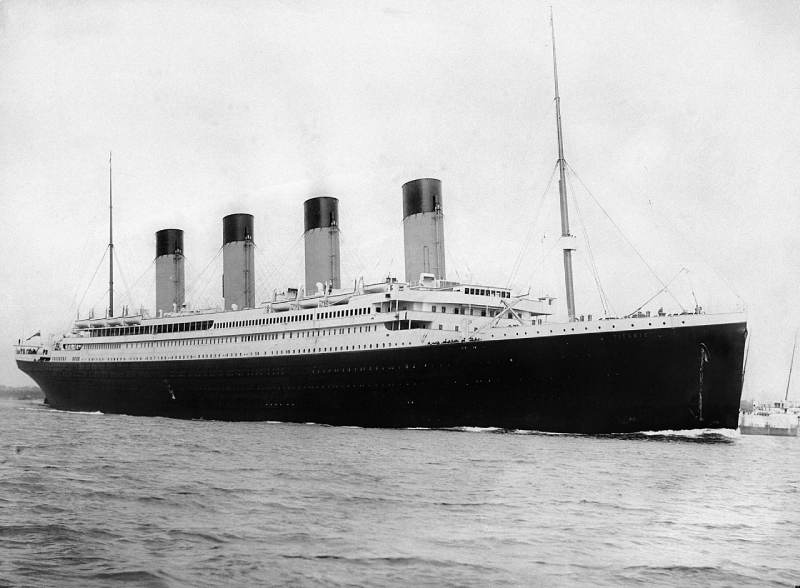
Although not technically a cruise ship in the modern sense, the Titanic was designed to be the largest and most luxurious ship of its time, a hallmark of today’s cruise ships. Its April 1912 inaugural voyage ended in tragedy, and it is now one of the most renowned maritime disasters in history.
On the night of April 14, 1912, four days into its journey from Southampton to New York City, the Titanic struck an iceberg in the North Atlantic Ocean. The collision caused the ship’s hull plates to buckle inwards along its starboard side and opened five of its sixteen watertight compartments to the ocean. Despite being touted as “unsinkable”, the Titanic was fatally damaged. The ship’s design allowed it to stay afloat if two compartments were flooded, but not more. As water spilled from one compartment into the next, the fate of the Titanic was sealed.
The sinking of the Titanic was a horrifying event, marked by acts of heroism and tragic loss. Of the estimated 2,224 passengers and crew aboard, more than 1,500 lost their lives, making it one of the deadliest peacetime maritime disasters in history. The ship also didn’t have enough lifeboats, which made the situation much worse.
The aftermath of the Titanic disaster led to many changes in maritime safety practices. The International Convention for the Safety of Life at Sea (SOLAS) was formed in 1914 to ensure that ships would be equipped with adequate lifeboat space for everyone on board, among other safety measures.
Sinking date: April 14, 1912 Deaths: 1,517 Survivors: 705 Maiden voyage: April 10, 1912 Length: 883 ft. (269 m) Original capacity: 2,453 passengers
RMS Empress of Ireland (1914)
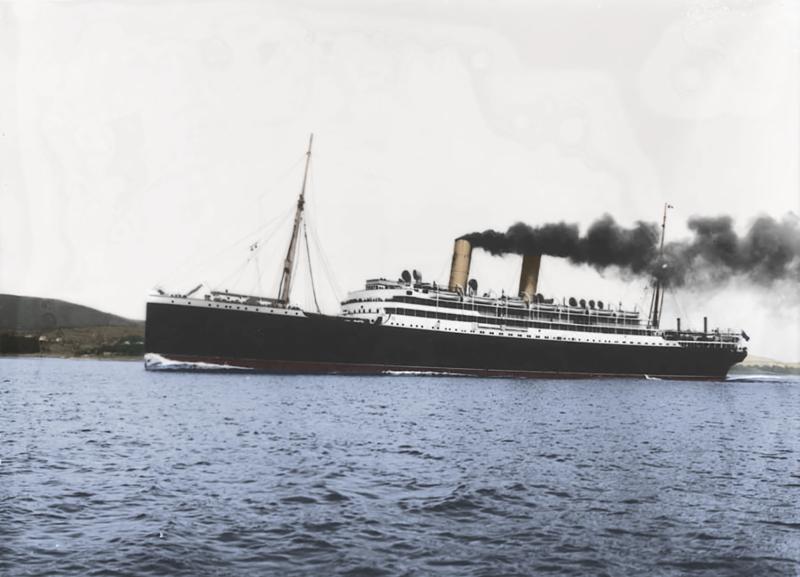
The sinking of the RMS Empress of Ireland is one of the most tragic maritime disasters in history. On May 29, 1914, the Empress of Ireland, a Canadian Pacific steamship, collided with the Norwegian collier SS Storstad in the Saint Lawrence River, near Pointe-au-Père, Quebec, Canada. The Empress was on her 96th transatlantic voyage, heading from Quebec City to Liverpool, England, with 1,477 passengers and crew aboard.
The collision occurred in the early hours, under a thick fog. The Storstad, carrying a load of coal, struck the Empress of Ireland on her starboard side, causing a gaping hole. The impact was devastating; the Empress began to sink rapidly, making many of the lifeboats unusable. Panic ensued as passengers and crew scrambled to escape the rapidly sinking ship. In less than 15 minutes, the Empress of Ireland sank into the cold waters of the Saint Lawrence River, claiming the lives of 1,012 people. Only 465 people survived the disaster.
Sinking date: May 29, 1914 Deaths: 1,012 Survivors: 465 Maiden voyage: June 29, 1906 Length: 574 ft. (175 m) Original capacity: 1,542 passengers
RMS Lusitania (1915)

The RMS Lusitania was a British ocean liner and one of the world’s largest and fastest passenger ships at the time. During World War I, on May 7, 1915, it was sunk by a German U-boat (submarine) off the southern coast of Ireland.
The Lusitania was en route from New York City to Liverpool, England, carrying 1,959 passengers and crew, along with a significant amount of cargo. Despite warnings from the German Embassy, the Lusitania set sail on what would be its final voyage.
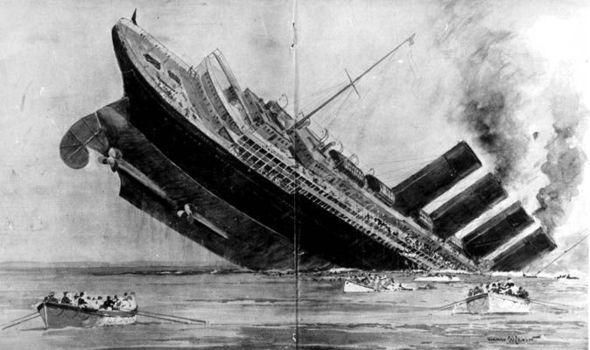
On the afternoon of May 7, the German U-boat U-20 fired a single torpedo at the Lusitania, which struck the starboard side of the ship. The explosion and a second internal explosion caused the Lusitania to sink in just 18 minutes, resulting in the deaths of 1,198 passengers and crew.
The sinking of the Lusitania caused an international outcry, particularly in the United States, where 128 American citizens were among the dead. The German government justified the attack by alleging that the Lusitania was carrying munitions and other contraband, making it a legitimate military target. This claim was partly substantiated.
Sinking date: May 7, 1915 Deaths: 1,197 Survivors: 761 Maiden voyage: September 13, 1907 Length: 787 ft. (240 m) Original capacity: 2,198 passengers
HMHS Britannic (1916)
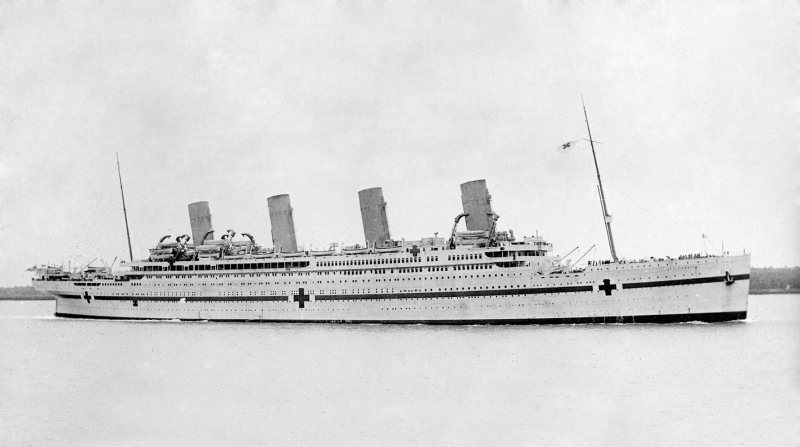
The HMHS Britannic, the third and largest of the Olympic-class ocean liners, was a sister ship of the RMS Titanic and RMS Olympic. Designed with luxury and safety in mind, the Britannic was launched just before the outbreak of World War I and was used as a hospital ship during World War I. It was on a mission to transport wounded soldiers from the Middle East back to Britain when it sank.
On the morning of November 21, 1916, while navigating through the Aegean Sea, near Greece, the Britannic struck a mine believed to have been laid by the German submarine U-73. The explosion caused severe damage to the starboard side of the ship. The Britannic began to flood rapidly and sank within 55 minutes of the explosion.

The evacuation was chaotic. Lifeboats were launched prematurely by panicked crew members, and some were sucked into the ship’s propellers, resulting in many casualties. Despite this, the majority of the 1,066 people on board were saved.
Today, the Britannic remains on its side at the bottom of the Aegean Sea. The wreck was discovered in 1975 by Jacques Cousteau and has since been explored by numerous expeditions. The sinking of the Britannic, while not as well known as the Titanic disaster, remains one of the greatest maritime tragedies of World War I.
Sinking date: November 21, 1916 Deaths: 30 Survivors: 1,036 Maiden voyage: December 23, 1915 Length: 882 ft. (269 m) Original capacity: 489 passengers
MS Georges Philippar (1932)

The MS Georges Philippar was a French ocean liner named after Georges Philippar, a prominent figure in the French shipping industry. The ship was part of the fleet of Messageries Maritimes, a major French shipping company. Its design was cutting-edge for the time, featuring luxurious accommodations and advanced safety features.
On its maiden voyage from Marseille to the Far East, tragedy struck in the Gulf of Aden, near the coast of Yemen. During the night, a fire broke out onboard, quickly spreading through the ship. Despite the crew’s efforts to contain it, the fire overwhelmed the ship’s safety measures. The passengers and crew faced a chaotic and desperate situation as the flames engulfed the liner.
The disaster led to significant loss of life, with many passengers and crew members perishing in the fire or drowning after abandoning ship. Investigations into the sinking of the MS Georges Philippar focused on the cause of the fire, which was believed to have started in a cargo hold, possibly due to improper storage of flammable materials.
Sinking date: May 16, 1932 Deaths: 41 Maiden voyage: May 16, 1932 Length: 543 ft. (165 m) Original capacity: 1,000+
SS Morro Castle (1934)
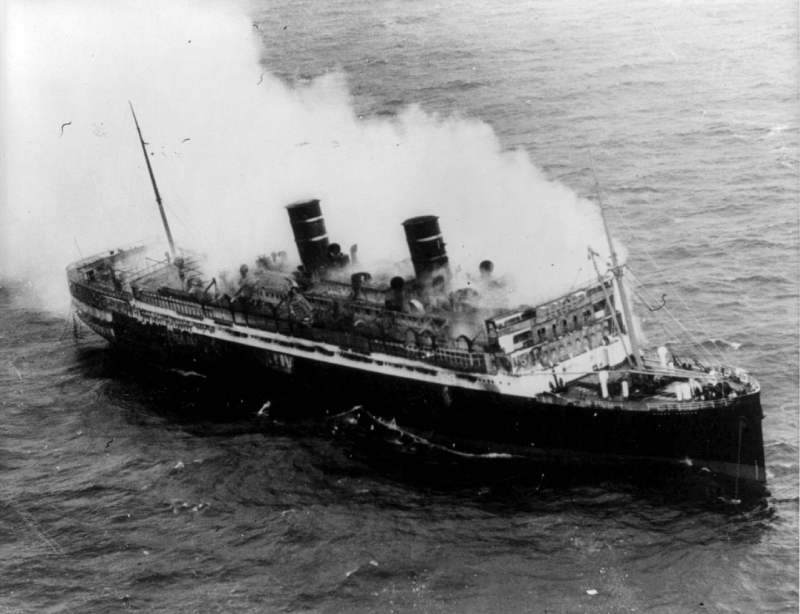
The SS Morro Castle was an American ocean liner that sank on September 8, 1934. The ship, which was named after the Morro Castle fortress that guards the entrance to Havana harbor, was en route from Havana, Cuba, to New York City when it caught fire and burned. This led to the deaths of 137 passengers and crew members out of the 549 people on board.
The fire began in the early hours of the morning under mysterious circumstances. The ship’s highly flammable materials helped the fire spread. The disaster was worsened by a lack of leadership following the death of the ship’s captain, Robert Wilmott, from an apparent heart attack the day before the fire. This left the crew without clear command and coordination, contributing to the chaotic evacuation and rescue efforts.
As the Morro Castle burned, it drifted closer to the shore, eventually grounding itself near Asbury Park, New Jersey. On March 14, 1935, the ship was being towed to a scrapyard when it supposedly sank and was then refloated. Though it is disputed whether or not it really sank.
Sinking date: March 14, 1935 (disputed) Deaths: 137 Survivors: 412 Maiden voyage: August 23, 1930 Length: 479 ft. (146 m) Original capacity: 3
RMS Empress of Britain (1940)
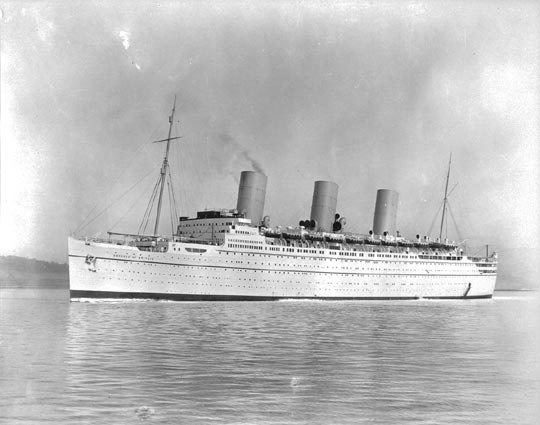
The RMS Empress of Britain, a majestic ocean liner of the early 20th century, met its tragic fate on October 28, 1940. While serving as a troopship during World War II, the vessel was torpedoed by a German U-boat off the coast of Ireland. The sinking of the Empress of Britain remains one of the most significant maritime disasters of any war.
The ship was en route from Liverpool, England, to Halifax, Nova Scotia, carrying nearly 2,000 passengers and crew, including military personnel, civilians, and refugees. In the darkness of the early morning hours, the U-32 fired two torpedoes at the Empress of Britain.
Despite efforts to save the ship, the Empress of Britain began to slowly sink. Within 30 minutes of being hit, the ship succumbed to the icy waters of the North Atlantic, sinking beneath the waves. 45 passengers and crew ended up perishing in the tragedy.
Sinking date: October 28, 1940 Deaths: 45 Survivors: 578 Maiden voyage: May 5, 1906 Length: 761 ft. (232 m) Original capacity: ~800
SS Andrea Doria (1956)

The SS Andrea Doria was an Italian ocean liner that launched in 1951. It was considered a symbol of Italian national pride and post-war recovery.
On the night of July 25, 1956, while en route to New York City from Genoa, Italy, the Andrea Doria collided with the MS Stockholm, a Swedish ocean liner, in heavy fog off the coast of Nantucket, Massachusetts.
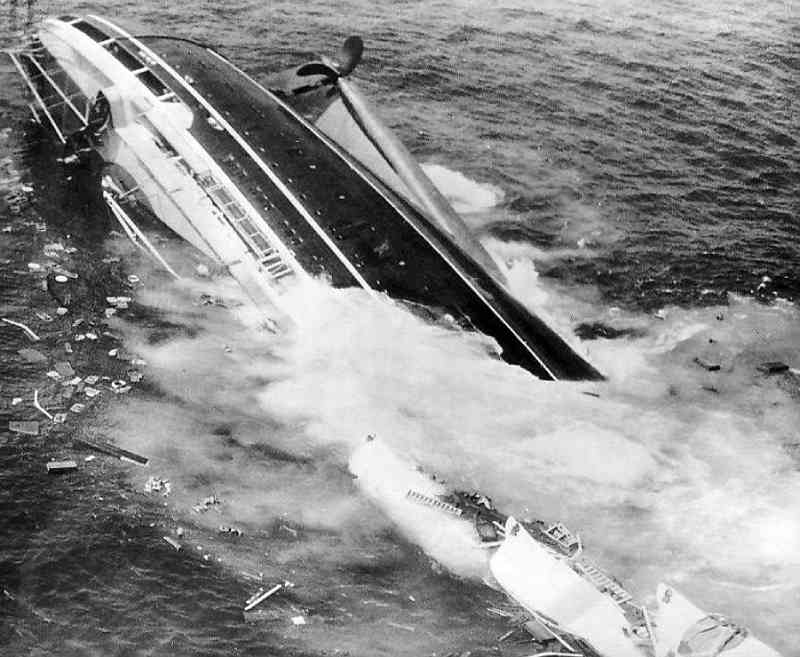
Despite having radar, the ships misinterpreted each other, leading to the catastrophic collision. The impact was devastating, tearing a huge hole in the side of the Andrea Doria and causing it to list severely to starboard.
Thanks to the efforts of the crew, nearby ships, and improved safety standards, nearly all of the Andrea Doria’s passengers and crew were saved. Unfortunately, the ship sank the following morning, about 11 hours after the collision.
Sinking date: July 26, 1956 Deaths: 51 Survivors: 753 Maiden voyage: January 14, 1953 Length: 701 ft. (214 m) Original capacity: 1,241 passengers
Angelina Lauro (1979)

Angelina Lauro, previously known as the MS Oranje, was a Dutch passenger ship that served as a hospital ship during World War II and later as a cruise ship. Launched in 1939 and operated initially by the Netherlands Lines, it was requisitioned by the Australian government during the war.
Post-war, it resumed passenger service, and faced a notable collision in 1953, which severely damaged its bow. The ship was sold to Lauro Lines in 1965 and Costa Lines in 1977. In 1979, while docked in Saint Thomas, U.S. Virgin Islands , a fire led to its total loss. The ship later sank in the middle of a storm while being towed to a scrapyard.
Sinking date: September 24, 1979 Deaths : 0 Maiden voyage: 1939 Length: 656 ft. (200 m) Original capacity: 740 passengers
MS Mikhail Lermontov (1986)

The MS Mikhail Lermontov, originally launched in 1972, was a Soviet ocean liner that was converted into a cruise ship. On the 16th of February, 1986, the MS Mikhail Lermontov had a tragic accident that led to its sinking.
While navigating the Marlborough Sounds in New Zealand, under the guidance of a local pilot, the ship struck rocks near Cape Jackson. The impact tore open the hull, and the MS Mikhail Lermontov sank within hours. At the time of the disaster, the cruise ship was carrying hundreds of passengers and crew on a cruise from Sydney, Australia, to New Zealand.
After the MS Mikhail Lermontov sank in 1986, both New Zealand and Soviet investigators looked into the accident and found that the pilot, Captain Don Jamison, was at fault. They pointed out that he chose a risky path that was too shallow. The investigators questioned his judgment, with a New Zealand official stating, “why he decided to guide the ship over a passage that he actually knew was too shallow, I don’t think he’ll ever be able to answer.”
Sinking date: February 16, 1986 Deaths: 1 Maiden voyage: May 28, 1973 Length: 578 ft. (155 m) Original capacity: 1,334 passengers
MV Jupiter (1988)
The MV Jupiter was a Greek-registered cruise ship that tragically sank on October 21, 1988, just 40 minutes after leaving the port of Piraeus, Greece. This ship was originally launched on February 19, 1961, as Moledet, serving the Zim Israel Navigation Company Ltd before being sold to Epirotiki Line in September 1970 and renamed Jupiter.
On the fateful day, the Jupiter had 391 British schoolchildren and 84 adults on a study cruise, along with a crew of 110 on board. The disaster resulted in the deaths of one pupil, one teacher, and two Greek crew members. The sinking occurred after the Jupiter collided with the Italian freight ship Adige, which tore a hole in the ship, causing it to sink.
Sinking date: October 21, 1988 Deaths: 4 Maiden voyage: March 19, 1974 Length: 218 ft (66 m) Original capacity: 531 passengers
MTS Oceanos (1991)
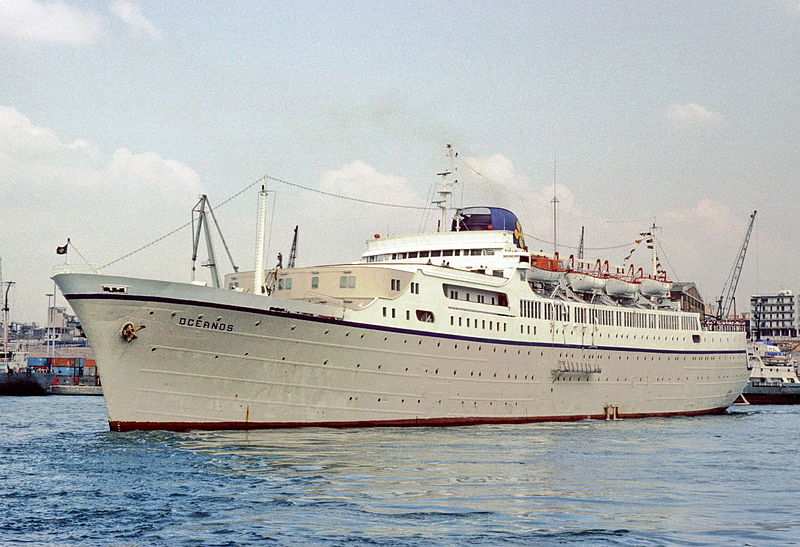
The MTS Oceanos was a Greek-owned cruise ship that was launched in 1952. On August 4, 1991, the ship became flooded and sank in severe weather off South Africa’s eastern coast.
The Oceanos set out from East London, South Africa, heading towards Durban, carrying 571 passengers and crew. The ship encountered rough seas and strong winds as it sailed along the Wild Coast. The disaster began to unfold when a leak in the engine room led to the failure of the power systems, leaving the ship without pumps to remove incoming water.
As the situation worsened, the ship’s captain abandoned the ship. This act of cowardice became one of the most talked-about aspects of the disaster. Fortunately, the entertainment staff, led by guitarist Moss Hills, took charge of the evacuation, proving instrumental in coordinating the rescue efforts. They used the ship’s radio to make distress calls, which were answered by nearby ships and helicopters.
The rescue operation was remarkable for its success under adverse conditions. All 571 people on board were saved, with no loss of life, thanks to the efforts of the South African Air Force and a Dutch cargo ship.
Sinking date: August 4, 1991 Deaths: 0 Survivors: 571 Maiden voyage: 1953 Length: 502 ft. (153 m) Original capacity: 550 passengers
MS Achille Lauro (1994)

The MS Achille Lauro was an Italian ocean liner most notorious for its hijacking by the Palestine Liberation Front in 1985. The ship met a tragic end when it sank in 1994 in the Indian Ocean. Originally built in 1947 as the MS Willem Ruys by the Royal Rotterdam Lloyd, it was named after Achille Lauro, an Italian businessman and politician, when it was purchased by the Lauro Line in 1965. The ship had an eventful career, serving as both a passenger liner and a cruise ship, traveling to many destinations around the world.
The end of the MS Achille Lauro came on November 30, 1994, while it was sailing off the coast of Somalia in the Indian Ocean. A fire broke out in the engine room and spread throughout the ship. Following the evacuation, the fire continued to rage uncontrollably, and the ship eventually succumbed to the damage.
The MS Achille Lauro eventually sank on December 2, 1994. Thankfully, most of the passengers and crew were evacuated safely, though the tragedy resulted in the loss of two lives.
Sinking date: December 2, 1994 Deaths: 2 Maiden voyage: December 2, 1947 Length: 630 ft. (192 m) Original capacity: 900 passengers
Sun Vista (1999)

The Sun Vista, originally an ocean liner named the SS Galileo Galilei, was a cruise ship that met its fate on May 20, 1999. The ship was in the Strait of Malacca, near Malaysia, when a fire broke out in the engine room. Despite efforts to control the fire, it spread rapidly throughout the ship.
The evacuation process involved more than 1,000 passengers and crew members, who had to abandon the ship and were rescued by lifeboats. The operation was carried out under challenging conditions but, fortunately, resulted in no loss of life.
Following the evacuation, the Sun Vista eventually sank in the early hours of May 21, 1999. The sinking of the Sun Vista was a significant loss in the cruise industry, marking the end of a ship that had served for almost 40 years.
Sinking date: March 23, 1963 Deaths: 0 Survivors: 1,090 Maiden voyage: May 21, 1999 Length: 702 ft. (214 m) Original capacity: 1,750 passengers
MS World Discoverer (2000)

The MS World Discoverer was a small cruise ship designed for navigating through polar waters, offering its passengers the unique experience of exploring some of the most remote areas of the world. Built in 1974 by Schichau Unterweser in Bremerhaven, West Germany, the ship was initially named BEWA Discoverer and was later renamed World Discoverer to reflect its mission of global exploration. The ship had a double hull, so it could safely navigate through ice-packed regions.
On April 30, 2000, the World Discoverer struck an uncharted reef in the Sandfly Passage, a narrow stretch of water in the Solomon Islands. The impact caused severe damage to the ship’s hull, leading to the immediate risk of sinking. The captain managed to beach the vessel nearby reef to prevent it from completely sinking and helped evacuate the passengers and crew.
Following the partial sinking, the MS World Discoverer became a subject of salvage operations. However, due to the remote location and the difficulty in accessing the wreck, the ship was never fully salvaged and remains stranded at Roderick Bay of the Nggela Islands, with a 46 degree tilt.
Sinking date: April 30, 2000 Deaths: 0 Maiden voyage: 1973 Length: 289 ft. (88 m) Original capacity: 137 passengers
MS Sea Diamond (2007)

The MS Sea Diamond was a cruise ship that sank off the coast of Santorini, Greece, in April 2007, leading to the deaths of 2 people. The incident occurred when the ship struck a reef and began taking on water. Despite efforts to control the flooding, the ship was evacuated within hours of the collision. The evacuation process, although chaotic, was largely successful, with most passengers and crew being safely transferred to rescue boats and taken to the island.
Two passengers, a Frenchman and his daughter, were reported missing and later presumed dead, marking a somber note in the otherwise successful evacuation effort. The loss of lives cast a shadow over the incident and led to questions about the ship’s safety procedures. The Greek authorities later launched an investigation into the causes of the sinking.
The sinking of the MS Sea Diamond caused severe environmental pollution. The ship contained large quantities of fuel and hazardous materials, posing a serious threat to marine life in the area. There were some efforts to contain and mitigate the environmental impact, though it’s not certain how effective they were.
Sinking date: April 5, 2007 Deaths: 2 Survivors: Over 1,590 Maiden voyage: April 22, 1986 Length: 469 ft. (143 m) Original capacity: 1,537 passengers
MV Explorer (2007)
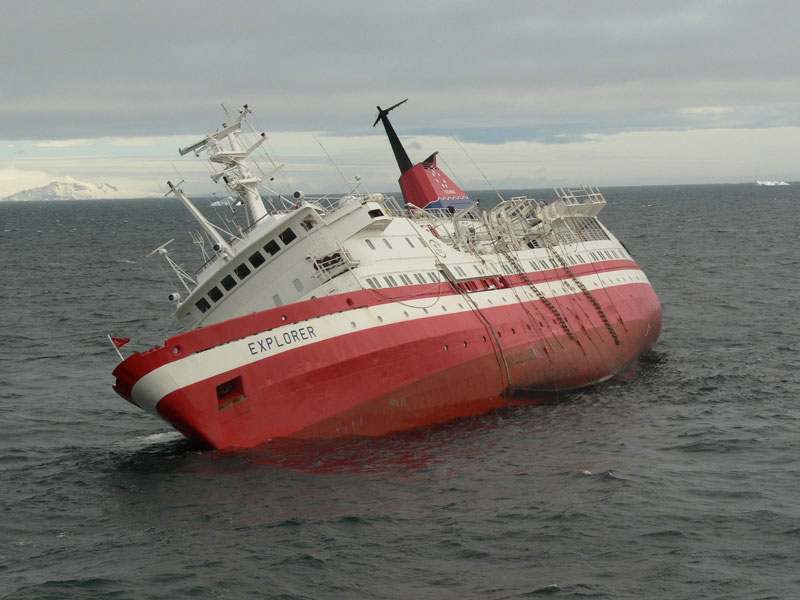
The MV Explorer, a Liberian-registered cruise ship built in 1969, gained infamy for its sinking in 2007 under dramatic circumstances. This vessel wasn’t an ordinary cruise ship; it was specifically designed for educational voyages in the Antarctic Ocean.
On November 23, 2007, the MV Explorer encountered trouble in the Bransfield Strait near the South Shetland Islands. The ship struck an iceberg, causing a fist-sized hole in the hull and leading to rapid flooding and the sinking of the ship. Despite the crew’s efforts to manage the situation, the damage was irreparable, and the decision was made to abandon ship. Remarkably, all the passengers, crew, and guides were saved. They waited for hours in the lifeboats until they were rescued by the Norwegian cruise ship MS Nordnorge.
The sinking of the MV Explorer serves as a stark reminder of the unpredictable nature of sea travel, especially in the perilous and icy waters of the Antarctic. The Liberian Bureau of Maritime Affairs carried an investigation into the sinking in 2009. The report found that there might have been an underestimation of the risks posed by icebergs in the vessel’s path.
Sinking date: November 23, 2007 Deaths: 0 Survivors: 154 Maiden voyage: 1969 Length: 239 ft. (73 m) Original capacity: 104 passengers
Costa Concordia (2012)
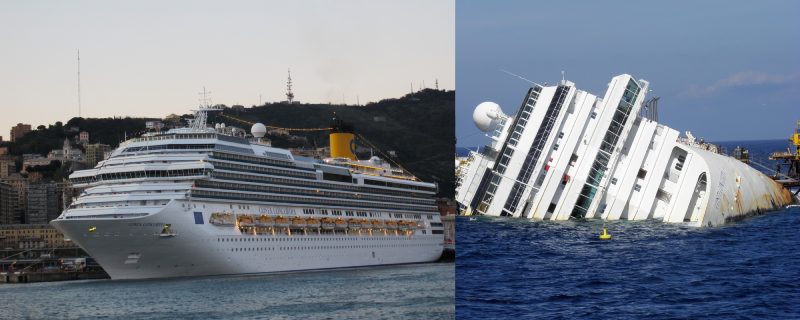
Perhaps the most well-known modern day maritime disaster is the partial sinking of the Costa Concordia. The large cruise ship struck a rock off the coast of Isola del Giglio, Italy, during a maneuver close to the island. This resulted in a large, 160 ft. (50 m) gash in its hull. The Costa Concordia then began to take on water and eventually tilted on its side, leading to a chaotic and panicked evacuation process.
The disaster resulted in the deaths of 32 people, who lost their lives due to various causes, including drowning and injuries sustained during the evacuation. Despite the tragic loss of life, there were many survivors, with over 4,200 people managing to escape the sinking ship. This included passengers from around the world and crew members, who faced harrowing conditions as they sought to flee the tilting vessel.
The captain of the Costa Concordia, Francesco Schettino, was heavily criticized for his actions during and after the collision. He was accused of bringing the ship too close to the shore in a maneuver known as a “salute,” and then abandoning the ship before ensuring that all passengers and crew were safely evacuated. His actions led to criminal charges, including manslaughter.
The ship remained partially submerged off the coast of Giglio for more than two years before a complex salvage operation successfully re-floated the ship so it could be towed away for scrapping.
Sinking date: January 13, 2012 Deaths: 32 Survivors: Over 4,200 Maiden voyage: July 14, 2006 Length: 951 ft. (290 m) Original capacity: 3,700 passengers
Oriental Star (2015)
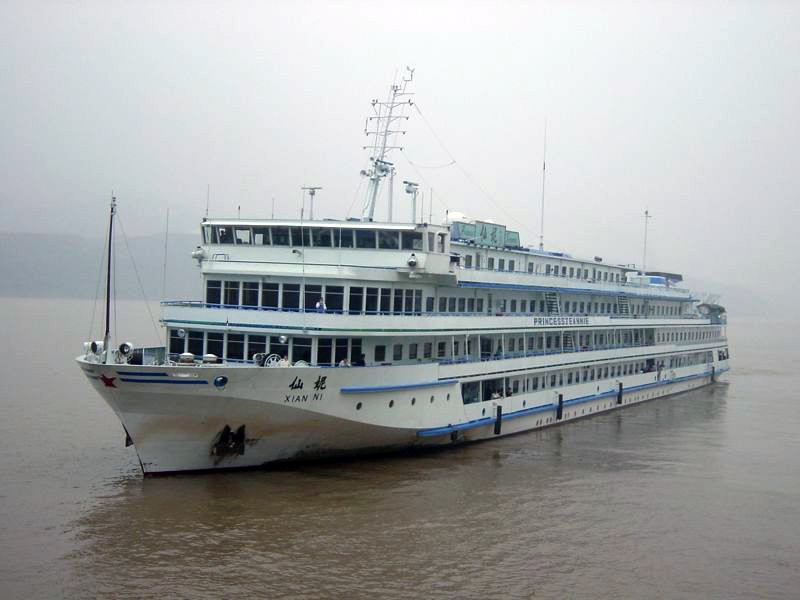
The sinking of the Oriental Star, also known as the Eastern Star, remains one of the most tragic cruise ship sinkings in recent times. On the evening of June 1, 2015, the Oriental Star was cruising through the waters of the Yangtze River in China when disaster struck.
As the cruise ship navigated the Yangtze River, it encountered a severe storm, including torrential rain and strong winds. These extreme weather conditions caused the ship to capsize suddenly, catching its passengers and crew off guard.
The Oriental Star, which was carrying 456 people onboard, mostly elderly tourists, was overwhelmed by the force of the storm. Within minutes, the ship had turned completely on its side, leaving only a small portion of its hull visible above the water. At the time of the sinking, most of the crew and passengers were asleep. Rescue efforts were immediately launched, with emergency responders and local authorities trying their best to save as many lives as possible.
Tragically, the majority of those onboard the Oriental Star did not survive the disaster. Only 12 passengers and crew members were rescued in the hours and days following the sinking. The final death toll numbered 442, making it one of the deadliest cruise ship sinkings in history.
After the sinking, Chinese authorities launched an investigation to find the cause and see if anyone was at fault. In the end 43 people were punished, though the Chinese media heavily censored the event so many details are unknown.
Sinking date: June 1, 2015 Deaths: 442 Survivors: 12 Maiden voyage: February 1994 Length: 251 ft. (76.5 m) Original capacity: 534 passengers
Orient Queen (2020)
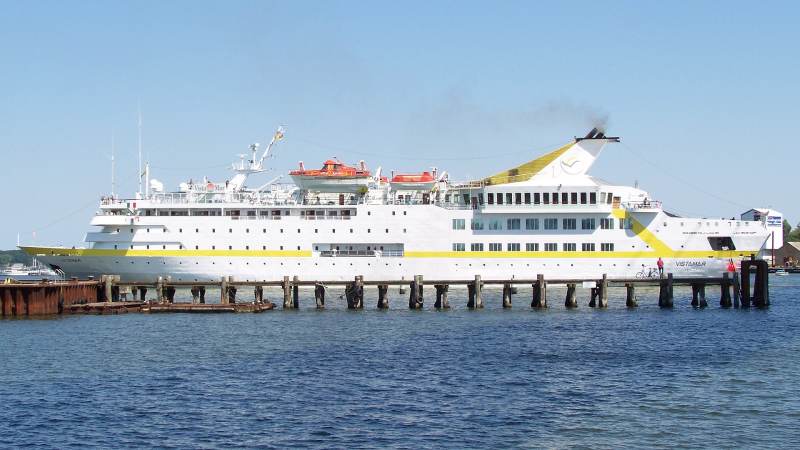
The Orient Queen was a cruise ship owned by Abou Merhi Cruises, under which it sailed primarily in the Eastern Mediterranean. The tragic sinking of the Orient Queen occurred in August 2020, as a direct consequence of the massive explosion in the port of Beirut.
On the 4th of August, a large quantity of ammonium nitrate stored at the port detonated, resulting in one of the most powerful non-nuclear explosions in history. The blast caused widespread damage throughout the city of Beirut, killing over 200 people, injuring thousands, and causing extensive property damage.
The Orient Queen, which was moored in the port of Beirut at the time of the explosion, suffered severe damage due to the shockwave and the subsequent flooding. The impact of the explosion was so significant that it led to the ship partially sinking. The event resulted in the loss of two lives among the crew members aboard the ship. The explosion also damaged other ships nearby..
Sinking date: June 27, 2020 Deaths: 2 Maiden voyage: 1989 Length: 423 ft. (129 m) Original capacity: 300 passengers
How Many Cruise Ships Have Sunk? – FAQ
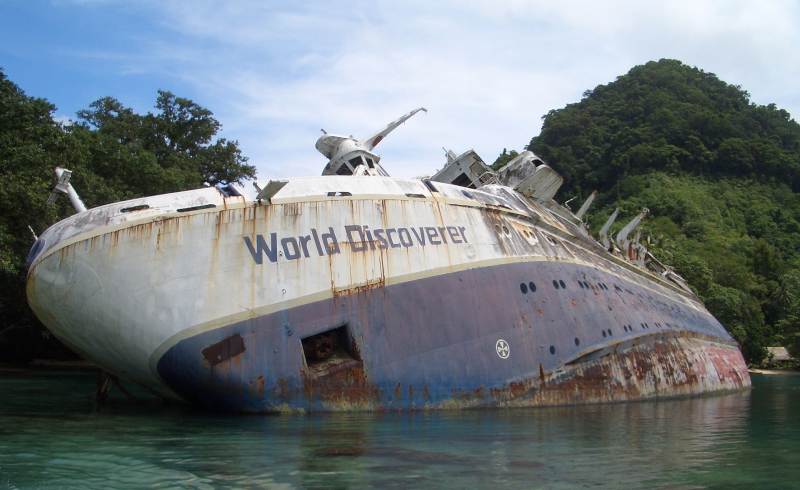
When was the last time a cruise ship sank?
The last recorded sinking of a cruise ship was the Orient Queen in 2020. The ship sank as a result of the massive explosion that occurred in the port of Beirut, Lebanon, on August 4, 2020. This tragic event was caused by the detonation of a large quantity of ammonium nitrate stored at the port.
The blast was so powerful that it caused significant damage across a large portion of the city, including the port area where the Orient Queen was docked. The force of the explosion inflicted critical damage to the vessel, ultimately leading to its sinking.
What are the odds of a cruise ship sinking?
The odds of a cruise ship sinking are approximately 1 in 273,000, or about 0.00037%, indicating an extremely low probability. This calculation is based on the assumption of 300 cruise ships each conducting 50 sailings annually over the last 50 years, with only 11 ships sinking during this period.
Despite the significant number of sailings—amounting to 750,000 over half a century—the safety record of cruise travel remains exceptional, emphasizing the rarity of such incidents amidst the millions of passenger experiences.

Why don’t cruise ships sink?
Cruise ships are designed with buoyancy and stability in mind, allowing them to float despite their massive size. This is primarily due to their hulls, which are large and hollow, creating a displacement effect that pushes water away, ensuring that the weight of the water displaced is equal to or greater than the weight of the ship. This principle, known as Archimedes’ principle, is key to keeping ships afloat.
Additionally, cruise ships are compartmentalized into watertight sections, which can be sealed off in the event of a breach in the hull, preventing water from filling the entire ship and maintaining buoyancy. Modern cruise ships also incorporate advanced stability technologies and are meticulously designed and tested to ensure they remain upright and stable, even in rough seas.

What was the largest cruise ship that sank?
The Costa Concordia is considered the largest cruise ship to have capsized and sunk. This tragic event occurred on January 13, 2012, when the ship struck a reef off the coast of Isola del Giglio, Italy, leading to a significant breach in its hull. The ship eventually partially sank near the island’s shore. At the time of the incident, the Costa Concordia was among the largest cruise ships in operation, measuring about 114,500 gross tons, with a length of 952 feet (290.20 meters) and a capacity to carry 4,232 passengers and crew.
Final Words
Cruise ship sinkings are very rare, especially considering the vast number of ships that sail the world’s oceans every year.
The cruise industry has seen significant advancements in technology and the implementation of strict safety protocols. These measures, coupled with international regulations, contribute to making cruising a safe form of travel.
Modern ships are equipped with state-of-the-art navigation systems, emergency response procedures, and construction standards that exceed what was available in the past. So these days, the chance of your cruise ship sinking is extremely low.
Adam Stewart
Adam Stewart is the founder of Cruise Galore. He is a passionate traveler who loves cruising. Adam's goal is to enhance your cruising adventures with practical tips and insightful advice, making each of your journeys unforgettable.

- Privacy Policy
A Comprehensive List of Sunk Cruise Ships and Their Maritime Tales

Introduction
Imagine setting sail on a luxurious cruise ship, ready to embark on a once-in-a-lifetime adventure. The salty sea breeze in your hair, the sun glistening on the horizon, and the promise of adventure on the high seas.
For many of us, a cruise vacation represents the epitome of leisure and luxury. However, lurking beneath the surface of this perfect image is a fascinating and, at times, unsettling history of cruise ships that have met an unfortunate fate.
Don’t worry, it’s an extremely unusual incident, and even if it does occur, this era’s safety systems ensure that most, if not all, passengers and crew are entirely safe.
While cruising is considered one of the safest modes of travel, the chronicles of maritime history are sprinkled with stories of shipwrecks, lost treasures, and unsolved enigmas.
Has a cruise ship ever gone down?
You would love to know that thankfully, very few cruise ships have actually sunk in modern history. Today’s cruise ships are designed to endure severe weather.
Furthermore, cruise lines actively monitor the weather in order to avoid storms wherever feasible. Having said that, you’ve probably wondered how many cruise ships have sunk at some point.
If river cruise ships and ocean liners are included, around 20 or more cruise ships have sunk over our recent 100 years of history.
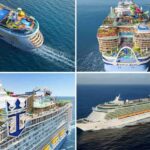
Arranging Royal Caribbean Ships: From Newest to Oldest
Carnival cruise director’s schedule for 2024-2025, carnival cruise ships ranked by size along with visual comparison chart.
We will be looking at some of the incidences and to your surprise, almost over 2,000 people have died in these occurrences, with ships sinking before 1940 accounting for more than half of the deaths. Many of the occurrences resulted in no deaths.
Let’s check out the list of sunken masters of the waters.
1. April 1912, Titanic
The Titanic’s sinking became a headline not for its cinematic adaptation but stands out as one of the deadliest as it accounted for over 1500 deaths.
On her maiden voyage across the Atlantic, she collided with an iceberg that resulted in a tragic incident. The deadliest maritime tragedy was caused by to insufficient number of lifeboats for the passengers.
In addition, there was a limited chance of survival for those without lifeboats in the waters where the ship went down. This haunting story taught a lesson emphasizing the value of safety precautions when sailing.
2. May 1914, Empress of Ireland
Two years after the Titanic’s tragic sinking, a similar incident happened in May 1914. The ship called Empress of Ireland with 1500 passengers, collided with the Norwegian ship Storstad. Despite sighting each other, dense fog made it worse for them.
1,012 passengers and crew members died in this horrific tragedy, and the Empress of Ireland was sadly only four journeys away from making its 1,000 successful voyages.
The story of this ill-fated liner serves as a reminder of the dangers and uncertainties that travelers and sailors can encounter on the high seas.
3. May 1915, Lusitania
The Lusitania, a cruise ship launched by Cunard Line in 1906, once held the prestigious title of the world’s largest passenger ship. However, its fate took a tragic turn during World War I.
For nine successful years, the Lusitania completed 201 transatlantic journeys. Yet, on its 202nd voyage from New York to Liverpool, disaster struck when a German U-boat torpedoed the ship off the southern coast of Ireland.
The ferocity of the explosion and the rapid tilting of the ship allowed for only six lifeboats to be launched. As a result, 1,198 passengers and crew members lost their lives, while 764 fortunate individuals managed to survive.
The sinking of the Lusitania remains a black chapter in maritime history, a poignant reminder of the perils faced during wartime travel on the high seas.
4. November 1916, Britannic
Originally intended to be a passenger ship, the Britannic, one of the Olympic Class ocean liners operated by White Star Line, was converted into a hospital ship during World War I.
A German naval mine in the Kea Channel caused tragedy in November 1916, as the ship sank in under 55 minutes. About thirty people were casualties, although most passengers got out alive.
5. October 1927, Principessa Mafalda
Built in 1909 and named for Princess Mafalda of Savoy, the Italian cruise ship Principessa Mafalda suffered tragedy in 1927.
The ship sustained structural damage when it sank while traveling between Argentina and Italy as a result of a major propeller shaft failure. Sadly, 314 of the 1,252 passengers and crew members who were involved in the tragedy died.
6. June 1931, Saint-Philibert
In 1931, tragedy struck when a tiny cruise ship collapsed and drowned off the coast of France, killing nearly 500 people and leaving only eight survivors. The ship ran summertime cruises along the French coast before the catastrophe.
The accident was caused by a number of things, including overloading the aircraft with twice as many people on board as was planned and extremely inclement weather.
7. May 1932, Georges Philippar
A modern French ocean liner tragically sank on its inaugural voyage because of an electrical problem. Faulty high-voltage wiring and a broken light switch caused a fire that killed 54 people.
To avoid delays in construction, quality concerns about the vessel were ignored. Improved onboard electrical safety measures were put in place after the event, including installing more dependable circuit breakers and switching to a different current type.
8. 1934 , SS Morro Castle
The SS Morro Castle was launched in 1930 and was designed especially to make regular sailings between the US and Cuba.
However, due to a tragic incident in 1934, the ship sank due to a fire caused by the electrical cables and hydraulic lines used for steering the ship.
In this accident,137 people lost their lives and the crew was blamed who handling the emergency badly.
9. October 1940, Empress of Britain
Two phases of the great ocean liner Empress of Britain’s death occurred during World War II. After being attacked from above on October 26, German U-boats sunk it on October 28.
Thankfully, 416 crew members, 2 gunners, and 205 passengers—the majority of the passengers and personnel—all safely escaped the vessel. Still, 45 people lost their lives in the catastrophe.
10. July 1956, Andrea Doria
Even though it was tragic, the Andrea Doria accident brought to light important improvements in ship safety since the Titanic accident. It listed on one side after hitting Stockholm, making it more difficult to approach the lifeboat.
But as the ship sank gradually, the crew was able to use their improved communication and rescue skills to save 1,660 passengers and crew members. The next day’s sinking was not the cause of the casualties; rather, it was the collision.
11. October 1961, Bianca C
Because the Bianca C sank twice, it has a special place in nautical history. During World War II, German soldiers destroyed the passenger ferry that it was originally intended for.
Following its salvage, Costa Line—the forerunner of Costa Cruises—refurbished it and gave it the new name Bianca C.
But calamity struck again in 1961, this time due to an explosion in the engine room that caused it to sink again. Thankfully, everyone on board survived the incident save for one crew member.
12. 1979 September, Angelina Lauro
With a storied past, the Angelina Lauro began service as a passenger ferry in 1939 and later became a hospital ship during World War II. It was reborn as a cruise ship in 1972.
But tragedy struck in 1979 when it caught fire in Saint Thomas port, while Costa Lines was in charge. Days passed with no casualties, but the ship was declared irreparable. Then, on the way to a scrapyard, it capsized fatally.
13. February 1986, MS Mikhail Lermentov
In 1982, the large ship MS Mikhail Lermentov, which was owned by the Soviet Union’s Baltic Shipping Company, became a cruise liner.
Tragic events occurred in 1986 while on a two-week exploration cruise from Sydney to Cape Jackson, which is close to Wellington.
Not about twenty minutes after the last passenger was saved, the ship completely sank, despite the quick response that saw the majority of the 372 passengers and 348 crew members evacuate into lifeboats. Pavel Zagladimov was sadly the only crew member to die in the tragedy.
14. August 1986, SS Admiral Nakhimov
The ship’s incredible history includes three separate sinkings! It was submerged and eventually came into the possession of the Soviet Union after being used by the Nazis as a hospital ship during the war.
The ship sank again in spite of attempts to raise it, only to rise again. 423 of the 1,234 people on board perished in the collision with a freighter that occurred in 1986 while it was conducting cruises in the Black Sea.
15. August 1991, MTS Oceanos
Three years after the MV Jupiter catastrophe, which claimed four lives, the Greek ship MTS Oceanos met her awful end in 1991.
The ship sank as a result of excessive water entering the vessel from suddenly big waves breaking a badly fitted pipe. Thankfully, all 581 passengers and the crew made it out alive.
The entertainers warned and helped guests to safety, however, the captain and a few other crew members were judged to be at fault for leaving the ship.
16. December 1994, Achille Lauro
Before joining MSC Cruises, the MS Achille Lauro was originally ordered by a Dutch business. The trip was turbulent and filled with catastrophes like fire, explosions, and hijacking.
Tragically, it caught fire and sank off the coast of Somalia on December 2, 1994. Two people lost their lives during the evacuation, which involved 979 passengers and crew members.
17. May 1999, Sun Vista
Before changing her name to Sun Vista in 1997, the ship was operated by Celebrity Cruises for seven years under the name SS Galileo Galilei.
Two years later, tragically, an engine room fire caused it to sink, leaving all power disconnected.
Thankfully, all 1,090 passengers and crew members disembarked safely and without incident thanks to contemporary safety requirements.
18. October 2000, Britanis
In 2000, the British transferred ownership of the vessel from Chandris Lines to AG Belofin Investments with the goal of dismantling it in India.
But as it traveled, it started to listen and absorb water. The only option was to let it capsize and sink off the coast of Cape Town since there was no personnel on board to deal with the problem.
19. 2000 , SeaBreeze
The SeaBreeze was launched in 1958 and is owned by Costa Cruises primarily. Later the ownership was transferred to Premier Cruises in 1983.
In the year 2000, the ship sank due to the breaking off boiler that caused sufficient damage to sink the ship.
As per reports, it is believed that it was an intentional incident to claim for insurance money and had received $20 million as compensation. When the ship sank, only 34 crew members were on board and all were rescued.
20. April 2007, MS Sea Diamond
After twenty years of service, the MS Sea Diamond—originally ordered by Birka Line as the Birka Princess—was transferred to Louis Hellenic Cruise Lines. But catastrophe struck in 2007 when it became stuck on the rocks of Santorini.
Even though it was later found that incomplete charts had contributed to the tragedy, the captain still had to deal with the fallout.
Although more than 1,000 passengers and crew members were amazingly saved, the loss of two French passengers—who are believed to be dead—remains a sobering reminder of the human cost of the ordeal.
21. 2007 , MV Explorer
The MV Explorer was a small cruise ship launched in 1969 and had many owners till her last date. in her life, launching first in 1969.
She became the first cruise ship specifically that went across Antarctic Ocean. Unfortunately it also became the first ship to sink there too.
In 2007, it collided with an iceberg and 91 passengers, 54 crew and 9 expert guides had to take lifeboats to save their lives. After five hours of the nightmare everyone was rescued by the MS Nordnorge.
22. January 2012, Costa Concordia
Frequently compared to its historical forerunner, the Titanic, the Costa Concordia represents a contemporary symbol of maritime catastrophe.
After the ship sank because it sailed too close to Tuscany, 34 people died—passengers, crew, and members of the salvage team—out of the 4,252 people that were on board, the majority of them were more than 3,200 passengers.
The captain, Francesco Schettino, was found guilty and sentenced to sixteen years in prison for the fatal incident.
23. June 2015, Eastern Star
A Chinese river cruise ship called “Dongfang Zhi Xing” operated on its usual course down the Yangtze River until an unfortunate incident occurred in 2015.
It was destroyed by a strong storm while traveling from Nanjing to Chongqing, foundering in shallow water that was just 15 meters deep.
Only 12 of the 456 people on board made it through the ordeal; the remaining 442 passengers and crew perished. The passengers, who were mostly old, faced immediate disaster when the ship quickly capsized.
Better severe weather communication procedures were consequently put in place for river excursions, and the Chinese government found that 43 people were held accountable for management carelessness.
24. February 2016, Ocean Dream
There is nothing like the history of the Ocean Dream. Norwegian Cruise Line had originally ordered the Seaward, but due to building issues, the purchase was canceled.
The ship was later purchased by P&O, who renamed it the Spirit of London. It sailed the world under different names and ownerships.
It finally met its demise in 2016, drowning in Thailand following a year of abandonment. Fortunately, no one was hurt in the incident.
25. August 2020, Orient Queen
The Abou Merhi Group in Lebanon owned the Orient Queen, which sailed from Beirut to explore the enchanted eastern Mediterranean, including stops in Turkey and Greece.
Sadly, in 2020, the ship sank while parked in port due to a massive explosion caused by ammonium nitrate that rocked the port.
Sadly, the event claimed the lives of two crew members. Orient Queen was the only cruise liner to sink, however, several other vessels in the port suffered damage.
Set out on an elegant cruise journey, where you are set for amazing adventures as the sun shines down on the horizon and the ocean breeze tousles your hair.
Although cruising is associated with the epitome of luxury and leisure, it has an intriguing and often unsettling past.
Modern safety precautions guarantee the safety of both passengers and crew, even in the rare event of an accident.
Maritime mythology abounds with stories of shipwrecks, missing wealth, and mysteries, even though cruises are still one of the safest modes of transportation.
For those of you who may have been scared about setting foot on a cruise ship, take heart. The numbers reveal that ship sinkings are exceedingly uncommon, and robust safety measures stand as stalwart protectors.
With these reassurances, you’re now free to embark on a splendid cruise holiday without a worry in sight.
FAQ’s
1. what is the probability of a cruise ship to sink.
Ans – The probability of a sinking ship is very low. In the last 50 years, 11 cruise ships sank while on a voyage. It is neither easy nor accurate to predict this condition.
2. What is the reason behind cruise ship not sinking?
Ans – The way these ships are built they are meant to remain upright and the inbuilt ballast tanks protects the ship from sinking.
The advanced navigation systems and safety mechanisms, along with expert and trained crew has made the journey on cruise safe and fear free.
Get Cruise-Smart! Join our Crew for Tips, Tricks, and Sea-sational Tales. Subscribe Now!
Email address
Trending Topics
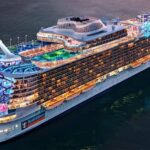
Royal Caribbean Ships from best to worst
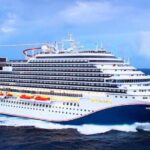
Carnival Cruise Director’s Schedule for 2024-2025
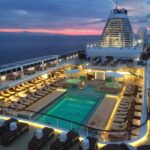
How Expensive Is Cruise Travel?

The Meaning Behind Pink Flamingos

Sign in to your account
Username or Email Address
Remember Me
How Many Cruise Ships Have Sunk in the Past 100 Years?
Home » How Many Cruise Ships Have Sunk in the Past 100 Years?
Last updated on January 11th, 2024 at 10:24 am
Cruises are one of the safest options for vacations, but in the past 100 years there have been some incidents with cruise ships sinking . Here are some notable ones in the past 100 years.
Titanic (1912) The most famous cruise ship sinking in history, the Titanic sank after colliding with an iceberg.
Empress of Ireland (1914) This large passenger liner sank after colliding with a Norwegian cargo ship, the Storstad, during foggy weather.
Lusitania (1915) For a few months before her sinking, the Lusitania was the largest passenger ship in the world. A casualty of WWI, she was hit by a torpedo from a German U-boat off the south coast of Ireland.
Britannic (1916) Sister ship of the Titanic, during WWI she struck a German naval mine off the coast of a Greek island and sank in less than an hour.
Princess Mafalda (1927) When a propeller shaft broke and damaged the hull of the ship, the Princess Mafalda sank off the coast of Brazil.
Saint Philibert (1931) A smaller cruise ship, the Saint Philibert sailed mainly in the Loire River and the French coastline. She sank in bad weather, but was also overloaded with twice her capacity on board.
Georges Philippar (1932) Unfortuanlety, this ocean liner sank on her maiden voyage. There was an electrical fault that sparked and set wood paneling on fire causing her to sink near Italian Somaliland.
SS Morro Castle (1934) A fire on board would disable the ship as it burned through the electrical cables and hydraulic lines that steered the ship. Her captain had died the evening before of an apparent heart attack. The burning ship drifted ashore in the shallow waters off Asbury Park in New Jersy, USA.
Empress of Britian (1940) Another victim of war, The ship was bombed from above in WWII when she was off the coast of Ireland. She was hit by two 550lb bombs.
Andrea Doria (1956) Struck by another ship, the Stockholm, the Andrea Doria began to list at once. This made most of the lifeboats inaccessible. However, because the ship sank slowly there were fourty six people killed, but 1660 passengers and crew were saved by rescue ships.
Bianca C (1961) The Bianca has the dubious distinction of being sunk twice. As a passenger ferry, it was scuttled by the Germans in WWII. When she was sold to Costa Lines and refitted as a cruise ship, she sank for the second time when there was an explosion in the engine room.
Angelina Lauro (1979) This ship caught fire in port at Saint Thomas. The ship burned for several days and was a total loss. While being towed to a scrapyard later that year, the Angelina Lauro sank.
MS Mikhail Lermentov (1986) On a cruise from Sydney that was on a two-week itinerary to New Zealand, the ship hit some rocks while sailing past Cape Jackson.
SS Admiral Nakhimov (1986) While operating cruises in the Black Sea, this ship collided with a freighter. They had communicated with the freighter’s captain who had assured the SS Nakhimov that they would be able to avoid a collision.
MV Jupiter (1988) This Greek-registered ship conducted cruises around the Mediterranean. She sank just 40 minutes after leaving Piraeus with a study cruise. There were 391 British schoolchildren and 84 adults on the ship, along with 110 crew. One child, one teacher and two crew died.
Achille Lauro (1988) The Achille Lauro had several unfortunate events including a hijacking, two collisions with other ships and four onboard fires. The last fire sank the ship off the coast of Somalia.
MTS Oceanos (1991) This ship, sailing from Greece, sank from excessive flooding that was caused by freak waves. It is believed that the waves broke a ventilation pipe that had not been correctly repaired and caused the flooding to be severe. To their shame, the captain and some crew abandoned the ship. It was the entertainers on the ship who gave alarm and guided passengers to safety. The captain and crew members were later convicted.
Sun Vista (1999) The sun set on this ship due to an engine room fire. The fire cut all power to the ship’s operating mechanisms and she sank in the Strait of Malacca.
SeaBreeze (2000) The boiler in the ship broke off and damaged the ship. This happened in 30-foot seas, which caused the ship to take on water and capsize. The ship had no passengers on board as she was headed into port for engine repairs.
Britanis (2000) While being towards a scrapyard in India, this ship began to take on water and list. As there was no one on board, the list was not corrected. The tugboat towing Britianis cut the ship free and it capzied and sank off the coast of Cape Town.
MV Explorer (2007) A small cruise ship, the MV Explorer was the first cruise ship that was specifically used for cruises to the Antarctic Ocean. She struck an iceberg and sank. Her passengers and crew made it to the lifeboats and were rescued after drifting for five hours.
MS Sea Diamond (2007) Striking a reef 430 feet from shore, the Captain was blamed and jailed for this sinking. The sea charts he was using were incorrect, and had stated that the reefs were 187 feet from shore off the island of Santorini in the Aegean Sea.
Costa Concordia (2012) In modern history, the Costa Concordia is the most famous cruise ship that has sunk. It struck an underwater rock off the coast of Tuscany. The Captain was also blamed for taking the ship off course and too close to the shore line. He was found guilty of manslaughter and sentenced to 16 years in prison.
Eastern Star (2015) This Chinese river cruise ship was caught in a storm as she was sailing to Chongqing. The ship sank in just 50 feet of water, but only 12 people of the 456 onboard survived.
Ocean Dream (2016) This ship has many owners and about half a dozen names. After having been abandoned in Thailand for over a year, she sank when she capsized.
Orient Queen (2020) The Orient Queen would sail from Beirut to the eastern Mediterranean. While in port, with no passengers on board, the ship sank after there was a huge ammonium nitrate explosion at the port. Other ships also in port were damaged, but the Orient Queen was the only one to sink.
RECENT POSTS
Cruise news this week, what does it take to keep cruise passengers fed, royal caribbean cruise line loyalty programs: sailing to rewarding adventures, retirement home vs life at sea on a cruise ship, do i need travel insurance for a cruise, the pros and cons of cruising on a smaller cruise ship.
© 2023 cruiseportadvisor All Rights Reserved.
- Book Excursions
- Anchorage, AK
- Baltimore, MD
- Cape Liberty, NJ
- Charleston, SC
- Ft Lauderdale, FL
- Galveston, TX
- Honolulu, HI
- Jacksonville, FL
- L.A. (San Pedro), CA
- Long Beach, CA
- Montreal, QC
- New Orleans, LA
- Norfolk, VA
- NYC – Brooklyn
- NYC – Manhattan
- Port Canaveral, FL
- Quebec City, QC
- San Diego, CA
- San Francisco, CA
- San Juan, PR
- Seattle, WA
- Vancouver, BC
- Whittier, AK
- Alaska & Pacific Northwest
- Central & South America
- Cruise Ports in Bermuda
- Dominican Republic
- Mexico & Mexican Riviera
- Eastern Canada & Quebec
- New England
- Los Angeles (San Pedro), CA
- Fort Lauderdale, FL
- Cruise Blog
- Cruise FAQ’s
How Many Cruise Ships Have Sunk?
Disclosure: This post may contain affiliate links. We may receive compensation when you purchase via my links at no cost to you. See my disclosure for more information.
- Cruise ship sinkings are rare, with roughly 22 incidents in the last 100 years.
- Advanced safety features and improvements in technology have reduced the likelihood of sinking.
- Many sinkings occurred while ships were berthed or towed, not during active cruises.
Cruise ships are a popular vacation choice for millions worldwide, offering luxurious amenities, exciting activities, and the opportunity to visit multiple destinations in a single trip. However, the safety of these massive floating hotels occasionally comes into question, particularly when considering the possibility of sinking.
In the last century, only a few cruise ships have sunk. When a cruise ship does sink, most or all of the passengers and crew remain safe thanks to the cruise line industry’s safety protocols.
Table of Contents
Since 1912, only 24 cruise ships have sunk , including ocean liners and river cruise ships. It’s essential to note that some cruise ship sinkings occurred while the vessel was berthed or towed.
We can attribute the rarity of cruise ship sinkings to modern safety features and the robust designs of these vessels.
Cruise ships today are built with a focus on safety, making them incredibly resilient to sinking. Even if an unfortunate incident occurs, modern cruise ships are equipped with numerous safety measures to save as many lives as possible.
As a result, the loss of life in such events is generally minimal.
Sadly, some of the earliest sinkings resulted in a large number of casualties.
On average, since 1912, a cruise ship sinks every four and a half years, emphasizing the infrequency of such occurrences. However, the frequency of cruise ship disasters is decreasing as technology and safety improve, and we continue to learn from past tragedies.
Despite the rare nature of cruise ships sinking, there have been a few notable instances, such as the Titanic and the Costa Concordia disaster. However, these high-profile events tend to overshadow the actual safety record of the cruise industry, which is, by and large, quite impressive.
How often do cruise ships sink?

It’s important to understand that cruise ship sinkings are incredibly rare occurrences. Over the past 100 years, only 22 cruise ships have sunk.
However, several sinkings occurred while ships were moored or being towed. Cruise ship sinkings are rare when you consider the number of cruise ships operating year-round .
Modern cruise ships are designed with numerous safety features that help to minimize the risk of sinking. Additionally, strict regulations and inspections help to maintain a high level of safety aboard these vessels. These efforts, along with advancements in technology, contribute to the infrequent nature of cruise ship sinkings.
However, cruise ships specifically have an even lower frequency of sinking compared to this overall number. While it is challenging to determine the precise number of cruise ship sinkings in the recent past, one can generally conclude that these events are rare and not a significant concern for travelers.
In summary, cruise ship sinking is infrequent, thanks to modern technology and strict safety regulations. Passengers can feel confident in the safety and stability of their cruise ship experiences.
How Often Do Cruise Ships Sink?

Cruise ships sinking is rare, thanks to modern safety features and strict regulations. Only 20 cruise ships have sunk in the past 100 years.
It is important to note that not all sinkings of these instances involved passengers onboard or resulted in significant casualties.
Cruise ship sinkings have become increasingly rare thanks to advancements in technology and navigation systems.
Can Cruise Ships Sink?
Yes, cruise ships can sink, but such instances are quite rare.
Modern cruise ships are equipped with advanced safety features that help minimize the risk of sinking. These features include advanced navigation systems, improved hull design, and watertight compartments preventing a ship from taking on too much water. In addition, cruise ship crews are trained in emergency procedures and undergo regular safety drills, ensuring they are prepared to respond to potential incidents.
Despite these safety measures, historical records show that 24 cruise ships and ocean liners have sunk since the RMS Titanic tragedy in 1912.
While the thought of a cruise ship sinking can be unsettling, it is essential to remember that safety remains a top priority for the cruise industry. Passengers can have peace of mind knowing they are on one of the safest modes of transportation available, with the frequency of sinking incidents being extremely low compared to other forms of travel.
When Was the Last Time a Cruise Ship Sank?

The last time a cruise ship sank with passengers on board was in 2012, when the Costa Concordia ran aground in Italy. The Italian cruise ship struck rocks and eventually capsized, resulting in the loss of 34 lives. The event was also notable for the charges brought against members of the ship’s crew, particularly Captain Francesco Schettino, who is serving a 16-year sentence for manslaughter.
In recent years, several safety measures and regulations have been implemented in the cruise industry to ensure maximum security for their passengers. These changes have significantly reduced the number of accidents and sinkings and contributed to the fact that we don’t often hear about such incidents.
What Keeps Ships Afloat?

Ships, especially cruise ships, can be incredibly massive structures, yet they are designed to float effortlessly on water. Cruise ships float thanks to the principle of buoyancy. Archimedes’ principle , the physical law of buoyancy, states that any object submerged in a fluid (like water) experiences an upward force equal to the weight of the fluid displaced by the object.
One crucial factor that contributes to a ship’s buoyancy is the shape of its hull. Ships have a broad, flat bottom, which allows them to displace a large volume of water. This displacement creates an upward force that counteracts the ship’s weight.
Cruise ships continue to float if the ship’s density is less than the water’s density.
Ships use strong, lightweight materials, such as steel and aluminum, which provide structural support while keeping the overall density low. Additionally, the hull is divided into watertight compartments, which prevents water from flooding the entire vessel in case of damage. This design helps maintain the ship’s buoyancy and prevents cruise ships from tipping over .
The stability of a ship is also essential in preventing it from capsizing. Ships are designed with a low center of gravity. The low center of gravity is achieved by placing heavy components, such as engines and fuel tanks, in the lower section of the ship. The design strategy ensures that the vessel remains upright and stable even in rough seas.
Historical Overview of Cruise Ship Sinkings
rms titanic – 1912.

The RMS Titanic was a British passenger liner that sank in the North Atlantic Ocean on April 15, 1912. The vessel sank after colliding with an iceberg during her maiden voyage from Southampton, UK, to New York City. An estimated 1,517 of the estimated 2,224 passengers and crew died in the disaster.
At the time of her construction, the Titanic was the largest ship afloat and was considered an engineering marvel. She set sail with over 2,200 passengers and crew on board for her first transatlantic crossing. On April 14, the Titanic received several warnings of icebergs ahead but continued sailing at 22 knots.
Shortly before midnight, lookouts spotted an iceberg in the ship’s path. The Titanic could not turn fast enough and struck the iceberg on her starboard side, causing damage below the waterline.
As the ship took on water, it became clear she would sink. Due to a lack of lifeboats and cold water temperatures at the time of the Titanic’s disaster, there was a massive loss of life. The tragedy led to significant improvements in maritime safety regulations.
Empress of Ireland – 1914

The RMS Empress of Ireland was an ocean liner that sank in the St. Lawrence River in Canada after colliding with another ship in dense fog in the early morning of May 29, 1914.
The Empress was en route from Quebec City to Liverpool with 1,477 passengers and crew aboard. Upon colliding with the Norwegian collier Storstad, the Empress suffered severe damage and took on water rapidly. The ship sank in just 14 minutes despite quick efforts to evacuate passengers. Of those on board, 1,012 people perished in the disaster, making it the worst peacetime maritime disaster in Canadian history.
RMS Lusitania – 1915

The British ocean liner RMS Lusitania was sunk by a German U-boat torpedo on May 7, 1915, during World War I, killing 1,198 passengers and crew. The Cunard Line-owned Lusitania was sailing from New York to Liverpool on her 202 transatlantic crossing when the vessel was torpedoed off the coast of Ireland.
Moments after the torpedo strike, a second explosion erupted from the ship’s hull. The extensive damage and degree of listing meant that only six lifeboats could lower from the vessel’s starboard side.
Around 18 minutes after the torpedo strike, the ship sank. Of the 1,962 passengers and crew aboard the Lusitania, only 764 survived.
The German government claimed that RMS Lusitania carried 173 tons of munitions and ammunition. However, the British government denies that the ocean liner carried such war munitions aside from the small arms ammunition published on the vessel’s military cargo.
HMHS Britannic – 1916

HMHS Britannic was the third and largest vessel of the White Star Line’s Olympic-class ocean liners. The ship was built as a transatlantic passenger liner and launched just before the start of World War I.
After the outbreak of war, Britannic was requisitioned by the British Admiralty before she could enter passenger service and converted into a hospital ship renamed Britannic. In November 1916, while serving in the Aegean Sea, the Britannic struck a naval mine planted by a German U-boat.
The explosion caused significant damage and sank the ship in just 55 minutes. Despite the speed of the sinking, the quick evacuation saved 1,030 lives. Sadly, 30 people died during the sinking.
Principessa Mafalda – 1927
The SS Principessa Mafalda was an Italian transatlantic ocean liner that sank off the coast of Brazil in 1927. After a delay due to mechanical problems, the ship began on her 14-day sailing.
During the sailing, it became clear that the ship was in poor condition, as the vessel stopped several times in the ocean. On October 25, the starboard propeller shaft fractured, creating a series of gashes in the hull.
The vessel began to take on water, and issues with the watertight doors meant they could not be fully closed. The ship sank slowly, taking over four hours to submerge. But confusion, and 314 people lost their lives.
Georges Philippar – 1932
The Georges Philippar was a French passenger ship that caught fire and sank in the Gulf of Aden in 1932, resulting in 54 deaths. On May 16, while sailing on her maiden voyage off the coast of Italian Somaliland, a spark from a faulty light switch ignited wood paneling in a luxury cabin occupied by Mme Valentin.
There was a delay in reporting the fire, allowing it to spread rapidly. The situation deteriorated despite Captain Vicq’s efforts to fight the blaze and beach the ship.
With engine rooms evacuated, the Georges Philippar was left adrift. The captain ordered passengers and crew to abandon the ship and sent a distress call. Three nearby vessels came to the rescue – the Soviet tanker Sovietskaïa Neft , the French ship Andre Lebon , and two British cargo ships, Mahsud and Contractor .
Rescuers saved 698 survivors. However, 54 people perished, some jumping overboard in desperation.
SS Morro Castle – 1934

The luxury ocean liner SS Morro Castle was sailing from Havana to New York City on September 7, 1934, when a fire broke out around 3:00 a.m. Fueled by high winds, the fire quickly spread out of control.
Despite efforts to fight the blaze and launch lifeboats, chaos ensued as panicked passengers faced the choice to remain on the burning ship or jump into the sea. After just 6 hours, the devastated Morro Castle ran aground near Asbury Park, New Jersey.
Of the 549 passengers and crew aboard, only 312 survived.
Later investigations found that a lack of training and fire safety preparedness contributed to the incredibly high casualty toll. The burnt wreck remained beached until dismantled in 1935, serving as a solemn reminder of the terror faced by those on board.
The tragic fire demonstrated the need to improve fireproofing, safety drills, and crew training on ocean liners.
Empress of Britain – 1940

The RMS Empress of Britain, an ocean liner owned by the Canadian Pacific Railway and operated by the Canadian Pacific Steamship Company, transported passengers and troops across the Atlantic during World War II.
In the early morning of October 26, 1940, while sailing about 450 miles west of Ireland, the Empress of Britain was struck by two torpedoes fired from the German submarine U-32. Despite efforts to prevent flooding, the damage was too extensive, severely causing the ship to list.
With the order to abandon ship, lifeboats were hurriedly lowered into the darkness, some capsizing in the chaos as flares lit up the sky. British naval ships rescued 1,259 survivors from the sinking liner, but 45 unfortunate souls were lost, either drowned or killed in the initial blasts.
By morning, the elegant Empress of Britain had slipped beneath the waves, demonstrating the vulnerability of civilian ships to Germany’s ruthless submarine warfare tactics.
Andrea Doria – 1956
The Italian ocean liner SS Andrea Doria was on a routine voyage from Italy to New York with over 1,700 passengers and crew in July 1956. On July 25, the Andrea Doria collided with the Swedish liner Stockholm in extremely foggy conditions off Nantucket, Massachusetts.
The Stockholm’s bow stabbed into Andrea Doria’s side, ripping open passenger cabins and causing catastrophic damage below the waterline. Despite efforts to control flooding, the mortally wounded Andrea Doria sank 10 hours later in over 200 feet of water.
Fortunately, 1,660 people survived in the lifeboats. However, the violent collision claimed 46 lives from impact injuries and drowning.
Bianca C – 1961
Bianca C is a unique ship because it actually sunk twice. The first sinking was in WWII when Germans sank the vessel operating as a passenger ferry.
The ship’s hull was raised and refitted into a cruise ship before it sank in 1961.
On September 22, 1961, the Italian cruise ship Bianca C departed Grenada on an overnight voyage to Italy with over 600 passengers and crew. Around midnight, an engine room explosion started a fire that quickly engulfed the ship.
As smoke-filled corridors, the captain ordered passengers and crew to evacuate the burning ship. Liferafts and lifeboats were lowered into the dark tropical waters as nearby ships rushed to assist. Most passengers managed to abandon the Bianca C safely; tragically, one crew member was killed during the explosion. But all other passengers and crew were evacuated safely.
Angelina Lauro – 1979
In March 1979, the aging Italian ocean liner Angelina Lauro was sold to Costa Lines. While chartering to the new cruise line, the vessel caught fire while berthed in Saint Thomas.
After several days of burning, the vessel was deemed a total loss. There were no casualties from the fire.
MS Mikhail Lermentov – 1986

On February 16, 1986, the Soviet cruise liner Mikhail Lermentov struck rocks and sank off New Zealand’s South Island, carrying over 1,000 passengers and crew. Though no passengers were lost, the chief electrical engineer tragically drowned during the chaotic evacuation.
Within hours, rescue ships and aircraft managed to evacuate everyone else safely from the stricken vessel before it slipped below the waves. An inquiry later blamed poor navigation for allowing the massive ship to stray dangerously close to the jagged reef in low visibility, tearing a massive gash in the hull and rapidly flooding the liner.
SS Admiral Nakhimov – 1986
SS Admiral Nakhimov has the most fascinating story on our list. The vessel has sunk a total of three times.
In WWII, the vessel operated as a hospital ship for Germany and was sunk during the war.
As part of reparations, the vessel was given to the Soviet Union. The Soviet Union attempted to recover the ship’s hull, but mines planted in the ship’s hull by the Germans exploded, causing the vessel to sink for a second time.
SS Admiral Nakhimov sank for the third and final time on August 31, 1986. The Soviet passenger liner collided with the bulk carrier Pyotr Vasev in the Black Sea near the Strait of Kerch. The collision tore a massive hole in Admiral Nakhimov’s hull, causing rapid flooding of the ship.
As the power failed, evacuation efforts turned chaotic, with insufficient lifeboats and poor leadership. Within 30 minutes, the Admiral Nakhimov had capsized and sank. Tragically, over 423 people lost their lives.
MV Jupiter – 1988
On June 21, 1975, the British roll-on/roll-off ferry MV Jupiter collided with the tanker Phoenix II midway through a crossing of the English Channel from Dover to Zeebrugge. The collision tore open MV Jupiter’s car deck, causing catastrophic flooding.
As the Jupiter dangerously listed, the crew sent distress calls and evacuated most of the 585 passengers and crew. Sadly, two crew members and two passengers (a teacher and a pupil) tragically lost their lives.
Achille Lauro – 1988
On November 30, 1994, a devastating engine room fire erupted on the Italian cruise ship Achille Lauro as it sailed off Somalia, quickly raging out of control. During an urgent nighttime evacuation, two passengers tragically died.
Rescue ships and aircraft safely evacuated all other passengers and crew from the burning liner. After two days of intense fire, the vessel sank.
An investigation blamed an engine room explosion that disabled safety systems.
MTS Oceanos – 1991
On August 3, 1991, the Greek cruise ship Oceanos sank off South Africa after massive waves damaged caused a ventilation pipe to come loose. It’s believed that an insufficient repair left the pipe vulnerable to impacts.
The broken ventilation pipe caused excessive flooding. When the captain became aware that the ship was sinking, he and a handful of crew members abandoned the ship.
Remarkably, the entertainment staff took charge, helping passengers evacuate from the sinking liner. Nearby vessels rescued all 571 people over the next two days.
Sun Vista – 1999
On August 8, 1999, the Malaysian cruise ship Sun Vista sank in the Malacca Strait after an engine room fire knocked out power and caused severe listing. The well-trained crew immediately evacuated all passengers and crew into lifeboats and summoned help from nearby ships.
SeaBreeze – 2000
On December 17, 2000, the cruise ship Seabreeze I was sailing approximately 225 nautical miles off the coast of Virginia when it suffered a catastrophic mechanical failure and rapidly sank. Cruise Ventures III had just purchased the 21,000 GT, 9-deck passenger vessel and was transiting from Halifax to Charleston when disaster struck.
The boiler allegedly broke loose, severely damaging the vessel’s engine room and causing massive flooding. As the 40-year-old Seabreeze swiftly took on water, the captain called ‘abandon ship’ and requested immediate rescue for the 34 crew members aboard.
Suspicion swirled around the sinking, as some believed it was an intended sinking. The aged Seabreeze was likely only worth $5-6 million in scrap value yet carried a $20 million insurance policy.
The ship went down in international waters. As the vessel was a foreign-flagged ship under the Panama flag, the sinking in international waters put the investigation under Panamanian jurisdiction, much to the chagrin of maritime officials who doubted Panama’s diligence.
The captain’s wishes to abandon the vessel rather than salvage it also raised suspicion.
US Coast Guard rescuers believed it to be highly unlikely that the ship could sink so quickly. The Coast Guard was astonished that the captain demanded a complete evacuation rather than requesting salvage tugs.
Britanis – 2000
The Britanis was on her way to a scrapyard in India when the vessel developed a leak in the ship’s aft. The vessel’s owners decided repairing the leak was too costly and allowed the boat to sink.
No one was aboard the vessel as it was being towed by tug boats. And there were no casualties from the incident.
MS Sea Diamond – 2007

On April 5, 2007, the Greek cruise ship Sea Diamond sank near Santorini after straying off course and striking a reef, tearing open the hull. As the vessel lost power and listed, the crew hastily evacuated 1,195 passengers, rescuing nearly everyone.
Sadly, two passengers tragically died during the sinking. By afternoon, the crippled Sea Diamond had sunk in 500 feet of water.
An investigation initially blamed the captain for deviating dangerously close to shore—however, people later discovered that the sea charts for the area were inaccurate. The reef was marked on the map at 57 meters, while the vessel ran aground at 131 meters from shore.
MV Explorer – 2007
On November 23, 2007, the cruise ship MV Explorer sank off Antarctica after colliding with an iceberg in the early morning. The iceberg tore a hole in the ship’s hull, causing catastrophic flooding.
As the stricken ship lost power and listed dangerously near King George Island, the well-trained crew urgently evacuated all 154 passengers and crew into lifeboats. Thanks to an effective emergency response, not a single life was lost in the dramatic sinking in frigid Antarctic waters.
After five hours of drifting in the lift rafts, all 154 people were rescued by MS Nordnorge.
Costa Concordia – 2012

On January 13, 2012, the Costa Concordia cruise ship struck a reef and catastrophically capsized off the Italian island of Giglio, with over 4,252 passengers and crew aboard. The 951-foot cruise ship deviated off course, sailing dangerously close to shore.
The violent impact tore a 160-foot gash in the hull, causing severe listing and a partial sinking within hours.
While most people managed to evacuate via the ship’s lifeboats , helicopters, and ships, 34 people tragically perished in the chaotic aftermath.
Captain Francesco Schettino’s reckless course deviation was identified as the cause of the incident. He was subsequently found guilty of manslaughter and is currently serving a 16-year prison sentence.
Ocean Dream – 2016
The Ocean Dream was a cruise ship abandoned without crew or maintenance near Laem Chabang, Sri Racha, Thailand, in 2015 after the ship’s owner went bankrupt. The neglected ship capsized and sank in shallow water off the coast in February 2016.
Attempts were made to upright the sunken ship but failed. It was decided that the Ocean Dream would be dismantled and scrapped on-site rather than refloated. By the end of 2019, most of the remaining visible portions of the wreck had been dismantled and scrapped, leaving just the lower hull on the seafloor.
Orient Queen – 2020
The massive 2020 explosion that ripped through Beirut’s port inflicted tragic damage 1,000 feet away on the cruise ship Orient Queen. The powerful blast wave tore a massive hole in the Orient Queen’s hull, killing two crew members and injuring seven more as fires broke out.
Unable to be salvaged, the gutted cruise ship capsized over the next 48 hours where it was docked, ending its 40-year cruising career.
Marcello De Lio
Leave a Reply Cancel Reply
Your email address will not be published. Required fields are marked *
Name *
Email *
Add Comment *
Save my name, email, and website in this browser for the next time I comment.
Post Comment
This site uses Akismet to reduce spam. Learn how your comment data is processed .
Trending now


How Many Cruise Ships Have Sunk?
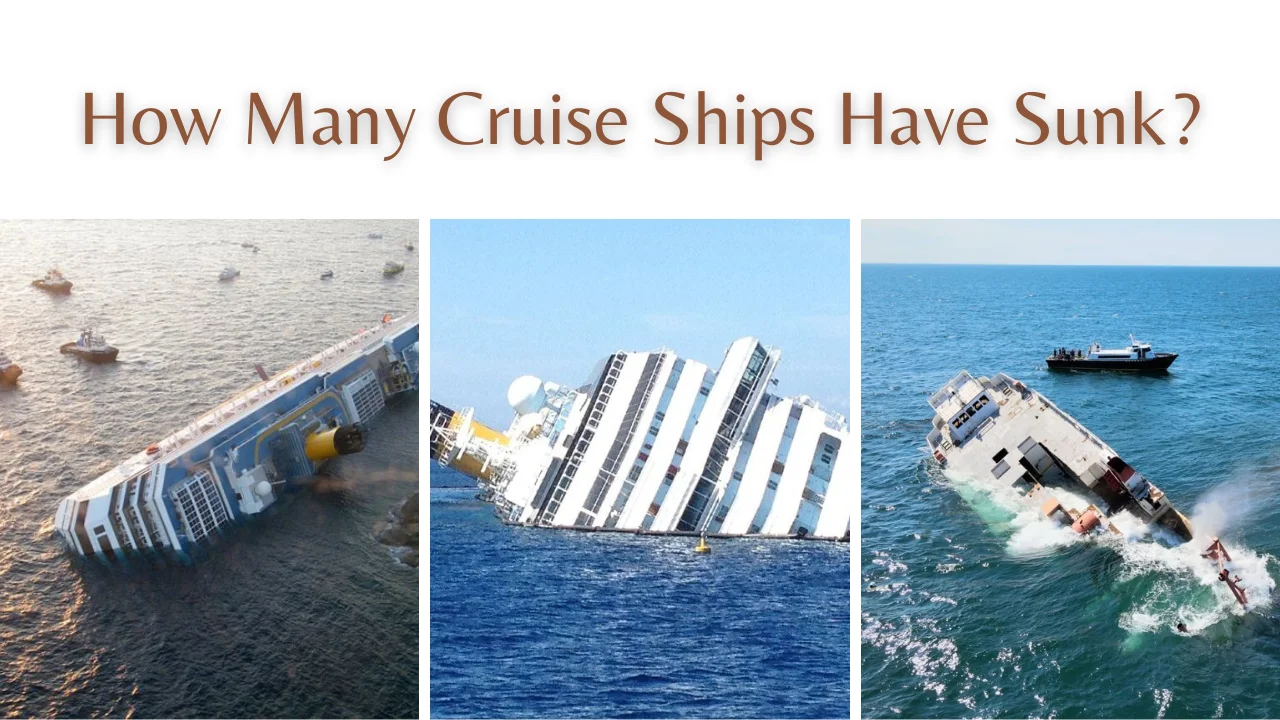
How Many Cruise Ships Have Sunk? There have been a total of 22 cruise ships that have been lost at sea; however, several of these vessels sank while they were docked or being towed. The allure of cruise ship travel has captured the hearts of adventurers and leisure seekers for decades.
These majestic vessels, often considered floating cities, allow passengers to explore the world’s oceans while enjoying luxurious amenities and entertainment.
However, amidst the grandeur and excitement, a question arises: how many cruise ships have sunk? While cruise ship sinkings are rare and isolated, a handful of unfortunate events have left their mark on maritime history.
In this research, we will examine the causes, outcomes, and industry actions to protect passengers and crew of sinking cruise ships. Join us as we navigate through the depths of maritime history to shed light on the infrequent yet impactful instances of cruise ship sinking.
Table of Contents
Has A Cruise Ship Ever Sunk?
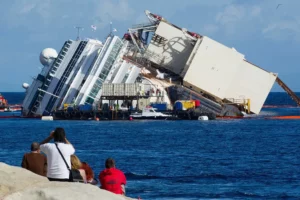
Source: Pinterest
It is extremely unusual for a cruise ship to sink, yet it has happened. Only 22 cruise ships have been lost in the last century; a few went down while docked or towed.
With improved maritime safety, passengers often suffer few casualties during a cruise ship disaster. Some greater catastrophes, like the Titanic and the somewhat less well-known Empress of Ireland, occurred a little over a century ago.
Only 22 cruise ships, including river cruise ships and ocean liners, have gone down in the last 100 years. Over half of the nearly 2,000 people killed in these disasters may be traced back to ships going down before 1940.
There were no fatalities in several of the cases. The sinking of the Costa Concordia is widely considered to be the most high-profile incident involving a cruise ship in the past century.
She was the only huge, modern ocean liner carrying passengers from all over the world that went down in the middle of a voyage when she went down in 2012. The ship ran into an undersea rock due to the negligence of the skipper, who was subsequently convicted of manslaughter.
How Frequently Do Passenger Ships Go Down?
Cruise ships seldom sink, and when they do, passengers are usually not on board. About once every five years, a cruise ship has gone down in the last 100 years. Only once every seven years does a ship sink, and people die? There have been 15 cruise ship disasters in the last 50 years.
Five of these accidents happened when no one was on board; in the sixth, an engine caught fire while the ship was on a voyage, but everyone got off safely.
Since 1956, there have been just nine passenger fatalities on cruises, and while some of them were the result of human mistakes, at least one was the result of a rare storm hitting a river trip.
How Long Has It Been Since A Cruise Ship Went Down?
The Orient Queen was the final passenger ship to go down. When the catastrophic ammonium nitrate explosion of 2020 occurred in Beirut, this ship was docked there.
The explosion caused enough damage to the ship that it sank later that evening. Two people on the ship perished. In 2015, a Chinese river cruise ship struck an unexpected and violent storm that overturned the boat, marking the last occasion a cruise ship sank with passengers on board.
List of Cruise Ships
A myriad of cruise ships grace the world’s oceans, offering diverse experiences to passengers. From luxurious mega-liners featuring state-of-the-art amenities to intimate expedition vessels exploring remote destinations, these ships cater to varied preferences, creating unforgettable journeys across the seas. Here is the list of cruise ships.
1. Titanic
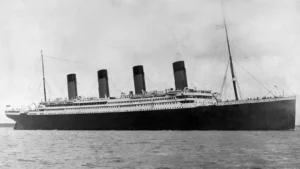
The Titanic sank on her maiden journey across the Atlantic Ocean after hitting an iceberg, causing one of the most infamous and deadly maritime disasters in recorded history.
The ship did not have enough lifeboats to accommodate everyone on board, a major factor in making this disaster one of the worst at sea.
2. The Irish Domina
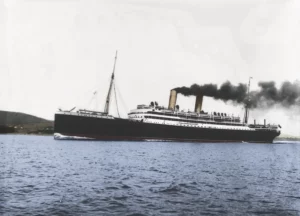
Both vessels had seen each other when visibility was good, but with the fog closing in, they were reduced to using only whistles to exchange information. One thousand twelve individuals, including passengers and crew, perished when the Empress of Ireland sank after being hit. Canada has never had a maritime calamity of this magnitude.
3. Lusitania

The Lusitania, a cruise liner for Cunard Line, set sail in 1906. The company is still going strong today. For a short period, she was the largest passenger ship in the world, and she was a British ocean liner.
Tragically, she lost her life in World War I. She had a productive nine-year sailing career, during which she made 201 crossings of the Atlantic Ocean.
But in 2022, she was struck by a torpedo from a German U-Boat submarine near the south coast of Ireland while sailing from New York to Liverpool.
4. Britannic
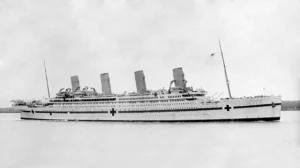
HMHS Britannic, like her sister ship Titanic, was built by White Star Line as part of the Olympic Class of ocean liners. But the First World War erupted right before her scheduled departure.
In 1915, she entered service as the world’s largest hospital ship. She sank 55 minutes after she hit a German naval mine off the shore of a Greek island in 1916.
5. Principessa Mafalda

The SS Principessa Mafalda was a passenger ship that set sail from Genoa, Italy, to Buenos Aires, Argentina, regularly beginning in 1909.
In 1927, off the coast of Brazil, she went down after a broken propeller shaft ripped through the ship’s hull. She went down slowly, but there was chaos on board, and 314 individuals died out of 1,252.
6. Georges Philippe
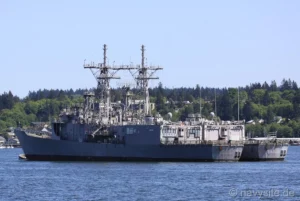
Georges Philippe, a French ocean liner, went down during her inaugural trip because of an electrical problem. After a successful voyage to Yokohama, she ran into trouble and perished off the coast of Italian Somaliland on the way back.
A faulty light switch in one of the ship’s deluxe suites caused a spark that ignited a wooden panel because of the ship’s high-voltage wiring. There were 54 fatalities.
7. Saint-Philibert
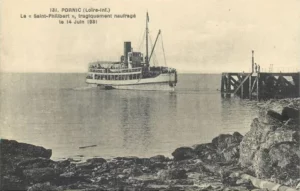
During the summer, passengers could board the Saint-Philibert, a small cruise ship, for trips around the Loire River and the French coast. When she was first put into service is unknown, but disaster struck in 1931 when she went down.
She went down due to many factors, including bad weather and carrying twice the number of passengers allowed.
8. SS Morro Castle
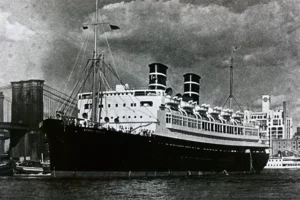
The SS Morro Castle was a passenger liner built to make frequent trips from the United States to Cuba. She set sail in 1930, and just four short years later, she would go down in sad circumstances.
The ship went down because of a fire that ate away at its electrical cables and hydraulic systems, rendering them useless and eventually causing the ship to capsize. The crew’s poor response to the incident led to the deaths of 137 passengers.
9. Empress of Britain

As with the Lusitania, the sinking of the Empress of Britain, which the Canadian Pacific Railway Company also owned, was a result of war; in this case, it was World War II.
After her first launch in 1930 and official completion in 1931, she spent nine years plying the waters between Canada and Europe as an ocean liner.
10. Andrea Doria
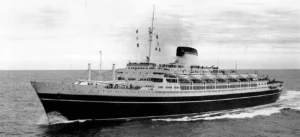
The collision between Andrea Doria and Stockholm, resulting in the loss of 46 lives, showcased both tragedy and progress in ship safety. This tragic incident highlighted improvements in ship safety since the Titanic disaster.
The impact caused Andrea Doria to list significantly, making some lifeboats unusable. Despite the loss of life, the collision prompted a renewed focus on enhancing maritime safety measures and protocols, marking a pivotal moment in the ongoing evolution of ship safety standards.
While the sinking of cruise ships remains a rare and isolated phenomenon, it serves as a reminder of maritime travel’s complex and unpredictable nature.
The cruise industry’s dedication to safety, continuous technological advancements, and rigorous adherence to regulations ensure that incidents are minimized, and passenger security remains paramount.
As travellers continue to embark on memorable journeys across the seas, the lessons learned from past incidents shape a safer and more secure future for cruise ship adventures.
Frequently Asked Questions
How common are cruise ship sinkings, what are some notable examples of sunken cruise ships.
- 6 Best Cruise Ships with Family Suites
- Cruise Ship Engine Room: The Complete Guide
- Is Smoking Allowed On Cruise Ships? A Complete Guide
- Everything You Need to Know About Laundry on Cruise Ships
- Comparing Titanic vs Cruise Ship: Design, Features, and Differences
- 12 Best The New Cruise Ship 2024
Leave a Comment Cancel reply
Save my name, email, and website in this browser for the next time I comment.

10 Major Cruise Ships And Passenger Vessels That Sank
The Titanic might seem the worst passenger ship accident. However, many historic cruise ships met the same fate, though they were not as famous as the RMS Titanic. The earliest cruise ships were constructed in the 1850s but gained prominence after the World Wars ended when vacationing on the seas seemed attractive.
Cruise ships were also constructed before that and targeted the affluent section of society. Also, cruise voyages in the 19th and 20th centuries were fraught with many dangers compared to present-day journeys, which have become relatively safer, thanks to advancements in maritime technologies.
However, one commonality remains. Cruise voyages are as thrilling and exciting as they were in their bygone days. This article will enlighten you about the 12 major cruise ships that sank.
1. The Unfateful RMS Titanic
The most infamous cruise ship accident has to be the RMS Titanic. The Olympic-Class Ocean liner was owned by White Star Line and built in Northern Ireland. It was the largest passenger ship of its time, designed by Thomas Andrews, capable of carrying over 3000 people.
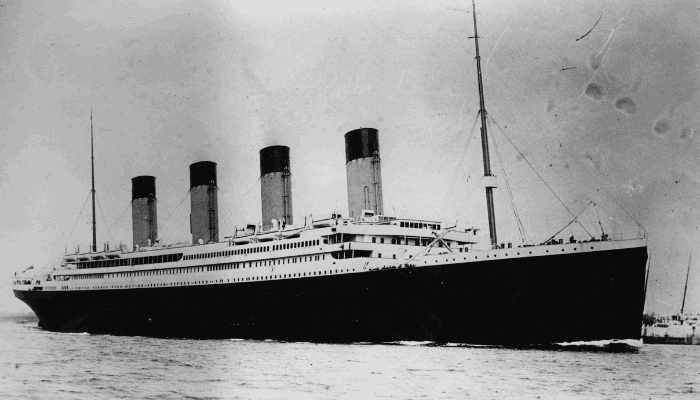
It was called unsinkable due to its 16 watertight compartments that could be closed in case of a collision. Sadly, the ship sank from Southampton to New York on its first voyage. It hit a massive iceberg in April 1912, near Newfoundland, Canada, and drowned three hours later, consuming 1500 of the 2208 people onboard. The chilly waters of the North Atlantic killed everyone from hypothermia before help could arrive.
Directed by James Cameron, the movie released in 1997 immortalized the ship disaster. The Titanic was almost 270 m long and 28.042 m broad. It had nine decks and a gross tonnage of 46,328 tonnes. It was equipped with only 20 lifeboats, enough for 1,178 passengers. Had there been more life crafts, precious lives could have been saved.
2. The Mighty, Costa Concordia
Costa Concordia sank due to a small mistake of the captain and one of the officers. It was a magnanimous passenger ship containing 17 decks, a three-storeyed theatre, swimming pools, gymnasiums, restaurants, and much more. The ship could accommodate over 4000 people.
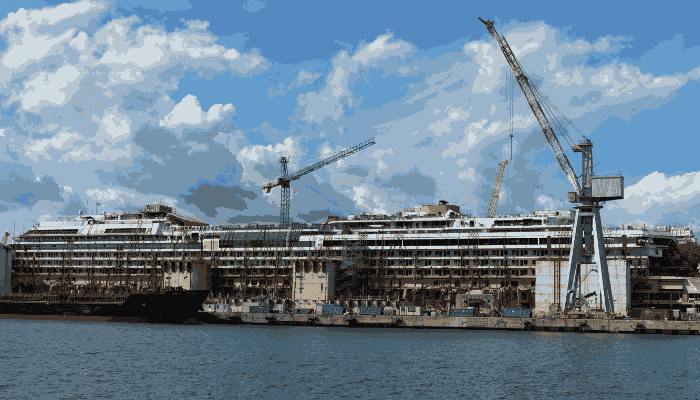
According to investigation reports, the vessel hit an underwater rock when it sailed pretty close to the shore of Isola del Giglio island on 13 January 2012. Captain Francesco Schettino closed the computer navigation alarm since he thought he could navigate the waters himself. Unfortunately, he left his glasses in his cabin, and the damage had been done by the time he got them.
The vessel capsized and sank near Tuscany. Despite the six-hour rescue operation, 34 people died. What’s shocking is that the captain abandoned the ship while 300 passengers were onboard, despite the Coast Guard Officer’s attempt to dissuade him. He was convicted of manslaughter and got a 16-year prison sentence in 2017.
3. The Graceful, MS Estonia
Cruise ferry MS Estonia was struck amidst bad weather in the Baltic Sea, which led to its demise. The ship was built in 1980 by Meyer Werft in Papenburg, Germany. It was known by many names like Viking Sally and Wasa King before 1993. It sank while sailing from Tallinn to Stockholm in September 1994.
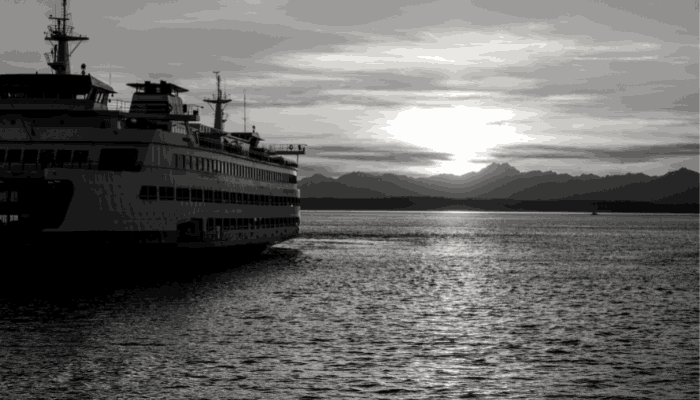
According to reports, it sank as its bow door locks couldn’t open during the storm, with strong winds lashing at a speed of 35 to 45 miles per hour. Hence, the ship tilted to the starboard side and later drowned completely due to excessive flooding on the car deck. The ship surged in an hour and took 852 people to the seabed. Only 137 passengers survived and were rescued.
MS Estonia was 155.43 m long and 24.2 m wide, with a 5.5 m draught and 15,598 gross tonnages. It had 9 decks and 10 lifeboats which were not enough for 2000 people. It could also carry over 410 cars.
4. RMS Lusitania
The German attack on Cruise Ship RMS Lusitania in 1915 was one of the main reasons behind the entry of the US into the First World War. It was hit as a naval vessel since it also contained military weapons for Britain.
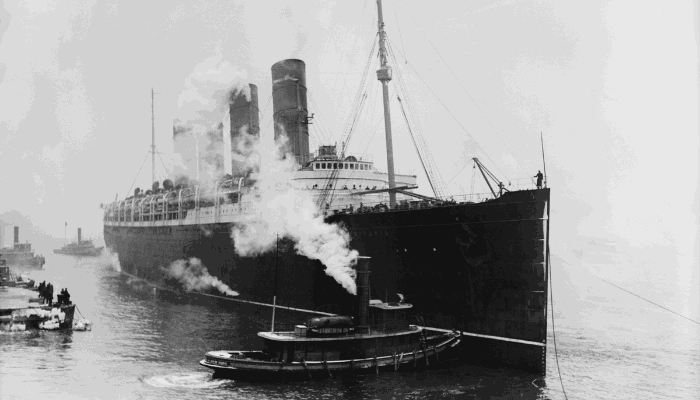
Military Submarine U-20 attacked the cruise while traveling to Liverpool from New York. Launched in 1906, the vessel was constructed by Jon Brown and Corporation and operated by Cunard Company.
The humongous steamship was the largest and most luxurious vessel at that time. It measured almost 240 m lengthwise and 27 m breadthwise, with a 10.2 m draft. The 31,550-tonne ship had 10 decks and a maximum sailing speed of 26.3 knots. It could easily carry 2160 people and over 800 crew. When it sank, 1201 people lost their lives, most Americans.
5. SS Andrea Doria
The SS Andrea Doria went down not because of rough seas or striking an iceberg or underwater formations. Instead, it collided with another passenger vessel called Stockholm due to misreading the radar. Hence, it is remembered as the world’s major radar-caused collision. The incident could not be averted as thick fog barred visibility.
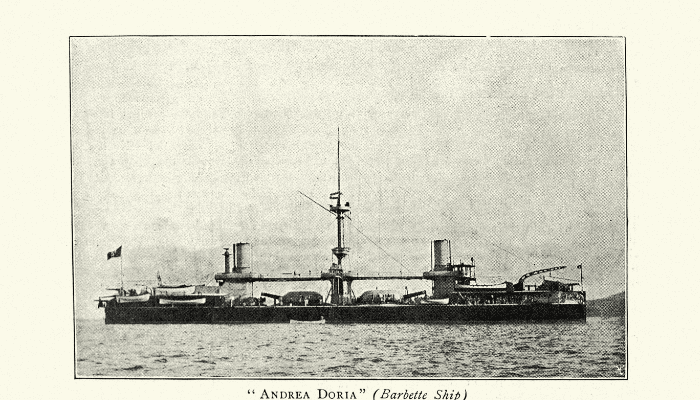
The disaster occurred in July 1956 off the coast of Nantucket, Massachusetts, when the liner was sailing to New York. Hit under the starboard bridge, it was engulfed by waves after 11 hours which gave nearby vessels enough time to respond to its SOS call. Over 50 people died, mostly due to the impact, and over 1650 were rescued.
Owned by Italian Line, it was constructed for a whopping 30 million US dollars. The 212 m long ship had 10 decks and powerful steam turbines, enabling it to attain a maximum speed of 23 knots.

6. SS Eastland
This passenger ship used for touring killed 844 people while it was docked in a port on the Chicago River on 24 July 1915. The vessel rolled over to its starboard side and submerged in water, trapping most passengers inside. It is one of the greatest ship accidents recorded in the history of the Great Lakes.
The accident occurred while the 2500 people were embarking on the vessel, preparing to cruise through Michigan. The possible causes of this disaster were structural flaws in its design, overloading, and inadequacy of the ballast tanks.
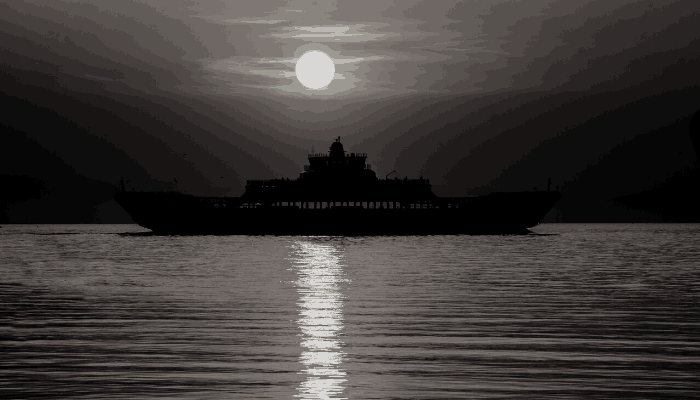
Later it was salvaged and handed over to the US Navy, which restored and modified it. It became a gunboat called USS Wilmette and was used for training. It was scrapped after the second world war ended.
It was launched in 1903 by the Michigan Transportation Company. the 275 m long cruise ship was equipped with 11 lifeboats and 37 life rafts. t had a top speed of 16.5 knots.
7. RMS Empress of Ireland
Ocean Liner Empress of Ireland was carrying 1477 passengers when it struck another Norwegian vessel, the 6000-tonne Storstad, due to poor visibility in the Saint Lawrence River. More than 1000 people died in May 1914, the second biggest cruise disaster of the period, following the Titanic incident.
The cruise ship followed the North Atlantic route between Liverpool and Quebec. Though it contained 42 lifeboats, only four could be launched in water as it tilted on her starboard side, causing panic and chaos onboard the ship. The harsh cold and the inability to close its watertight doors and portholes worsened the situation.
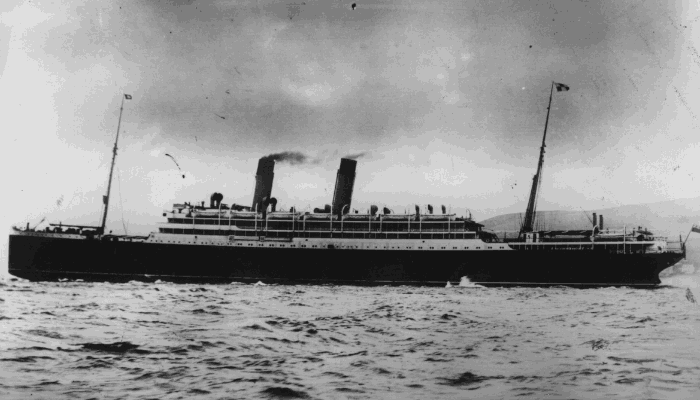
The 168 m long and 20 m broad cruise ship was launched in 1906. t was owned by the Canadian Pacific Steamship company and designed by Francis Elgar. Mirfield Shipping and Engineering were responsible for her construction.
It had 14,191 gross tonnages, two steam engines, and propellors, providing a top sailing speed of 20 knots.
8. SS Admiral Nakhimov
The collision of the cruise ship SS Admiral Nakhimov with the bulk carrier Pyotr Vasev was due to the carelessness of both the vessels’ captains. T e captain of the bulk ship failed to respond to the warning signals issued by the cruise ship. H was not present on the bridge when the vessel hit each other at 5 knots.
The cruise ship disaster occurred in 1986 in Tsemes Bay near Novorossiysk port when the vessel was en route to Sochi. I was carrying 1234 passengers, of which 423 died due to the collision and its aftermath.
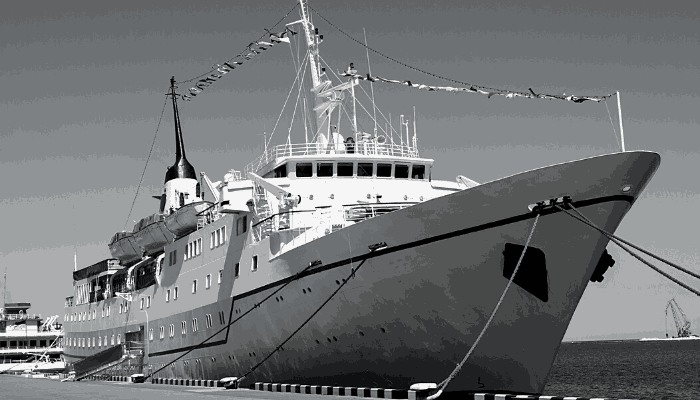
Initially named SS Berlin II, the cruise liner operated on the Crimean-Caucasian route. It was built by Bremer Vulkan and owned by Norddeutscher Lloyd.
The majestic ship had an overall length of 174 m, a 21 m beam, and 17,054 gross tonnes. It could conveniently accommodate 1125 passengers and over 300 crew members. It had a cruising speed of 16 knots.
9. SS Morro Castle
Cruise vessel SS Morro Castle was burned and sank in September 1934, claiming the lives of over 135 passengers and crew members. A total of 318 passengers and 239 crew were aboard the ship on its journey from Havanna to New York.
The accident occurred as the fire spread from its library to the decks and cabins, engulfing the superstructure in flames. I was aggravated by the ship’s decor, which was made of wood and other flammable material. The fire could not be controlled due to rough weather, incapable staff, and the ship’s design.
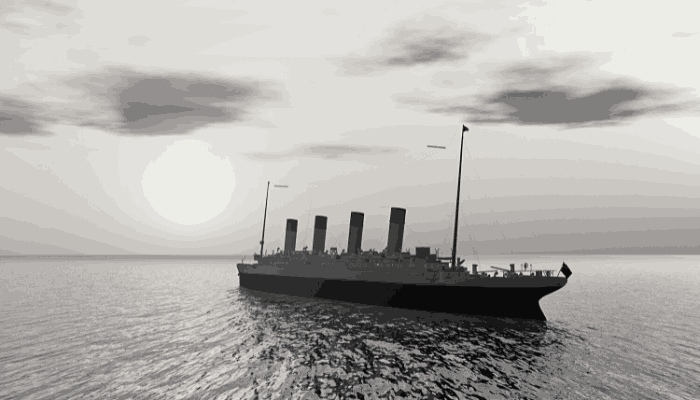
Only 12 lifeboats could be launched out of the several available on board. The decks burned the feet, and passengers leaped into ocean swells. The ship was abandoned by afternoon and the survivors were taken to the New Jersey Coast.
Interestingly, the previous evening, the ship’s captain, Robert Wilmott, died suddenly. T e Chief Officer took command and was worried about a strong northeast wind and dark clouds.
The exact cause of the fire remains a mystery; however, an overheated funnel and electric circuitry are blamed. T ose related to the incident, also speak of arson by a crew member.
It was owned by Agwi Navigation Co. and constructed in 1930. T e 155 m long cruise ship could carry 489 people apart from 240 crew at a speed of 20 knots.
10. Saint-Philibert
A small cruise ship sailing from Loire River, near the French coast, met with tragedy in June 1931. T e ship was carrying 500 people, mostly workers, and their children, from Nantes port. I exceeded its carrying capacity by 80 percent. T e danger was doubled when it encountered raging seas and rough weather, which was not precedented as it was the summer season.
The captain and crew members panicked as there was nothing to be done. O t of the 500 people onboard, only 8 survived the horrific accident. T e violent storm forced passengers to take shelter near machinery casings, which tilted the ship to its starboard side and it ultimately capsized when struck by a gigantic wave.
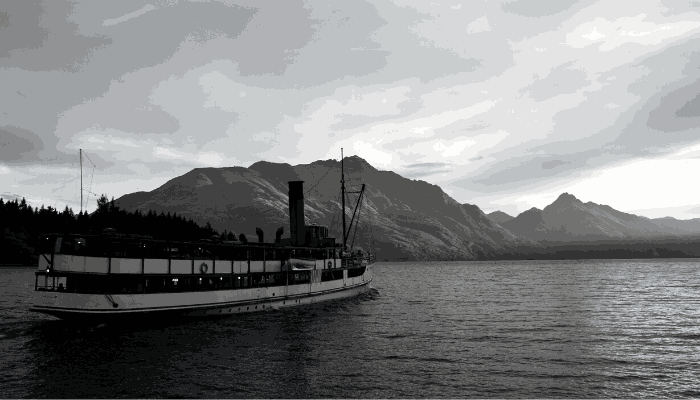
The ship was not equipped to face bad weather, and the captain and crew were not experienced. Appropriate communication equipment was also missing onboard the vessel.
A trial was conducted in 1933, the victims’ families lost the case, and the ship’s owners were set free without any penalties. The cruise vessel was 32 m long and 6.4 m broad with a gross tonnage of 189 tonnes.
You might also like to read-
- Titanic vs. Modern Cruise Ship: How Ships Have Evolved
- Costa Concordia Cruise Ship: Know The ill-fated Ship
- The Scenic Jewel Cruise Ship
- Ship Portholes: A General Overview
Top 10 Largest Cruise Ships in 2022

About Author
Zahra is an alumna of Miranda House, University of Delhi. She is an avid writer, possessing immaculate research and editing skills. Author of several academic papers, she has also worked as a freelance writer, producing many technical, creative and marketing pieces. A true aesthete at heart, she loves books a little more than anything else.
Read More Articles By This Author >
Disclaimer : The information contained in this website is for general information purposes only. While we endeavour to keep the information up to date and correct, we make no representations or warranties of any kind, express or implied, about the completeness, accuracy, reliability, suitability or availability with respect to the website or the information, products, services, or related graphics contained on the website for any purpose. Any reliance you place on such information is therefore strictly at your own risk.
In no event will we be liable for any loss or damage including without limitation, indirect or consequential loss or damage, or any loss or damage whatsoever arising from loss of data or profits arising out of, or in connection with, the use of this website.
Do you have info to share with us ? Suggest a correction

Daily Maritime News, Straight To Your Inbox
Sign Up To Get Daily Newsletters
Join over 60k+ people who read our daily newsletters
By subscribing, you agree to our Privacy Policy and may receive occasional deal communications; you can unsubscribe anytime.
BE THE FIRST TO COMMENT
Leave a reply.
Your email address will not be published. Required fields are marked *
Subscribe to Marine Insight Daily Newsletter
" * " indicates required fields
Marine Engineering
Marine Engine Air Compressor Marine Boiler Oily Water Separator Marine Electrical Ship Generator Ship Stabilizer
Nautical Science
Mooring Bridge Watchkeeping Ship Manoeuvring Nautical Charts Anchoring Nautical Equipment Shipboard Guidelines
Explore
Free Maritime eBooks Premium Maritime eBooks Marine Safety Financial Planning Marine Careers Maritime Law Ship Dry Dock
Shipping News Maritime Reports Videos Maritime Piracy Offshore Safety Of Life At Sea (SOLAS) MARPOL
WAIT! Did You Download 13 FREE Maritime eBooks?
Sign-up and download instantly!
We respect your privacy and take protecting it very seriously. No spam!
WAIT! Did You Download 12 FREE Maritime eBooks?
Switch language:

The world’s worst cruise ship disasters
Tragedies aboard cruise ships live on in infamy as the sinking of RMS Titanic, the biggest cruise disaster in history, bears witness. Ship-technology.com lists the worst ever cruise ship disasters.
- Share on Linkedin
- Share on Facebook
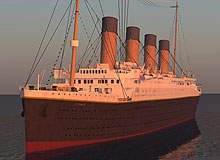
The World’s Deadliest Cruise Ship Disasters
Rms titanic.
The sinking of RMS Titanic in April 1912 remains the worst, and the most infamous, cruise ship disaster in history. The sinking of the biggest passenger ship ever built at the time resulted in the death of more than 1,500 of the 2,208 people onboard.
Recommended Buyer's Guides
Leading Guide to Bunker Fuels, Lubricants and Fluids for the Shipping Industry
Leading guide to propulsion, transmission and engine room equipment for the shipping industry.
The accident occurred when the ship hit an iceberg while cruising at its maximum speed of 23k on her maiden voyage from Southampton to New York City. The massive loss of life in the North Atlantic Ocean resulted mainly from hypothermia.
Go deeper with GlobalData

Russia: Falling Voice Revenue and Macroeconomic Uncertainty to Slow...
Disruptor profile: day zero diagnostics, inc., premium insights.
The gold standard of business intelligence.
Find out more
Related Company Profiles
Parsons corp, newport news ship building, meyer werft gmbh, wolff corporation.
RMS Titanic was the second of three Olympic-class ocean liners operated by White Star Line. It was constructed by the Harland and Wolff shipyard in Belfast in three years and was designed by the naval architect Thomas Andrews.
RMS Titanic measured 269.11m in length, 28.042m in breadth, had a gross tonnage of 46,328t and comprised nine decks. The cruise ship was equipped with 20 lifeboats for 1,178 people.
The steamship’s three propellers were driven by two four-cylinder, triple-expansion, inverted reciprocating steam engines and one four-blade low-pressure Parsons turbine.
RMS Lusitania
The sinking of RMS Lusitania in May 1915, after being hit by the German military submarine U-20, caused 1,201 deaths during a voyage from New York to Liverpool. She was considered the largest, fastest and most luxurious ship in the world at the time of her launch in June 1906.
How well do you really know your competitors?
Access the most comprehensive Company Profiles on the market, powered by GlobalData. Save hours of research. Gain competitive edge.

Your download email will arrive shortly
Not ready to buy yet? Download a free sample
We are confident about the unique quality of our Company Profiles. However, we want you to make the most beneficial decision for your business, so we offer a free sample that you can download by submitting the below form
The Lusitania disaster resulted in the death of many Americans and became one of the major reasons behind the US entering World War I.
The German submarine targeted the submarine as a naval ship, as it was also carrying war weapons for the British.
RMS Lusitania was built by John Brown and Co. of Scotland and completed its maiden voyage in September 1907. The steamship was owned and operated by Cunard Company; a rival of White Star Line, which owned the Titanic.
RMS Lusitania had an overall length of 239.8m, beam of 26.7m, draft of 10.2m, depth of 18.4m, gross tonnage of 31,550t and ten decks. It was designed to accmmodate 2,165 passengers and 827 crew members. It was equipped with four 375kW generator sets and possessed a service speed of 25k and a maximum speed of 26.35k.
RMS Empress of Ireland
RMS Empress of Ireland, which sank in the Saint Lawrence River in May 1914, claimed the lives of 1,012 people out of the 1,477 people onboard. It was the second major cruise ship disaster after the Titanic disaster. The Ocean Liner operated on the North Atlantic route between Quebec and Liverpool in England.
The passenger steamship collided with the 6,000t Norwegian collier, the Storstad, following a thick fog which engulfed the river. Just five of the 42 lifeboats could be launched into the water due to the listing of the vessel on her starboard side. The accident was aggravated by the cold conditions, failure to close the ship’s watertight doors and failure to close all portholes aboard.
RMS Empress of Ireland was owned by Canadian Pacific Steamship Company. It was designed by Francis Elgar and built by Fairfield Shipbuilding and Engineering. The ocean liner was launched in January 1906 and completed her maiden voyage from Liverpool to Montreal in June 1906.
The cruise ship was 168m long, its beam measured 20m and gross tonnage was 14,191t. The ship was equipped with two steam engines and two quadruple expansion propellers, which provided a maximum operating speed of 20k.
MS Estonia, formerly known as Viking Sally, Silja Star and Wasa King during different periods from 1980 to 1993, sank in September 1994 during its voyage from Tallinn to Stockholm, resulting in 852 deaths, while 137 people were saved through rescue operations.
The cruise ferry accident was caused by rough sea conditions in the Baltic Sea, when wind speeds ranged from 35mph to 45mph. The bad sea conditions forced the ship to initially list on the starboard side and later sink completely.
The ferry was constructed by Meyer Werft at its shipyard in Papenburg, Germany, in 1980. The ferry, initially named Viking Sally, was delivered in June 1980 to its first owner Rederi Ab Sally. The vessel was operated by EstLine from 1993 to 1994.
MS Estonia measured 155.43m in length, 24.21m in breadth, had a draught of 5.55m, a gross tonnage of 15,598t and featured nine decks and ten lifeboats. The vessel was equipped with four 4,400kW diesel engines connected to two propeller shafts, and had an operational speed of 21k. The cruise ferry had capacity to accommodate 2,000 passengers and 460 cars.
SS Eastland
The SS Eastland disaster in July 1915 claimed more than 844 lives out of the 2,500 people onboard. The disaster occurred when the ship listed while being still tied to a dock in the Chicago River during preparations to cruise to Michigan City.
The probable causes of the disaster are believed to be the flaws in its design and construction, inadequacy of its ballast tanks and overloading. The accident occurred when the passengers embarked the ship. The ship initially listed to the starboard side and further to portside, throwing off passengers and trapping some in the interior cabins.
SS Eastland was owned by Michigan Transportation Company and operated by Chicago-South Haven Line. It was constructed by Jenks Ship Building Company, which specialised in constructing freighters but had no prior experience in construction of passenger vessels. The vessel was launched in May 1903.
The cruise ship had an overall length of 275m, width of 38m and gross tonnage of 1,961t. It was equipped with two triple expansion steam engines, four scotch boilers and two shafts. The vessel was designed for a top speed of 16.5k. It was equipped with 11 life boats and 37 life rafts.
Saint-Philibert Cruise Ship
Saint-Philibert was a twin screw-propelled small cruise ship that met with disaster in June 1931 resulting in the loss of about 500 lives, sparing just eight passengers while on its homeward run on the Loire Estuary in France.
The disaster was induced by harsh storms driving the passengers to take shelter behind the machinery casings, which caused the ship to list over. It was further struck by a wave causing her to sink. The ship, which carried approximately 500 people during the voyage, exceeded the normal carrying capacity by about 80%.
The inadequacy of the ship’s speed to face such waves, lack of coverings for shelter and absence of communication equipment further aggravated the situation. Besides, the captain and crew were considered unqualified.
Saint-Philibert cruise ship measured 32m in length and 6.4m in breadth, and had a draft of 2.74m and gross tonnage of 189t.
SS Admiral Nakhimov
The SS Admiral Nakhimov disaster in August 1986 resulted in the death of 423 people, mostly Ukranians, out of the 1,234 people onboard. The accident occurred in the Tsemes Bay near the port of Novorossiysk enroute Sochi.
The cruise ship collided with the large bulk carrier Pyotr Vasev at a speed of five knots, causing it to sink within a few minutes. The accident was caused by negligence of the captains of the two ships. The captain of Pyotr Vasev failed to heed the warning announced from SS Admiral Nakhimov, while the captain of Admiral Nakhimov was absent on the bridge at the time of the tragedy.
The passenger liner was originally named SS Berlin III and operated on the Crimean-Caucasian line. It was owned by Norddeutscher Lloyd and constructed by Bremer Vulkan.
SS Admiral Nakhimov had an overall length of 174m, beam of 21.02m and gross tonnage of 17,053t. It had a capacity to accommodate 1,125 passengers and 354 crew, and a cruise speed of 16k.
Aleksandr Suvorov
Aleksandr Suvorov, a river cruise ship of the Valerian Kuybyshev-class, met with disaster in June 1983 resulting in the death of 176 people out of the 415 people onboard, while cruising on the Volga-Don basin in Russia. The blame for the accident was placed on the captain who failed to prevent the accident and had not provided a proper order.
Just prior to the accident, an auction to be held at the cinema hall was announced, leading the passengers to the upper deck of the ship. The ship, which was cruising at a speed of about 13.5k at the time, crashed onto a bridge, failing to pass through the second span of the bridge. A freight train passing through the bridge was also affected by the crash, causing some cars to derail and fall on the ship.
Volga-Don Shipping Company was the operator of the ship at the time. Slovenské Lodenice constructed the vessel in Komárno, Czechoslovakia. The ship was restored after the accident and is currently operated by Vodohod.
Aleksander Suvorov has an overall length of 135.75m and width of 16.8m, and is comprised of four decks. It can accommodate 400 passengers and 83 crew, and runs on a 6CHRN36/45 (EG70 -5) diesel engine.
SS Morro Castle
The SS Morro Castle disaster in September 1934 resulted in the loss of more than 137 passengers and crew out of the 318 passengers and 240 crew onboard. The cruise ship was on its 174th return voyage to New York City from Havana.
The disaster was caused by a fire, which emanated from the cruise ship’s library and engulfed the entire ship. The fire was worsened by bad weather, inadequate crew and the ship’s design, which incorporated easily flammable interior materials. Just 12 lifeboats were launched out of the many lifeboats capable of rescuing 408 people.
The ship was owned by Agwi Navigation Co. and operated by Ward Line. It was constructed in 1930 at a cost of approximately $5m by Newport News Shipbuilding. The vessel completed her maiden voyage in August 1930 and served Ward Line along with its sister vessel SS Oriente for four years.
SS Morro Castle was 155m long, 21.6m wide and 11.9m deep, and had a capacity to carry 489 passengers and 240 crew. The steam turbo-electric liner was propelled by two turbines and sailed at a speed of 20k.
SS Andrea Doria
The SS Andrea Doria collided with the eastbound Swedish passenger liner Stockholm due to poor visibility caused by a thick fog. The disaster took place in July 1956 near the coast of Nantucket, Massachusetts, while cruising towards New York City resulting in the death of 52 people, while 1,660 people were rescued.
It is considered the world’s first major radar-assisted collision at sea, as the cause of the accident is assumed to be from the misreading of the radar. It was struck just aft and below the starboard bridge, and sank after 11 hours.
The ocean liner was owned by Italian Line and constructed by Ansaldo Shipyards of Genoa, Italy, at a cost of approximately $30m. It was launched in June 1951 and set out on its maiden voyage in January 1953.
SS Andrea Doria measured 212m in length, had a beam of 27m and a gross tonnage of 29,100t. It featured ten decks and was equipped with two steam turbines providing a top speed of 23k.
Sign up for our daily news round-up!
Give your business an edge with our leading industry insights.
More Relevant
Icon of the Seas Cruise Ship, USA
Superyacht ilma, malta, disney treasure cruise ship, bahamas, resilient lady cruise ship, us, sign up to the newsletter: in brief, your corporate email address, i would also like to subscribe to:.
Ship Technology In Brief
Ship Technology Global : Ship Technology Focus (monthly)
I consent to Verdict Media Limited collecting my details provided via this form in accordance with Privacy Policy
Thank you for subscribing
View all newsletters from across the GlobalData Media network.

How Many Cruise Ships Have Sunk? [& How Often]
Whether you are about to embark on a cruise ship or have watched movies like the Titanic, a question that might pop into your head is how many cruise ships have sunk and how often this happens.
There have been many deadly cruise ship incidents in maritime history that shocked the world. From the Titanic to Costa Concordia, many cruise ships have sunk in the past.
If this is your first sailing or exploring maritime history, you will have many questions.
In this article, I will share the list of cruise ships that have sunk in the past and how often this happens. Finally, if something unfortunate happens, you will also see if modern-day cruise ships have enough safety measures.
How Many Cruise Ships Have Sunk?
Since 1900, only 16 cruise ships have sunk. This includes ocean liners and river cruises as well. The Costa Concordia is the biggest cruise ship to sink in the last 100 years. But no sinking was as severe and deadly as the Titanic’s .
If cruise ships, ocean liners, and river cruises are considered, the number will be well over 16.
Not all cruise ships were sunk when they were sailing. Many cruise ships, ocean liners, and river cruises were sunk while being towed or berthed.
For example, the latest cruise ship sinking of Orient Queen was when the ship was berthed in Beirut. Since the ship had no passengers onboard, only two crew members were killed in the event.
Ship sinking is very rare, and when it happens, not many lives are lost, as all leading modern-day cruise ships are equipped with safety measures like lifeboats and other facilities to save every passenger and crew onboard.
Only three times in the last 50 to 60 years have passengers lost their lives.
In short, cruise ships are designed and built, so they don’t sink that easily, and if something unfortunate happens, there are enough safety measures to save the maximum number of lives.
How Often Do Cruise Ships Sink?
As 16 cruise ships have sunk in the last century, we can assume a ship sinks every 6 years. But since most of the sinkings do not involve passengers onboard, major casualties are rarely reported.
The numbers differ slightly depending on the type of vessel you are referring to, like cruise ships, river cruises, and oceanliners.
The maritime industry has learned a lot from previous ship wreckages and sinking, resulting in building modern-day cruise ships with a rare chance to sink.
One thing to note is that most cruise ships were sunk when there were no passengers onboard, avoiding many casualties.
In short, a ship is sunk only once in 6 to 8 years, and major casualties are reported only once in 20 years.
List Of Sunken Cruise Ships Till 2023
The table below summarizes the list of all cruise ships that sunk in the last century.
Note: The table above includes cruise ships, ocean liners, river cruises, and cruise ferries.
When Was The Last time A Cruise Ship Sank?
The last cruise ship to sink was Orient Queen on August 4, 2020. The ship sank due to the ammonium nitrate explosion while it was at its berth. Since the cruise ship was moored at its berth, no passengers were onboard. But the event killed two crew members and several people injured.
2,775 tons of ammonium nitrate stored at the Port of Beirut exploded, damaging many vessels docked at the port, including the Orient Queen. 218 people were killed, and thousands were injured during the event.
On top of all that, $15 billion worth of property was damaged.
Major Cruise Ships That Sank
Let’s now take a look at all the cruise ships that ever sank and the cause of the sinking.
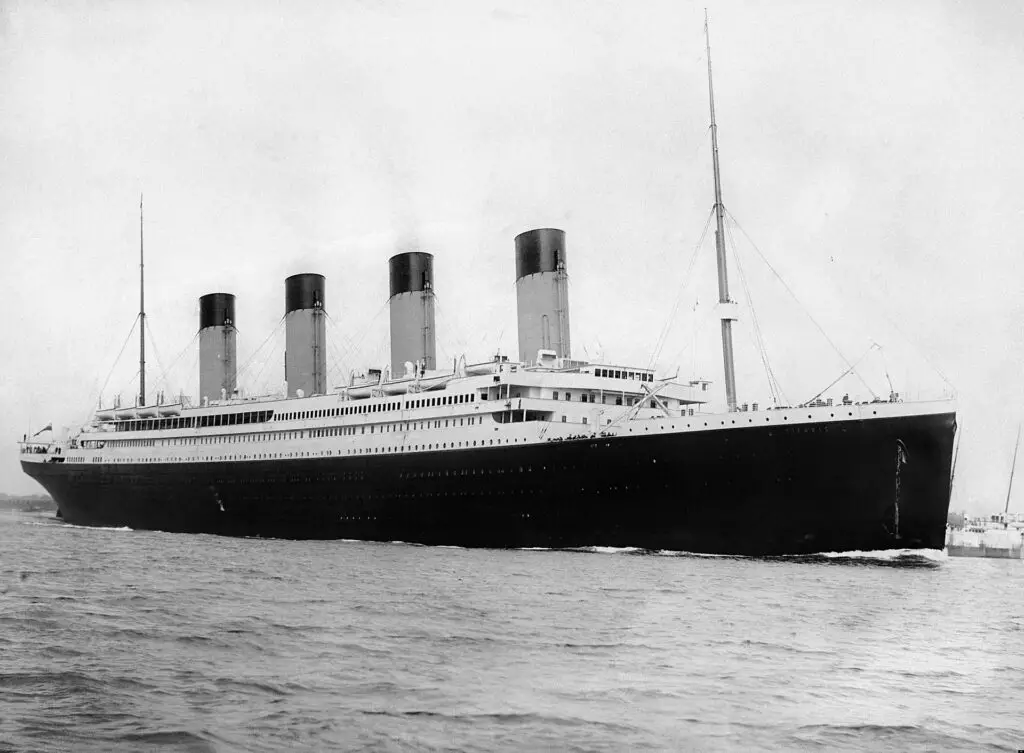
The Titanic is an oceanliner .
Titanic needs no introduction. Everyone knows about the Titanic sinking on its maiden voyage in 1912.
The Titanic started its journey from Southampton, England, and on its way, it collided with an iceberg and sank completely. The vessel cracked in half before sinking and hitting the ocean floor.
The RMS Titanic was an ocean liner operated by White Star Line.
This tragic incident killed 1,500+ passengers and crew on board. Since the water temperature was too low , people could not survive on the water for longer. Furthermore, it’s said that the Titanic didn’t have enough lifeboats for all passengers.
The famous movie Titanic is based on the true story of the Titanic sinking.
Reference: Wikipedia
RMS Empress of Ireland

The RMS Empress of Ireland, aka Empress of Ireland, sank on May 29, 1914, after colliding with a Norwegian collier ship Storstad.
At the time of its sinking, the RMS Empress of Ireland was carrying about 1,500 passengers onboard.
The vessel collided with the other one due to foggy weather conditions affecting visibility.
This maritime disaster took the lives of 1,012 passengers and crew members onboard.
HMHS Britannic

The sister ship of the Titanic and Olympic, HMHS Britannic, or His Majesty’s Hospital Ship Britannic, sank in 1916 after striking a mine.
On November 21, 1916, an explosion happened inside the ship, causing water to let into the watertight compartments.
As time passed, water entered the open portholes on the starboard side . Soon after the water entered the ship, the engine stopped. In about 55th minute, the HMHS Britannic sank. This incident only killed 30 people.
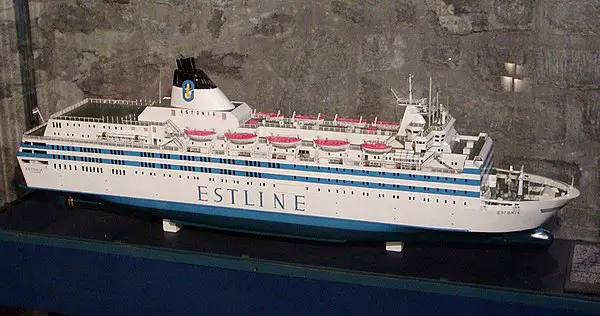
MS Estonia sank in the Baltic Sea in 1994 after hitting a storm. The vessel was sailing from Estonia to Sweden.
The sinking of MS Estonia killed 852 people. The cruise ferry was carrying about 989 people, including passengers and crew.
Out of the 989 people, only 137 people survived.
Costa Concordia
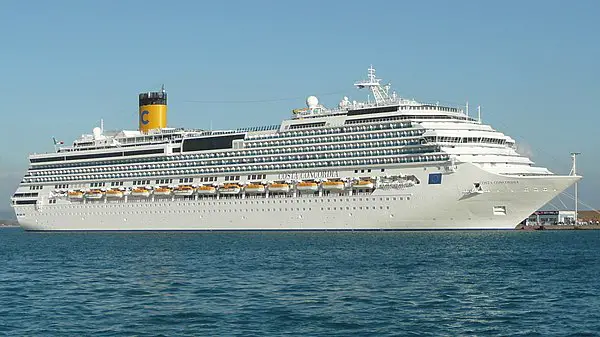
Costa Concordia was the major modern-day cruise ship to sink while on its journey with thousands of passengers and crew onboard.
Costa Concordia hit a reef off the coast of Italy on January 13, 2012. The ship sailed too close to an island, causing the ship to hit an underwater rock, causing the watertight compartments to flood.
At the time of sinking, Costa Concordia was carrying about 4,229 passengers and crew members. This event killed 32 people. This includes 5 crew, 2 salvage team members and 27 passengers.
Later, the captain was found guilty of manslaughter and was sentenced to 16 years of imprisonment.
Principessa Mafalda

Principessa Mafalda was sunk in 1927, killing 314 people, which includes both passengers and crew members.
The vessel’s propeller shaft broke, damaging the hull, and causing the ship to sink mid sea. The incident took place on the coast of Brazil.
Principessa Mafalda is an Italian cruise ship based in Argentina.
Georges Philippar
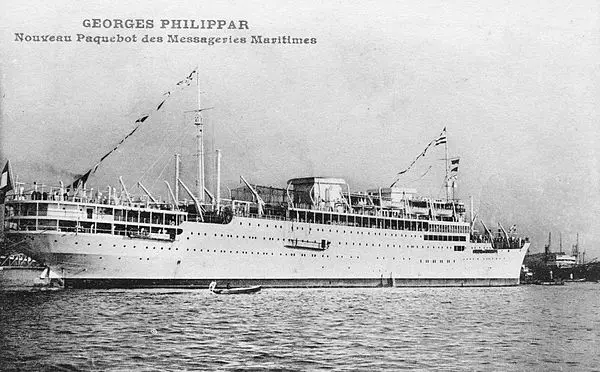
Georges Philippar is yet another vessel that sank on its maiden voyage. The French ocean liner was returning after the voyage to Yokohama.
The sinking of Georges Philippar took the lives of 54 people.
A fire broke out in one of the cabins in the Georges Philippar, after a faulty light switch ignited.
Andrea Doria

In 1956, the sinking of Andrea Doria resulted in the death of 46 passengers and crew members.
While returning, Andrea Doria was hit by a cruise twice the size, causing the ship to sink. The ship sank gradually, allowing more than 1100+ people to escape.
It is said that the people who lost their lives in this event were because of the direct collision with the other ship. The ship only sank completely a day after the collision.
The collision made a good number of lifeboats inaccessible.
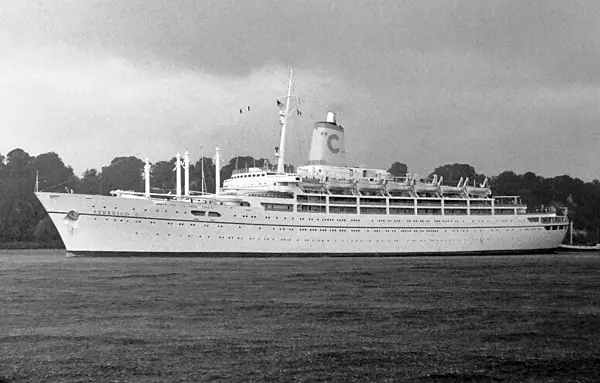
The boiler of the SeaBreeze broke off, causing the ship to sink in 2000. The cruise was owned by Costa Cruises and was transferred to Premier Cruises in 1983.
During the incident, only 34 crew members were on board, and luckily no one was injured as everyone was evacuated easily.
Come controversy exists claiming the sinking of SeaBreeze was intentional to claim insurance. The cruise was already out of business and would fetch $6 million as scrap value. But it was insured for $20 million.
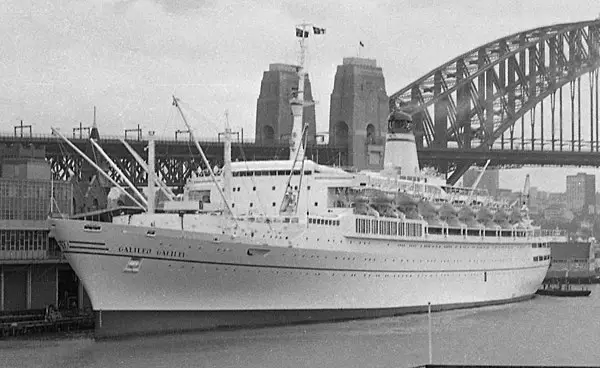
An engine room fire made the Sun Vista sink on May 2, 1999. Even though the entire ship sank, no major casualties nor deaths were reported.
The fire in the engine room cut all the power supply, making the ship sink.
Sun Vista also known as SS Galileo Galilei. The cruise was later bought by Sun Cruises and renamed Sun Vista.
MV Jupiter sank on October 21, 1988, just 40 minutes after leaving the Greek port of Piraeus. The event killed 4 out of the 381 schoolchildren and 84 adults.
Soon after leaving the Greek port of Piraeus, MV Jupiter got struck by a freight ship, the Adige. The collision resulted in a massive hole in the port side of MV Jupiter, letting water in.
Soon after the incident, the ship sank vertically and stern in 82 meters.
The Britanis cruise ship was out of business and was being headed to a scrap yard in India. On the way, the ship developed a heavy leak in the aft section.
The repair for fixing the leak was too costly, and she was allowed to sink.
Since no one was inside the cruise ship and it was tugboat, no casualties were reported.
Orient Queen
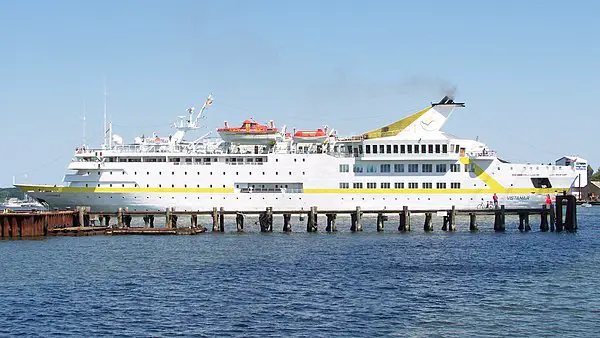
Orient Queen is the latest cruise ship to sink completely. The ship was berthed at the Port of Beirut. The ship sank after a huge ammonium nitrate explosion at the port. Along with Orient Queen, some other ships docked at the port also suffered major damages.
Abou Merhi Grou owned Orient Queen.
Eastern Star
Eastern Star is a river cruise officially known as Dongfang zhi Xing that sank in 2015. On its way back to Chongqing, the river cruise caught in a storm and completely sank in a few hours.
The tragic incident took the lives of 442 people out of the 456 people on board the ship. Only 12 people survived.
The crew wasn’t aware of the severe weather condition, causing the deadly tragedy taking the lives of 442 people.
Later after a thorough investigation, more than 40+ people were punished for flaws in the company management.
MTS Oceanos
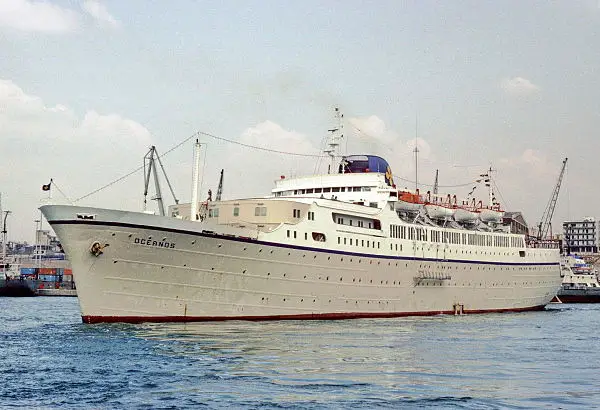
MTS Oceanos sank on August 3, 1991, after a severe leakage in a ventilation pipe flooded the cruise.
The repairs to the waste disposal system of the MTS Oceanos were not completed before its voyage. This caused the ventilation pipe to burst open and start letting water inside the compartment.
Soon the engine room of the vessel was flooded, and she eventually sank.
All 581 passengers and crew members survived the sinking of MTS Oceanos.
How Many Cruise Ships Sink a Year?
As 16 cruise ships have sunk in the last 100 years, we can say a ship sinks in every 6 to 8 years.
But cruise ships sinking is a rare event as modern day cruise ships are well built and designed not to sink or top over even in extreme conditions.
If you look at the years in which cruise ships sank, you will see a gradual decrease in the frequency and number towards the modern age.
A cruise ship takes all the measures to make the ship not sink, and even if something unfortunate comes along the way, there are enough lifeboats , jackets, etc, to rescue people.
How Do Cruise Ships sink?
In most cases, cruise ship does not sink at all. The vessels are designed in such a way as to handle extreme tides and waves. She will keep floating even in rough weather conditions.
But if the cruise ship collides with external obstacles like rocks, icebergs, etc., they may sink. When a vessel hits an iceberg or rock, the watertight compartments will get flooded, eventually letting water in and sinking the ship completely.
So, unless the ship hits an iceberg or rock, it won’t sink at all.
Modern-day navigation systems in cruise ships are well equipped to avoid any possible obstacles including icebergs, rocks, coral reefs, other vessels, and more.
How Many Carnival Cruise Ships Have Sunk?
Only one carnival cruise ship has sunk in history, the Costa Concordia. The Costa Concordia is a cruise ship from Costa, an Italian cruise company owned and operated by Carnival Corporation.
Even though the Costa Concordia cruise ship does not come directly under Carnival cruises, it is still part of the Carnival Corporation.
In short, no Carnival brand cruise ships have sunk or capsized.
Even though no Carnival cruise ships have sunk, there have been a couple of instances where the vessel’s engine shut down after a fire broke out, and the ship got stranded for many hours.
A fire on the Carnival Triumph cruise ship’s generator made her stranded for hours before being fixed. After the event, the cruise line renamed it Carnival Sunshine.
How Many Royal Caribbean Cruise Ships Have Sunk?
No Royal Caribbean cruise ships have sunk or capsized.
How Many Disney Cruise Ships Have Sunk?
No Disney cruise ships have ever sunk in the past. The history is clear for the Disney cruise line.
Leave a Comment Cancel reply
Save my name, email, and website in this browser for the next time I comment.

Cruise FAQs
How many cruise ships have sunk.
Table of Contents
Key Takeaways
- 16 cruise ships have sunk throughout history.
- Collision with another vessel is a main cause of sinking, often due to human error.
- Safety measures and regulations have been enhanced in the cruise industry to prevent future incidents.
- Recent safety improvements have positively impacted passenger confidence.
Historical Sinking Incidents

Notable Sunk Cruise Ships
Causes of sinking, passenger safety measures, impact on cruise industry, causes of cruise ship sinkings, impact of sinkings on the cruise industry, safety measures and regulations, recent safety improvements, compliance with regulations, impact on passenger confidence.
- Increased concerns about safety and security measures
- Diminished faith in the cruise industry’s ability to prioritize passenger welfare
- Potential decline in bookings and revenue
- Negative publicity and media coverage highlighting the violations
Survivors and Rescue Operations
Lessons learned from sunk cruise ships, frequently asked questions, what are some common reasons for cruise ship sinkings, what is the economic impact of a cruise ship sinking on the company operating the ship, how do cruise ship companies ensure passenger safety after a sinking incident, are there any specific regulations or safety measures in place to prevent cruise ship sinkings, how do survivors of cruise ship sinkings receive support and assistance after the incident.
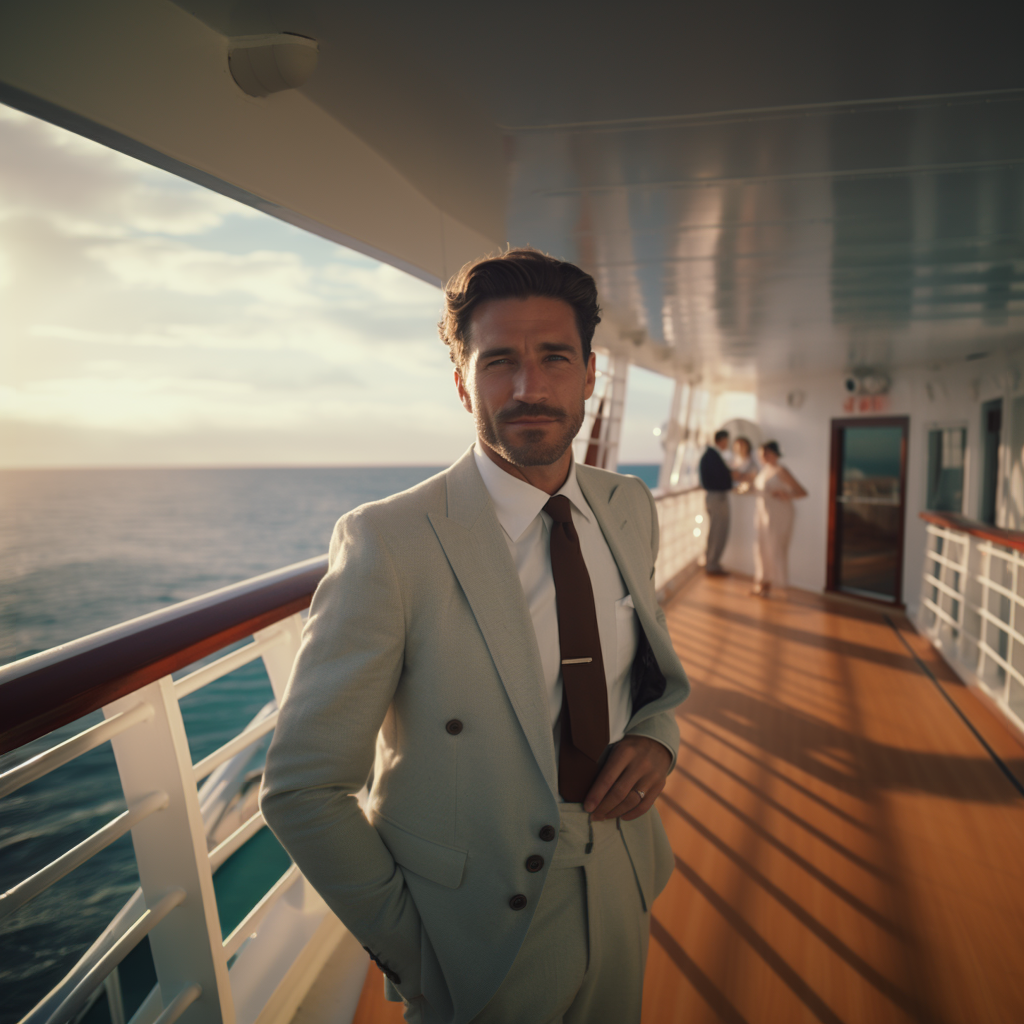
Alfons is the visionary leader and driving force behind Voyager Info’s success. As the Editor in Chief, he brings a wealth of experience and an unwavering passion for travel to the helm of our cruise-centric platform.
With a lifelong fascination for exploring new horizons, Alfons discovered his love for the ocean and cruising at a young age. From sailing across pristine Caribbean waters to embarking on daring expeditions to far-flung destinations, he has amassed a treasure trove of first-hand experiences in the world of cruising.
How Many Disney Cruise Ships Are There
How Many Formal Nights On Norwegian Cruise

Alfons is the visionary leader and driving force behind Voyager Info’s success. As the Editor in Chief, he brings a wealth of experience and an unwavering passion for travel to the helm of our cruise-centric platform. With a lifelong fascination for exploring new horizons, Alfons discovered his love for the ocean and cruising at a young age. From sailing across pristine Caribbean waters to embarking on daring expeditions to far-flung destinations, he has amassed a treasure trove of first-hand experiences in the world of cruising.

You may like
What culinary delights await on regent's new seven seas explorer?.
Lavish your taste buds with unparalleled culinary experiences on Regent's Seven Seas Explorer, where a hidden gem awaits to tantalize your senses.
- Indulge in gourmet French cuisine at Chartreuse with classic dishes and impeccable service.
- Experience sushi and seafood delights at Pacific Rim with standout sushi and creative offerings.
- Enjoy diverse flavors at Compass Rose and Prime 7, offering whole Maine lobster and USDA prime steaks.
- Satisfy cravings with indulgent desserts like Chocolate Soufflé and Tiramisu on Seven Seas Explorer.
Dining Options on Seven Seas Explorer
Gourmet French Cuisine Experience
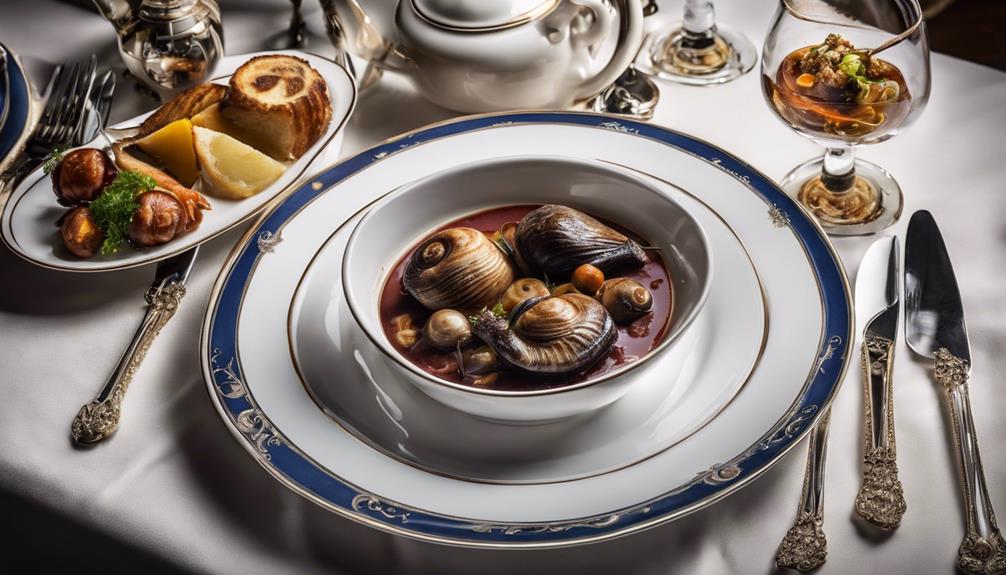
- Gourmet Delights : Indulge in a menu filled with classic French dishes prepared with a modern touch.
- Luxurious Atmosphere : Immerse yourself in a Parisian oasis with impeccable service and lavish surroundings.
- Exquisite Presentation : Each plate is a work of art, showcasing the chef's dedication to culinary perfection.
- Sophisticated Experience : From the first bite to the last sip, Chartreuse offers a refined dining experience that's truly unforgettable.
Sushi and Seafood Delights
Indulgent Desserts to Satisfy Cravings

- Decadent Chocolate Soufflé : Indulge in the rich and velvety chocolate soufflé served with a luscious warm chocolate sauce. The perfect balance of light and decadent flavors will leave you craving for more.
- Classic Crème Brûlée : Delight in the creamy texture of the crème brûlée, topped with a perfectly caramelized sugar crust. The contrast between the crunchy sugar and smooth custard makes every bite a luxurious experience.
- Rich New York Cheesecake : Treat yourself to a slice of New York cheesecake, featuring a creamy and dense texture complemented by the sweetness of fresh berries on top. It's a timeless dessert that exudes elegance.
- Traditional Tiramisu : Savor the layers of espresso-soaked ladyfingers and luscious mascarpone cheese in this classic tiramisu. The perfect balance of coffee, cream, and sweetness makes it a heavenly finale to any meal.
Diverse Flavors for Every Palate
What Is Promised to the Guests of Regent Seven Seas Cruises on Every Voyage?
What does guaranteed mean on regent seven seas cruises?, what is regent seven seas cruises known for?, are drinks included on seven seas explorer?.

Claire, a creative soul with an unquenchable thirst for storytelling, is an integral part of the Voyager Info team. As a dedicated writer, she weaves captivating narratives that transport readers to enchanting cruise destinations and beyond.
Claire’s love affair with writing began at an early age when she discovered the magic of words and their ability to craft worlds and emotions. Her innate curiosity led her to explore various literary genres, but it was travel writing that truly captured her heart. Drawing inspiration from her own globetrotting adventures and encounters with diverse cultures, Claire embarked on a journey to become a travel writer par excellence.
Discover Quito's Rich Heritage and Experiences: A How-to Guide
Mysterious and alluring, Quito's heritage beckons exploration – uncover the secrets that make this city a cultural gem.

- Explore Quito's cultural heritage through indigenous art and modern expressions.
- Indulge in Ecuadorian gastronomy blending traditional flavors with cultural influences.
- Enrich your visit with guided tours revealing Quito's diverse history and treasures.
- Immerse yourself in Quito's historic landmarks for a journey through vibrant stories and architecture.
Exploring Quito's Cultural Heritage
Indulging in Gastronomic Delights

Guided Museum Tours
Discovering Quito's Historic Landmarks

Immersive Heritage Experiences
Are There Any Local Superstitions or Folklore That Are Unique to Quito?
What are some lesser-known traditional dishes or drinks that visitors should try in quito?, can visitors participate in any hands-on cultural activities or workshops during their stay in quito?, are there any hidden gems or off-the-beaten-path historic landmarks in quito worth exploring?, how can visitors support local artisans and craftsmen while experiencing quito's cultural heritage?, cruising capri: a guide to the island's delights.
A voyage through the enchanting waters of Capri offers a tantalizing blend of history, beauty, and adventure – but what lies beneath the surface will leave you spellbound.

- Capri offers a mix of luxury, history, and natural beauty.
- Indulge in local cuisine with Italian and Mediterranean flavors.
- Explore charming villages, scenic landmarks, and stunning caves.
- Engage in thrilling adventures like snorkeling and boat trips.
Island Overview and History
Scenic Landmarks and Attractions
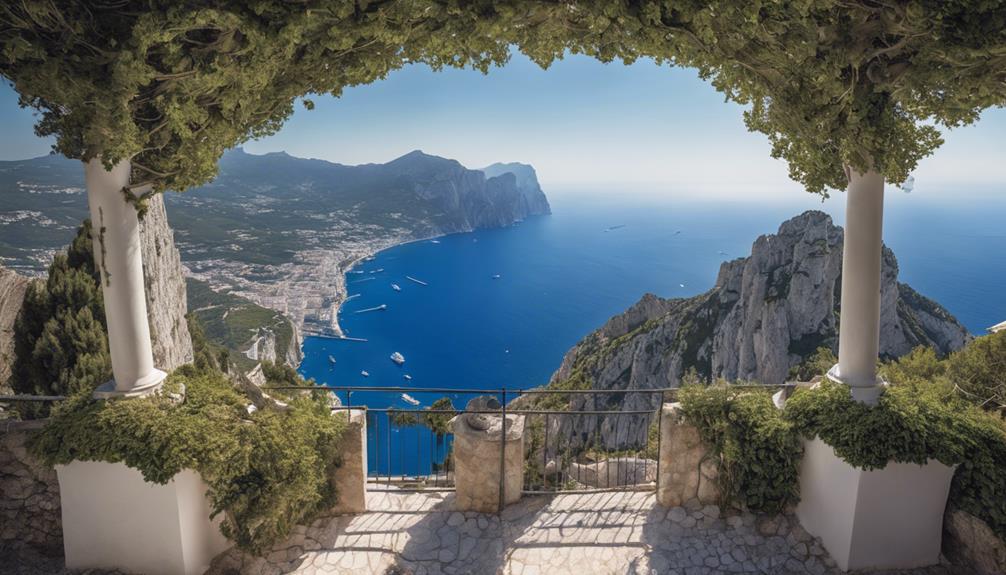
Culinary Delights and Local Cuisine
Charming Villages and Coastal Towns

Leisure Activities and Adventures
Is Capri Too Touristy?
Is private boat in capri worth it?, how long does it take to see the blue grotto capri?, what day is best to go to capri?.

Affiliate disclaimer
As an affiliate, we may earn a commission from qualifying purchases. We get commissions for purchases made through links on this website from Amazon and other third parties.

5 Must-Visit Temples on a Japan Cruise

Regina Charboneau: Culinary Ambassador of American Queen Voyages

Cruising From Baltimore: a Convenient and Relaxing Getaway Guide

The Ultimate Kid-Friendly Cruise Lines for Your Family Adventure

Cozumel's Vibrant Dining Scene: How to Experience Cuisine Cocktails and Ocean Views

5 Delights to Experience on a Day in Paradise: Jost Van Dyke

Azamara Onward: Origins, Renovation, and Future Plans
Anthony Bourdain: Unconventional Culinary Icon and Global Influencer

Authentic Tacos and Local Delights: A Culinary Adventure in Cabo San Lucas

Arctic Adventure: Uncharted Destinations With Le Commandant Charcot

Authentic Art, Exciting Auctions: The Ultimate Cruise Ship Experience!

Which Celebrity Cruise Ships Have Been Refurbished

What Drinks Can You Bring On Princess Cruise

How To Turn On Cruise Control Tesla Model 3

What Is The Weather Like On A Transatlantic Cruise In April

How To Set Cruise Control Tesla Model Y
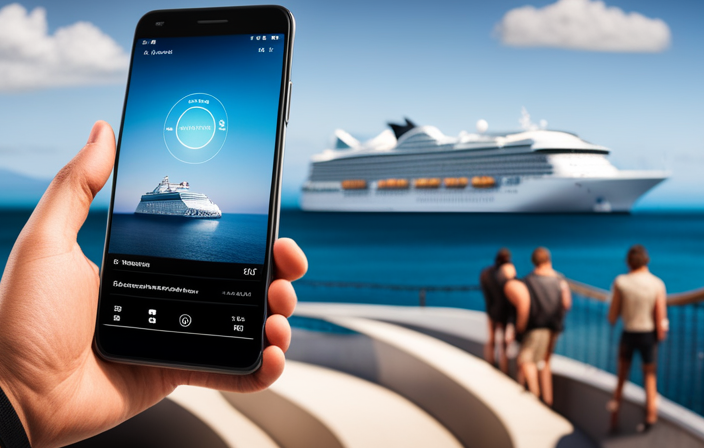
How To Check Weather For A Cruise
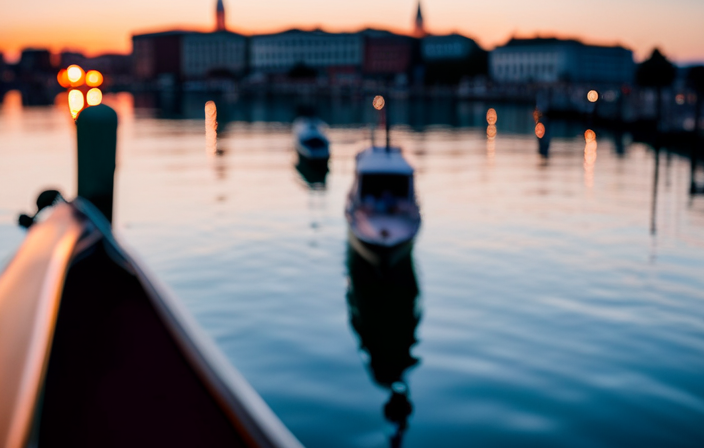
How To Get From Venice To Chioggia Cruise Terminal

How to Contact Someone on a Carnival Cruise Ship
Winter is here! Check out the winter wonderlands at these 5 amazing winter destinations in Montana
- Plan Your Trip
How Many Cruise Ships Have Sunk
Published: December 10, 2023
Modified: December 28, 2023
by Bernita Magill
Introduction
For many people, the idea of embarking on a cruise is a dream come true – an opportunity to relax, explore exotic destinations, and indulge in luxurious amenities. Cruises have become increasingly popular over the years, offering a unique vacation experience that combines travel, entertainment, and relaxation in one package.
However, amidst the allure of cruise ships, there is always the lingering question of safety. While the majority of cruises sail smoothly, there have been some high-profile incidents and accidents that have raised concerns about the safety of these floating cities. From historical disasters to more recent mishaps, the sinking of cruise ships has captured the public’s attention and sparked discussions about maritime safety and regulations.
In this article, we will delve into the realm of cruise ship disasters, exploring both historical incidents and more recent cases. We will examine the causes and impacts of cruise ship sinking, as well as the safety measures and regulations that have been implemented to prevent such incidents from occurring. So sit back, relax, and join us on this journey as we explore the fascinating and sometimes harrowing world of cruise ship disasters.
Historical Cruise Ship Disasters
Throughout history, there have been several notable cruise ship disasters that have left a lasting impact on the industry. These incidents serve as reminders of the potential dangers that can arise at sea, even on a seemingly resilient and well-equipped vessel.
One of the most infamous cruise ship disasters occurred in 1912 when the RMS Titanic, a British luxury liner, struck an iceberg and sank during its maiden voyage. The tragedy claimed the lives of over 1,500 people and forever changed the landscape of maritime safety. The sinking of the Titanic highlighted the need for stricter regulations, including the requirement of sufficient lifeboats for all passengers and crew.
Another significant cruise ship disaster took place in 1956 when the SS Andrea Doria, an Italian ocean liner, collided with the MS Stockholm off the coast of Nantucket, Massachusetts. The crash resulted in the deaths of 46 people and caused the Andrea Doria to sink. This incident led to improvements in shipbuilding and navigation technology, as well as the adoption of international collision avoidance regulations.
Fast forward to the 21st century, and we encounter the Costa Concordia disaster in 2012. This Italian cruise ship ran aground and partially capsized off the coast of Giglio Island, resulting in the loss of 32 lives. The incident, caused by human error, brought attention to the importance of crew training, emergency procedures, and responsible navigation.
These historical cruise ship disasters have served as important milestones in the development of maritime safety protocols. They have prompted the industry to prioritize the implementation of robust safety measures, technology advancements, and stricter regulations to ensure the well-being of passengers and the prevention of future incidents.
Modern Cruise Ship Incidents
While cruise ship disasters from history have left a lasting impact on the industry, modern times have also seen their fair share of incidents and accidents that have garnered media attention and raised concerns about cruise ship safety.
One noteworthy incident occurred in 2013 when the Carnival Triumph experienced an engine fire that left the ship adrift in the Gulf of Mexico for several days. Passengers endured deplorable conditions with limited power, food, and working toilets. The incident highlighted the importance of backup systems and emergency response protocols to prevent such situations from escalating.
In 2019, the Viking Sky found itself in a treacherous situation off the coast of Norway when it experienced engine failure during rough seas. The ship was at risk of drifting onto the rocky shore, and over 1,300 passengers had to be airlifted to safety. This incident shed light on the importance of preparedness for adverse weather conditions and the need for effective evacuation procedures.
The COVID-19 pandemic also had a significant impact on the cruise industry. In early 2020, several ships were plagued by outbreaks of the virus, leading to quarantines, cruise cancellations, and a worldwide halt in cruise operations. These incidents highlighted the need for enhanced health and safety measures, including extensive testing, onboard medical facilities, and comprehensive sanitation protocols to prevent the spread of infectious diseases.
While modern cruise ship incidents may not have resulted in the catastrophic loss of life seen in historical disasters, they have brought attention to various safety concerns, including mechanical failures, adverse weather conditions, and health crises. The lessons learned from these incidents have contributed to ongoing efforts to improve safety measures, emergency protocols, and overall preparedness in the cruise industry.
Causes of Cruise Ship Sinking
The sinking of a cruise ship can occur due to various causes, ranging from natural disasters to human error. Understanding these factors is crucial in developing safety measures and protocols to prevent such incidents. Let’s explore some of the common causes of cruise ship sinking:
1. Collisions: Collisions with other ships, icebergs, or even submerged objects can lead to a cruise ship sinking. Poor visibility, navigational errors, or equipment failures can contribute to these accidents.
2. Grounding: When a cruise ship runs aground, it can cause significant damage to the vessel’s hull, potentially leading to its sinking. This can happen due to navigational errors, shallow waters, or unexpected changes in tides or currents.
3. Mechanical failures: The failure of key systems onboard, such as propulsion, steering, or power generation, can compromise the safety and stability of the ship. Mechanical failures can result from equipment malfunctions, poor maintenance, or inadequate inspections.
4. Fire: A fire onboard a cruise ship can rapidly escalate, jeopardizing the safety of passengers and crew. Fires can be caused by electrical faults, fuel leaks, or incidents in the ship’s galley or engine room.
5. Extreme weather conditions: As cruise ships encounter various weather conditions, severe storms, hurricanes, or rogue waves can pose significant risks. The force of the waves or strong winds can affect the stability of the vessel, potentially leading to capsizing or sinking.
6. Human error: Mistakes made by crew members or officers, such as navigation errors, lack of proper training, or failure to follow established protocols, can contribute to cruise ship sinking incidents. Human error can also include inadequate evacuation procedures or delayed response to emergencies.
It is important to note that while these causes can lead to cruise ship sinking, the occurrence of such incidents is rare. The cruise industry has implemented strict safety regulations and protocols to minimize the risks associated with these causes. Regular inspections, crew training, and advanced technologies are employed to ensure the safety and stability of modern cruise ships.
By understanding the causes of cruise ship sinking, the industry can continue to improve safety measures, training programs, and technological advancements to prevent and mitigate the potential risks associated with these causes.
The Impact of Cruise Ship Sinking
Cruise ship sinkings can have far-reaching impacts that extend beyond the immediate loss of life and the monetary damages. These incidents can affect various stakeholders, including passengers, crew members, cruise lines, and the broader tourism industry.
For passengers and crew members directly involved in a sinking, the impact is profound. Lives may be lost, injuries sustained, and trauma experienced. The emotional and psychological toll can be long-lasting, leading to a fear of traveling at sea and a loss of confidence in the cruise industry.
Cruise lines themselves face significant financial and reputational consequences following a sinking incident. The cost of search and rescue operations, legal settlements, and insurance claims can be substantial. Additionally, the negative publicity and public scrutiny can result in decreased bookings and revenue. Rebuilding public trust and restoring the reputation of the cruise line may take years.
The broader tourism industry can also feel the effects of a cruise ship sinking. Local economies relying on cruise tourism may suffer a downturn in revenue, as port visits and tourist activity decline. This impact can trickle down to businesses such as restaurants, hotels, and shops that depend on cruise passengers for their livelihood.
Governments and regulatory bodies often respond to cruise ship sinkings by strengthening safety regulations and implementing stricter oversight. This can lead to increased compliance costs for cruise lines, as well as the need for additional safety measures, equipment upgrades, and crew training. While these steps are necessary to prevent future incidents, they can also impose financial burdens on the industry.
Despite the negative impact of cruise ship sinkings, the industry has shown resilience and a commitment to enhancing safety measures. Cruise lines have invested in new technologies, improved emergency response protocols, and implemented rigorous inspections and safety audits to prevent similar incidents from occurring in the future.
It is crucial for both cruise lines and regulatory bodies to continue prioritizing passenger safety, crew training, and ongoing improvements in emergency response procedures. By doing so, the negative impact of cruise ship sinkings can be minimized, and the industry can continue to provide enjoyable and safe vacation experiences for travelers.
Safety Measures and Regulations
The cruise industry has made significant advancements in safety measures and regulations to prevent cruise ship sinkings and ensure the well-being of passengers and crew members. These measures are continually evolving to address emerging risks and enhance the overall safety of cruise ships.
1. International Maritime Organization (IMO) regulations: The IMO, a specialized agency of the United Nations, sets international standards and regulations for the safe operation of ships, including cruise vessels. These regulations cover areas such as construction standards, stability requirements, emergency drills, and crew training.
2. SOLAS Convention: The International Convention for the Safety of Life at Sea (SOLAS) is a treaty that outlines minimum safety standards for passenger ships, including cruise ships. SOLAS covers various aspects, including structural integrity, fire protection, lifesaving equipment, and navigation safety.
3. Improved construction standards: Cruise ships are now built to adhere to strict construction standards that ensure their structural integrity. These standards encompass the design of the hull, stability systems, and the incorporation of redundant safety features to mitigate the risks of grounding, collisions, and mechanical failures.
4. Enhanced emergency response and evacuation procedures: Cruise lines have implemented comprehensive emergency response plans to address a range of potential incidents. These plans outline procedures for crisis management, passenger evacuation, and coordination with local authorities and rescue agencies.
5. Crew training and drills: Crew members undergo extensive training to handle emergency situations effectively. Regular drills, including fire drills and abandon ship exercises, ensure that crew members are well-prepared and can respond promptly in case of an emergency.
6. Advanced navigation and safety technologies: Cruise ships are equipped with state-of-the-art navigation systems, including radar, sonar, and GPS, to ensure accurate positioning and collision avoidance. Additionally, the incorporation of safety technologies such as fire detection and suppression systems, advanced life-saving equipment, and improved communication systems enhances the overall safety of the vessel.
7. Independent inspections and audits: Cruise ships undergo regular inspections and audits carried out by recognized classification societies and flag states. These independent assessments verify compliance with safety standards and regulations, ensuring that ships meet all necessary requirements.
8. Enhanced health and sanitation protocols: The ongoing COVID-19 pandemic has prompted the implementation of additional health and sanitation measures. Cruise lines have implemented comprehensive sanitization procedures, increased medical facilities and staffing, and adopted testing protocols to prevent the spread of infectious diseases.
The implementation of these safety measures and regulations across the cruise industry demonstrates a commitment to passenger safety and the prevention of cruise ship sinkings. While no system can completely eliminate all risks, continuous improvement, training, and adherence to these standards are crucial for maintaining a safe and enjoyable cruising experience.
Famous Cruise Ship Sinking Cases
Throughout history, there have been several high-profile and memorable cruise ship sinking cases that have captured worldwide attention. These incidents serve as reminders of the potential risks and challenges faced by cruise ships on the open seas. Let’s explore some of the most famous cruise ship sinking cases:
1. RMS Titanic: Arguably the most well-known cruise ship sinking of all time, the RMS Titanic sank on April 15, 1912, after hitting an iceberg in the North Atlantic Ocean. The tragedy claimed the lives of over 1,500 people, making it one of the deadliest maritime disasters in history. The sinking of the Titanic sparked significant changes in maritime safety regulations and highlighted the need for sufficient lifeboats and improved communication systems.
2. Costa Concordia: In 2012, the Costa Concordia, a luxury Italian cruise ship, ran aground off the coast of Giglio Island, Italy. The ship partially capsized, resulting in the loss of 32 lives. The incident was attributed to the captain’s error and deviation from the predetermined route. The salvage operation to remove the wreck was one of the most challenging and expensive in maritime history.
3. MV Wilhelm Gustloff: During World War II, the MV Wilhelm Gustloff was sunk by Soviet submarine torpedoes in the Baltic Sea. The German ship was serving as a refugee vessel, carrying thousands of civilians fleeing the advancing Soviet forces. The sinking resulted in the deaths of an estimated 9,000 people, making it the deadliest sinking in maritime history.
4. Sewol Ferry: In 2014, the South Korean ferry Sewol capsized and sank, claiming the lives of 304 passengers, mostly high school students. The incident was attributed to overloading, improper storage of cargo, and the crew’s negligence. The tragedy led to significant reforms in South Korea’s maritime safety regulations and raised awareness of the importance of passenger safety and emergency preparedness.
5. MS Estonia: The MS Estonia, a passenger and car ferry, sank in the Baltic Sea in 1994 during a storm. The exact cause of the sinking remains debated, but it is believed that the failure of the ship’s bow visor led to a rapid influx of water. The incident resulted in the loss of 852 lives, making it one of the deadliest European shipwrecks in modern times.
These famous cruise ship sinking cases serve as sobering reminders of the potential hazards that can befall even the most modern and well-equipped cruise ships. They highlight the importance of stringent safety measures, crew training, and adherence to regulations in order to prevent similar tragedies in the future.
The history of cruise ship sinkings is marked by both tragic disasters and lessons learned. From the infamous sinking of the RMS Titanic to more recent incidents like the Costa Concordia, these events have shaped the cruise industry’s commitment to safety and the well-being of passengers and crew members.
Advancements in technology, improved regulations, and extensive training programs have significantly enhanced the safety measures employed by cruise lines. International organizations such as the IMO and conventions like SOLAS have played crucial roles in setting and enforcing standards that address the various risks faced by cruise ships.
While no industry is immune to unforeseen events, the cruise industry has demonstrated resilience and a dedication to continuous improvement in safety measures. From strengthened construction standards to enhanced emergency response procedures, the focus is on mitigating risks and ensuring the safety of all onboard.
Famous cruise ship sinking cases serve as reminders of the importance of these safety measures. They have motivated the industry, regulatory bodies, and governments to collaborate and implement necessary changes to prevent similar incidents from occurring in the future.
As travelers, it is essential to be aware of safety protocols when embarking on a cruise. Familiarize yourself with emergency procedures, follow directions from crew members, and make note of evacuation routes. Cruise ship companies strive to prioritize passenger safety, and by being informed and prepared, passengers can enjoy their voyages with peace of mind.
Through ongoing collaboration, technological advancements, and a commitment to safety, the cruise industry will continue to thrive and provide unforgettable experiences for travelers worldwide. By learning from the past and investing in the future, cruise ships can navigate the seas with confidence and maintain their status as one of the most popular vacation choices.

- Privacy Overview
- Strictly Necessary Cookies
This website uses cookies so that we can provide you with the best user experience possible. Cookie information is stored in your browser and performs functions such as recognising you when you return to our website and helping our team to understand which sections of the website you find most interesting and useful.
Strictly Necessary Cookie should be enabled at all times so that we can save your preferences for cookie settings.
If you disable this cookie, we will not be able to save your preferences. This means that every time you visit this website you will need to enable or disable cookies again.

How Often Do Cruise Ships Sink?
By: Author David Chapman
Posted on Last updated: February 21, 2024
Categories Health & Safety , LEARN
Modern cruise ships are engineered to withstand the toughest conditions and offer the utmost safety and reliability. Nevertheless, people may wonder how often do cruise ships sink.
The short answer: It’s rare. In the last 50 years, a ship has sunk during the course of a cruise less than once per decade.
Nevertheless, while it rarely happens, we can all easily think of terrible disasters where it did happen – such as the century-old disaster of the RMS Titanic or the decade-old capsize of Costa Concordia. So, how often do these modern marvels of the sea meet a similar fate? The best way is to dive into the history of known cruise ship sinkings to understand the probability of it happening to today’s state-of-the-art vessels.
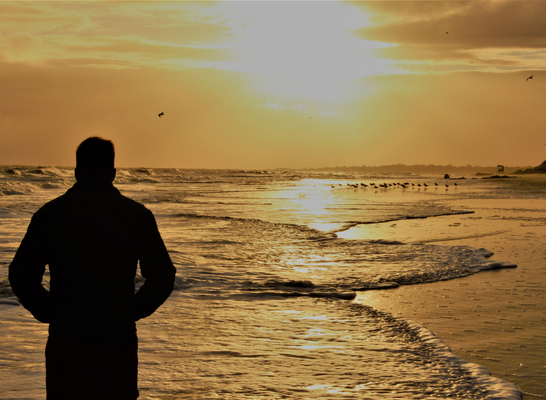
How Often Do Cruise Ships Sink? It’s Rare!
Cruise ships are some of the largest and most luxurious vessels on the water and are designed to be safe and reliable. However, it is not uncommon for cruise ships to encounter problems at sea; in some cases, these problems can lead to the ship’s sinking. Over the past 100 years since the RMS Titanic sank in 1912, only 18 cruise ships and some ocean liners have been publicly known to have sunk. And, over the past 50 years , only four cruise ships have sunk while navigating on a cruise .
To fully understand the rarity of a cruise ship sinking, let’s examine the known causes of these disasters, beginning with the iconic RMS Titanic.
Exploring Past Sunk Cruise Ships – RMS Titanic In 1912 To Orient Queen In 2020
The RMS Titanic was a luxurious passenger liner known for its grandeur and advanced safety features. Even though the Titanic was an ocean liner rather than a cruise ship , it was the largest ship of its time and was thought to be unsinkable due to its watertight compartments. However, on April 15, 1912 , the Titanic struck an iceberg, broke in half, and sank in the North Atlantic Ocean, resulting in the loss of over 1,500 lives.
The Titanic disaster profoundly impacted the maritime industry and sparked significant changes in how ships were designed and built. One major factor that contributed to the number of lives lost during the sinking was the lack of enough lifeboats on board.
The ship was carrying only enough lifeboats for about half of the passengers and crew, which proved to be a tragic oversight when the ship began to sink.
As a result of the Titanic disaster, new regulations were put in place to ensure that all passenger ships, including cruise ships, were required to carry sufficient lifeboats for passengers and crew on board. Additionally, new safety standards were implemented to improve ships’ design and construction, including stronger materials and more watertight compartments.
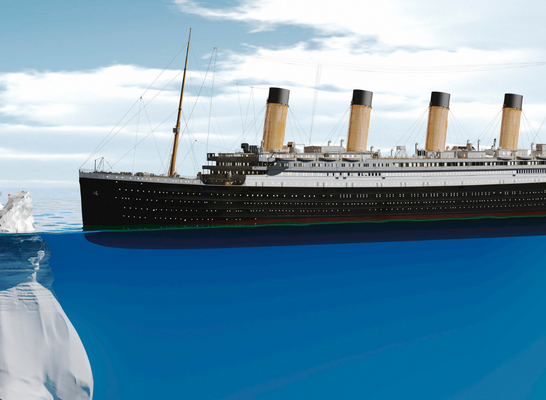
Fortunately, since 2020, no confirmed cruise ship capsizing or sinking has occurred. The last one was the Orient Queen suffering no crew or passenger casualties, which sank due to a nearby ammonium nitrate explosion while moored.
Below is a list of some available records of cruise ship sinkings since the iconic Titanic .
Comparing 20th To 21st Century Maritime Disasters
The tale of two disasters – the Titanic and the Costa Concordia – highlights the importance of ship design in terms of safety. When the Titanic collided with the iceberg in 1912, it tore a 300-foot gash in the ship’s hull, sending freezing water flooding into the base of the vessel.
This caused the back of the ship to tilt upward, leading to a catastrophic breakage that made it harder to evacuate. The lack of lifeboats was also a major factor in the high death toll of over 1,500 people, making it one of the worst peacetime maritime disasters in history.
Fast forward to 2012, and the Costa Concordia disaster (now more than ten years ago) off the coast of Italy provides a modern-day equivalent. When the cruise ship struck a rock reef, it tore a 16-foot gash in the hull around 25 feet below sea level. The ship began flooding, the engines and generators went offline, and it began to sink.
However, the ship’s design allowed it to lean heavily to its side and sink much more slowly, allowing the crew to initiate a hasty evacuation. Thanks to a sufficient supply of lifeboats, they evacuated the passengers over six hours, ultimately resulting in a death toll of 34 people. Most of these deaths were caused by the ship tilting and passengers falling into the water.
Three people were even rescued from the ship over 24 hours after the incident, thanks to the slow sinking of the vessel. While the Costa Concordia disaster was one of the worst maritime disasters of the 21st century, it was nowhere near as catastrophic in terms of loss of life as the disasters of the 20th century.
When you compare modern cruise ships to Titanic-era ships , you can readily see that safety has improved considerably. As demonstrated in the table shown above by the low number of cruise ships to sink in recent history, modern vessels are generally better equipped to survive a disaster than their predecessors. And as you saw, the number of lives lost had decreased to nearly zero.

Why Don’t Modern Cruise Ships Sink As Often?
When people buy tickets for a cruise, they’re not just looking for a vacation – they’re also buying safety and peace of mind. They want to know that their needs will be taken care of and that they will be safe for the duration of the trip. And cruise ships are designed with this in mind. These floating resorts are built to withstand all sorts of rough conditions that would have sunk ships of the past.
But it hasn’t always been this way. During the heyday of sea travel, it was fairly common for ships to be lost at sea due to rough weather, enemy attacks, or collisions with icebergs. However, the sinking of the Titanic in 1912 and the RMS Empress of Ireland in 1914 made it clear that something needed to change.
These were both sturdy ships and were ocean liners built for long-distance travel. But to achieve this reliability, they sacrificed maneuverability. They would be rock-solid if everything went according to plan, but there was little hope of saving the voyage if something went wrong.
Today, however, cruise ships are a different story. These vessels are typically made of lighter materials and are much more agile, allowing them to navigate rough seas easily.
Cruise Ship Stability: What Keeps Them Afloat?
Have you ever wondered how cruise ships manage to stay afloat despite their massive size and seemingly top-heavy design? This is often a big topic of discussion, and the answer lies in the careful balance of weight distribution and stability.
When you board a large cruise ship, you are stepping onto a floating resort with thousands of staterooms, dozens of restaurants, and endless recreation opportunities. Yet, despite all these amenities, cruise ships remain stable and steady on the water despite their weight.
This is thanks to a combination of factors, including the ships:
- Machinery’s placement
- Stabilizer fins use
- Modern navigation systems
So how does it all work? First, it’s important to understand that only a small portion of the ship is actually below the waterline. This means that most of the weight is concentrated above the water, making the ship appear top-heavy. But the ship’s design actually works in its favor, pulling down on the water to provide balance and stability.
The key to this balance is the ship’s center of gravity. While the goal is to keep the center of gravity as close to the ship’s middle as possible, this is not always possible due to the weight of the ship’s engines and other machinery. As a result, ships usually have a heavier bottom half than a lighter top half to compensate for this.
What Happens If An Obstacle Is Unavoidable?
Cruise ships will do their best to take detours to avoid rough weather in the event of a storm at sea. But sometimes, a storm comes on fast and hard, and the ship must rely on more than just its center of gravity to stay afloat. That’s where the design of the ship’s hull comes into play.
- Cruise ships have rounded edges on the bottom of the hull, which makes it easier for the ship to roll with the waves and then return to its original position. They also have several ballast tanks, which are water-filled tanks that provide additional stability and distribute the load evenly. These features help the ship handle rough seas in a way that older ships could not.
Of course, no system is perfect, and cruise ships are not invincible. They typically have less hull strength than ocean liners but are equipped with better radars to avoid obstacles like icebergs. If a cruise ship were to hit an iceberg, it could potentially cause serious damage to the hull.
Are Cruise Ships Failsafe?
There is no possible closer answer than the word “almost.” While the Costa Concordia disaster in 2012 was a shocking reminder that no vessel is invincible, modern cruise ships are designed with safety in mind. From advanced navigation systems to sturdy hulls and ballast tanks, these ships are built to weather even the roughest of storms.
And in the rare event of a catastrophic disaster, cruise ships have enough safety features in place to allow for a safe evacuation.
As to the ship’s safety, you can rest assured that cruise ship designers have done everything in their power to keep you and your fellow passengers safe.
Closing Thoughts
While cruise ships have sunk or encountered a disaster in the past, the likelihood of your ship sinking is close to minuscule. Modern ship design and protocols are in place to prevent things like weather and obstacles from ruining your cruise or endangering passengers onboard.
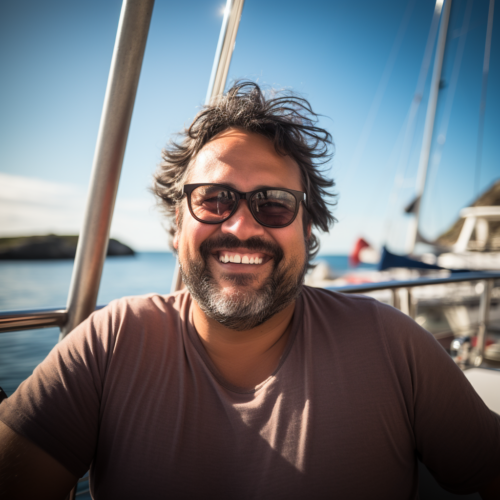
David Chapman
Contributor
Keep up with the latest cruise tips and insights! Follow us on Pinterest:
Related articles.

- Dominican Republic
- Riviera Maya
- New York City
- All Destinations >
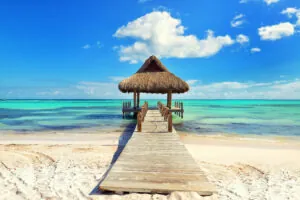
- All-Inclusive
- Kid-Friendly
- All Collections >
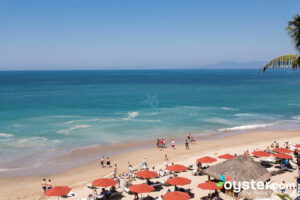
- What's New
- Rookie Mistakes
- Luxury for Less
- Destination Cheat Sheets
- Travel Safety
- Travel Tips
- Hidden Gems
- Steamy Travel
- Health and Wellness Travel
- All Stories >

- Adults Only Travel
By proceeding, you agree to our Privacy Policy and Terms of Use .
The 9 Worst Cruise Ship Disasters

The Titanic may be the most famous ship disaster, but surprisingly, it’s not even close to being the deadliest wreck that ever occurred on a luxury liner. If you’re trying to dissuade someone from taking a cruise, you should show them this list of maritime misadventures presented in no particular order. Disclaimer: The vast majority of cruises sail without incident and are safe and not filled with poop. (Oh yeah, we’ll get there.) Get your plate ready for a buffet of high-seas horror.
1. RMS Titanic

F.G.O. Stuart (1843-1923) {{PD-old}} /Wikimedia Commons
The many experts in 1912 who considered the Titanic “unsinkable” were to be proven wrong on the boat’s maiden voyage from Southampton to New York City. Thomas Andrews had designed the ship to withstand head-on collisions and rammings from other ships. However, the North Atlantic Ocean iceberg that took down the vessel scraped through five of its 16 watertight compartments. The boat would have reportedly remained afloat if it had only gone through four. Like other systems at the time, the Titanic's lifeboats were designed to shepherd passengers to nearby rescue ships, not take them to shore. Unfortunately, help was many hours away in the wee hours of April 15 when the boat was going under. The poor crew organization also caused many lifeboats to leave the ship at far less than full capacity. Plus, they only had enough boats for about a third of the onboard. As a result, more than 1,500 people died — either on the ship or in the icy waters, waiting for help. A recent theory suggests a fire that started in the hull before the ship set sail weakened the vessel’s steel walls, making it susceptible to an iceberg that normally wouldn’t have caused as much damage.
2. Eastern Star’s Dongfang zhi Xing
In 2015, Dongfang zhi Xing was traveling on the Yangtze River in China when a thunderstorm struck, and the boat capsized. Ships in the area were warned that bad storms were coming and told to take precautions, but it is unclear if the Dongfang zhi Xing ever received the warnings and continued to sail. The ship was met with winds of up to 72-85 mph, and ultimately, a downburst (a strong downward wind) caused the ship to capsize and sink. Out of the 454 people on board, only 12 survived, making the total number of dead 442.
3. Carnival Cruise Line’s Triumph

DVIDSHUB/Flickr
A generator fire on Carnival Cruise Lines’s Triumph (now called Carnival Sunrise) left the ship powerless, and a late-night comedy punchline was born: “The Poop Cruise.” Without working bathrooms, passengers were forced to drop their payloads into red “hazardous waste” bags and stuff them into garbage cans left in the hall. Passengers described carpets soaked with more than two inches of raw sewage. News reports described the scene as a “shanty town” and a “new circle of hell.” One passenger reportedly called her husband and told him that their 12-year-old daughter had Skittles for breakfast. It took four days for the Triumph to be towed from the Gulf of Mexico to Mobile, Alabama, where it was possible to smell the ship from the dock. Later, 31 passengers claimed long-lasting damage, including PTSD, and sued. After the verdict, 27 of them split $118,000, many earning less than $3,000 (minus legal fees) for their troubles.
4. Costa Concordia

European Commission DG ECHO/Flickr
One of the biggest passenger ships ever wrecked, the Costa Concordia had 17 decks, six restaurants, a three-story theater, and enough room for 4,200 vacationers. On January 13, 2012, Captain Francesco Schettino agreed to a request by the ship’s chief maître d’, Antonello Tievoli, and sailed closer to Isola del Giglio than normal. Why? Tievoli, a native of Giglio, wanted to impress and “salute” local residents. Unfortunately, Captain Schettino turned off the ship’s alarm for the computer navigation system and later admitted he thought he knew the waters well enough to navigate by sight. However, the ship’s first mate testified that the captain had left his glasses in his cabin and requested them. The Costa Concordia struck an underwater rock, capsized, and sank, killing 32 passengers. Schettino’s worst maritime sin? He abandoned the ship with 300 passengers still onboard. A Coast Guard officer in contact with the ship at the time of the sinking claimed he told Schettino to get back onboard. After being convicted of manslaughter and pursuing several appeals, Schettino only started his 16-year prison sentence in May of 2017. The salvage effort (the ship was completely dismantled) was the largest effort of its kind.
5. SS Eastland
Launched in 1903, the SS Eastland was a passenger ship based in Chicago and used for tours. Although the ship had noted listing (tilting) since its inception and some measures had been taken to rectify this, the SS Eastland was still suffering from being top-heavy when boarding for a cruise in 1915. The ship was meant to sail from Chicago to Michigan City, Indiana, carrying workers from Western Electric Company’s Hawthorne Works for a picnic. On July 24, 2,572 passengers boarded, with many congregating on the open upper decks. While still docked, the ship began to list to the port side, and reportedly, at some point, more passengers rushed to the port side, causing the ship to roll onto its side completely. Despite the river’s bottom being just 20 feet below and the shore being about the same distance, a total of 844 passengers and crew members died, including 22 entire families.
6. Royal Pacific
When the Royal Pacific was first launched as a passenger ferry in 1964, it could carry 250 passengers, 91 cars, and 16 trucks. Sold and converted into a cruise ship in the late 1980s, the boat’s maiden voyage was a two-night “cruise to nowhere” from Singapore and sailed by Phuket, Malacca, and Penang before returning home. At around 2 a.m., when most passengers were asleep, the crew heard a loud bang, and the plates on the buffet table crashed to the ground. A Taiwanese trawler, Terfu 51, had accidentally rammed the ship, leaving a six-foot gash in the side. As the trawler pulled away, there was a deafening sound of metal scraping against metal. The PA system wasn’t working properly on the boat, but the safety officer ran downstairs to survey the damage. When he returned, he told everyone to put on their life jackets. Reports vary about how many passengers were impacted — most tallies number 30 dead and 70 injured. Several passengers also complained that a mix of Greek-, English- and Mandarin-speaking crew members led to few people understanding what anyone was saying.
7. SS Morro Castle
The story of the SS Morro Castle is so dreadful it’s surprising no Hollywood producer has turned the tale into a horror movie. Director Fritz Lang collaborated on a script about the tragedy, and named it “Hell Afloat” (which is a pretty apt description), but it was never made. Between 1930 and 1934, the SS Morro Castle regularly shuttled 480-plus passengers between Havana and New York. While onboard, there was no Depression to worry about and no Prohibition, which meant plenty of booze-filled partying. However, the September 1934 return sail from Cuba to the Big Apple seemed cursed. On September 7, Captain Robert Wilmott complained of stomach trouble after eating dinner and retired to his cabin, where he later died of an apparent heart attack. Chief Officer William Warms took command, and a few hours later, around 3 a.m. on September 8, a fire started in one of the storage lockers. The crew’s attempts to fight the fire were haphazard and inadequate, and soon, the blaze couldn’t be contained. Many crew members abandoned the ship, leaving confused passengers to fend for themselves in the dark, smoky hallways. Some jumped from the deck to their death in the water. Rescuers lined up on the Jersey Shore to meet the lifeboats carrying passengers. The next morning, the burning, black hull of the SS Morro Castle ran aground at Asbury Park, New Jersey. Of the 549 people aboard the cruise, 86 guests and 49 crew members died.
8. Royal Caribbean’s Explorer of the Seas
A cruise can be an oasis of calm in rough waters, but it’s also a petri dish of disease where viruses ricochet from passenger to passenger. In 2014, the Royal Caribbean’s Explorer of the Seas cruise from New Jersey to the Caribbean earned the dubious honor of being the ship with more sick passengers than any other boat trip since the Centers for Disease Control and Prevention started keeping statistics more than 20 years ago. An estimated 700 passengers and crew members were sick at some point. Most cruise ship illnesses result from norovirus, that causes inflammation of the stomach and large intestines and regular trips to the “head.” If you’re wondering how to stay healthy on a cruise with sick passengers, plenty of handwashing (and avoiding ill people) is key. Bugs pass quickly through contact with ship railings, bathroom doors, and buffet food.
9. MTS Oceanos
Built by a French company and first launched in 1952, the MTS Oceanos was purchased by a Greek company in 1976. On August 3, 1991, Oceanos set sail for East London, South Africa, and headed north for Durban, led by Captain Yiannis Avranas. The ship reportedly headed into 40-knot winds and 30-foot swells, and thus, the typical sail-away outdoor deck party with British entertainers Moss and Tracy Hills was moved to an indoor lounge. The sea conditions worsened that night, leading to the ship rolling from side to side, and eventually, an explosion was heard due to a lack of repairs for the waste disposal system. This all led to the ship losing power and water filling its generator room, so the generators were shut down and the ship was led adrift. A distress call was sent and answered by numerous South African helicopters and a Dutch container ship. Shockingly, the captain and many crew members were among the first to be airlifted to shore, leaving the entertainment staff to coordinate the rescue efforts and help passengers to safety. All 571 passengers and crew members were saved by the time the ship sank nose-first into the sea.
These Are The Most Dangerous (& Remote) Cruise Routes On Earth
Thinking of a thrilling cruise? From icy waters to isolated islands, these cruise routes are the most dangerous and remote.
- Adventurous remote cruises offer a chance to explore uncharted territories and connect with nature off the beaten path.
- Remote routes have unique challenges including unpredictable weather, rough seas, and limited access to resources and medical facilities.
- The world's most remote and dangerous cruise routes, like the Drake Passage and the Bering Sea, offer unforgettable and challenging experiences.
The world is full of hidden places, beautiful islands, and cultures untouched by time. There are plenty of epic cruise lines for every type of traveler , but for the adventurous, remote cruises are a chance to explore uncharted territories. Imagine sailing next to towering glaciers in Antarctica, seeing the volcanic wonders of the Galapagos Islands and their fascinating wildlife , or cruising through the crystal-clear waters of Raja Ampat, full of marine life.
These trips offer an escape from the ordinary and a chance to connect with nature and visit places far from typical tourist spots. However, exploring beyond familiar harbors means facing potential risks. Unlike traditional cruises offering family-friendly destinations with established routes and easy access to resources, remote routes come with unique challenges.
Unpredictable weather, rough seas, and limited access to medical facilities are some things to consider for those seeking adventure off the beaten path. Still, that doesn’t stop the excited traveler from exploring remote regions. With that aside, these are some of the most remote and dangerous cruise routes on Earth.
The Strangest Theme Cruises You Can Go On 2024-2025
5 the drake passage – antarctica, one of the most treacherous voyages for ships to make.
Spanning roughly 600 miles (1,000 kilometers) wide, the Drake Passage is a climatic and ecological divide, separating the cool, temperate waters of the Southern Ocean from the frigid polar regions.
Unimpeded by any landmass, strong westerly winds whip up colossal rogue waves (which can impact cruise ships) , sometimes reaching over 40 feet (12 meters) in height. Besides turbulent waters and giant icebergs, temperatures in the Drake Passage can plummet well below freezing, especially in the Southern Hemisphere's winter months (June to August).
The 1916 sinking of the schooner "Endurance," carrying Antarctic explorer Ernest Shackleton, serves as a stark reminder of the unforgiving nature of these waters. Tragically, the passage's unforgiving nature was recently highlighted in November 2022 when a passenger onboard the Viking Polaris died after a large wave struck the ship during severe weather.
This region of the world is a harsh and unforgiving place, but successful, reputable cruises to Antarctica offer a sense of accomplishment and unforgettable memories.
How To Plan For A Cruise To Antarctica (Plus Helpful Tips)
4 the northwest passage – arctic, a frigid challenge through the arctic labyrinth.
The Northwest Passage is not a single, well-defined channel but rather a complex network of waterways snaking through islands and around the northern coast of Canada. Sea ice plays a dominant role, dictating the very possibility of navigation.
Besides thick sea ice and unpredictable weather, the region's remoteness means limited resources and assistance in an emergency. Medevacs from the harsh Arctic environment can be treacherous and time-consuming.
When it comes to accidents and recent incidents, the ill-fated Franklin Expedition of the 1840s, where all 129 crew members perished, serves as a stark reminder of the unforgiving nature of the Arctic. More recently, in 2018, the research vessel " MV Akademik Ioffe " became beset by ice and required a dramatic rescue mission involving multiple countries. These incidents highlight the ever-present dangers in this challenging environment.
3 The Bering Sea – Between Alaska & Russia
A treacherous triangle where east meets west.
Encompassing over 770,000 square miles, the Bering Sea is a complex ecosystem. Powerful currents churn its depths, while fierce storms rage across its surface. Sea ice plays a significant role, blanketing the northern reaches in winter and presenting a seasonal obstacle to navigation.
Besides a thick blanket of ice and isolation, the Bering Sea is notorious for its sudden and violent storms. Ferocious winds, dense fog, and high waves can create treacherous conditions, making even routine voyages a test of seamanship.
Several fishing vessel disasters have occurred in the Bering Sea, resulting in tragic loss of life. These cases involved the Vestfjord (1989), Aleutian Enterprise (1990), Arctic Rose (2001), Alaska Ranger (2008), and Katmai (2008).
Almost All The Ice Covering The Bering Sea Has Melted Earlier Than Expected
2 cape hatteras – north carolina, the graveyard of the atlantic.
Cape Hatteras is a narrow finger of land jutting out from North Carolina's Outer Banks, which holds a captivating yet chilling allure. This scenic stretch of coastline boasts breathtaking beaches and diverse wildlife, but beneath its surface lurks a dark reputation – strong currents, powerful winds, and shallow shoals.
Cape Hatteras, also known as the "Graveyard of the Atlantic," has claimed over 2,000 vessels throughout history due to a confluence of treacherous dangers. This treacherous area is a collision zone where the warm embrace of the Gulf Stream clashes with the icy fingers of the Labrador Current. These currents churn over a treacherous underwater landscape – Diamond Shoals, a maze of shifting sandbars and ever-changing bays.
In 2016, a cruise ship bound for the Bahamas was forced to turn back to New York after a fierce storm near Cape Hatteras injured passengers, serving as a reminder of the power this area still wields.
1 The Bay Of Biscay – Northeast Atlantic Ocean
A sea of beauty and fury.
The Bay of Biscay stretches roughly 86,000 square miles from Brittany in France to Galicia in Spain, forming a large triangular basin. While it boasts undeniable beauty, its allure comes with a price tag of inherent dangers – rough seas and extremely stormy and unpredictable weather.
Sudden storms, dense fog banks, and strong winds can appear at alarming speeds, creating hazardous conditions for unsuspecting mariners. As recently as 2023, a terrifying ordeal unfolded on the cruise ship Spirit of Discovery after it encountered a fierce storm in the Bay of Biscay. Roughly 100 people were injured , and five passengers were hospitalized upon docking in Portsmouth.
Cruise Lines & Dangerous Ports – Staying Safe On Land & Sea
Besides conquering risks in the ocean's vastness, danger can lurk on land, too. Cruise lines, focusing on profit and passenger safety, avoid ports with a reputation for trouble. Take Egypt, for example. Once a popular stop for pyramid exploration and historical immersion in Cairo and Alexandria, the country has seen a sharp decline in cruise ship visits since the Arab Spring upended the region.
The year 2005 serves as a stark reminder of the dangers lurking beyond ports. The Seabourn Spirit (now known as Star Breeze), a luxury vessel, faced a harrowing attack by pirates off the coast of Somalia. Fortunately, the crew managed to fend off the attackers with a well-aimed water hose, highlighting the potential threats even on the open seas.
What To Do If Your Cruise Is Canceled
So, the world of remote cruises offers a thrilling paradox: a chance to discover untouched beauty while facing the raw power and inherent dangers of the natural world. However, for every thrill-seeker, there should be a responsible traveler.
By acknowledging the risks, choosing reputable cruise lines with experience in navigating these challenging routes, and prioritizing safety measures for a stress-free cruise , adventurers can ensure their remote cruise becomes an unforgettable memory, not a cautionary tale.
Best Cruise Lines for the Money
With lodging, food and entertainment all included in one price, a vacation at sea is often a better value than a
With lodging, food and entertainment all included in one price, a vacation at sea is often a better value than a land-based getaway – if you choose wisely. To help you make the most of your travel budget, U.S. News ranked the following cruise lines based on a methodology that factors in itinerary affordability, amenities included in the base fare, health ratings and reputation among experts and travelers. Read on to learn more about this year's best cruise lines for the money, and be sure to check our latest cruise deals for an even more affordable vacation experience.
Read Best Cruises Methodology
Find Cruises
Call to plan a cruise: 1-833-468-6732
with a cruise advisor

Virgin Voyages
Virgin Voyages may not seem like the most affordable offering at a glance, but it presents cruisers with supreme value. Base fares include all onboard dining, gratuities, Wi-Fi access, group fitness classes and more. Add those benefits to Virgin's ongoing sales, and you're looking at a top-notch experience for less.
- 4.39 Overall Rating
- 3 Ships in Fleet

Celebrity Cruises
Celebrity Cruises' vessels offer the endless amenities and buffets of its competitors' megaships but maintain the service standard of smaller lines. Rates on Bahamas and Caribbean itineraries run less than $200 per person, and all-inclusive add-on packages are available.
- 4.36 Overall Rating
- 13 Ships in Fleet

Princess Cruises
Princess Cruises targets more adult travelers (especially on longer voyages) than family-oriented lines like Royal Caribbean International, but at similar prices. Along with lodging and select dining, fares cover activities like cooking demonstrations and educational lectures.
- 4.02 Overall Rating
- 15 Ships in Fleet

Royal Caribbean International
With more than 25 cruise ships, Royal Caribbean is one of the largest lines sailing the ocean today. Having the ability to accommodate thousands of guests per ship allows the company to keep rates low. In fact, travelers may find itineraries in popular destinations throughout the Caribbean, Mexico, the Bahamas and the Pacific Coast for around $250 per person.
- 4.17 Overall Rating
- 25 Ships in Fleet

Holland America Line
Cruisers will find this premium cruise line to be a pretty good bargain, with four-day Caribbean sailings often starting at less than $300 per person, and short voyages along the Pacific Coast coming in around $100 per person. But cutting costs doesn't mean skimping on service; Holland America ships offer individualized attention, free room service and all-inclusive package options.
- 4.14 Overall Rating
- 11 Ships in Fleet

MSC Cruises
MSC offers sailings from North American ports like Miami, New York City and Orlando, Florida, though the majority of its voyages depart from international locales. But even if you have to fly to a foreign port, you'll save money over a typical land vacation abroad. Mediterranean sailings can start at around $100 per person, and the line offers several deals and money-saving packages.
- 3.79 Overall Rating
- 22 Ships in Fleet

Carnival Cruise Line
Carnival specializes in budget-friendly fun, offering frequent, significant discounts on already low prices. In fact, itineraries for around $200 per person are the norm. Access to most of the ships' activities won't cost a penny, but keep in mind that some extras (like specialty restaurants, beverages and certain attractions) aren't covered in fares.
- 3.90 Overall Rating

Norwegian Cruise Line
With its popular, frequently running Free at Sea program, Norwegian offers travelers discounts on Wi-Fi, excursions, alcohol, airfare and more on top of its already low prices. And, similar to luxury lines, Norwegian ditches steadfast rules like assigned dining times, but costs a fraction of the price.
- 3.97 Overall Rating
- 19 Ships in Fleet

Cunard Line
While you may not expect to find a more opulent line like Cunard on this list, the cruise provider has a surprising number of relatively reasonable fares for upcoming sailings. Travelers can fully enjoy the line's old-world elegance knowing that room service, onboard activities and most dining options are included in the base price.
- 4.07 Overall Rating

Costa Cruises
A member of the Carnival family, Costa Cruises is primarily based in Europe. The fleet offers lower rates than its competitors, particularly for its Mediterranean itineraries (think: fares starting at less than $100 per person). Although it offers family-friendly amenities, Costa's ships are also well-suited to adults, with various entertainment options like theater shows and casinos.
- 3.50 Overall Rating
- 8 Ships in Fleet
Disclaimers about ship ratings: A ship’s Health Rating is based on vessel inspection scores published by the Centers for Disease Control and Prevention (CDC). If a ship did not receive a CDC score within 22 months prior to the calculation of its Overall Rating, its Health Rating appears as N/A; in such a case, the ship’s Overall Rating is calculated using the average Health Rating of all CDC-rated ships within the cruise line. All ship Traveler Ratings are based on ratings provided under license by Cruiseline.com.
If you make a purchase from our site, we may earn a commission. This does not affect the quality or independence of our editorial content.
- Favorites & Watchlist Find a Cruise Cruise Deals Cruise Ships Destinations Manage My Cruise FAQ Perfect Day at CocoCay Weekend Cruises Crown & Anchor Society Cruising Guides Gift Cards Contact Us Royal Caribbean Group
- Back to Main Menu
- Search Cruises " id="rciHeaderSideNavSubmenu-2-1" class="headerSidenav__link" href="/cruises" target="_self"> Search Cruises
- Cruise Deals
- Weekend Cruises
- Last Minute Cruises
- Family Cruises
- 2024-2025 Cruises
- All Cruise Ships " id="rciHeaderSideNavSubmenu-4-1" class="headerSidenav__link" href="/cruise-ships" target="_self"> All Cruise Ships
- Cruise Dining
- Onboard Activities
- Cruise Rooms
- The Cruise Experience
- All Cruise Destinations " id="rciHeaderSideNavSubmenu-5-1" class="headerSidenav__link" href="/cruise-destinations" target="_self"> All Cruise Destinations
- Cruise Ports
- Shore Excursions
- Perfect Day at CocoCay
- Caribbean Cruises
- Bahamas Cruises
Alaska Cruises
- European Cruises
- Mediterranean Cruises
- Royal Destinations
- Cruise Planner
- Make a Payment
- Check-In for My Cruise
- Beverage Packages
- Shore Excursions
- Update Guest Information
- Book a Flight
- Dining Packages
- Royal Gifts
- Required Travel Documents
- Transportation
- Book a Hotel
- Redeem Cruise Credit
- All FAQs " id="rciHeaderSideNavSubmenu-7-1" class="headerSidenav__link" href="/faq" target="_self"> All FAQs
- Boarding Requirements
- Future Cruise Credit
- Travel Documents
- Check-in & Boarding Pass
- Transportation
- Perfect Day at CocoCay
- Post-Cruise Inquiries
- Royal Caribbean
- Celebrity Cruises

BEST CRUISES 2024, 2025 & 2026
Memory making starts here — with a full lineup of 2024, 2025 and 2026 future cruises ready to book. This is the biggest, boldest vacation on land or at sea. It’s over 270+ destinations from Alaska to Australia and everywhere in between. And the biggest, boldest, best ships in the world to take you there — each one packed full of features you won’t find anywhere else, dining that takes your tastebuds on a world tour, jaw dropping entertainment, and award-winning service. Check out our 2024, 2025 cruises and 2026 cruises to start planning your adventure.
See where we sail in 2025.

CRUISE VACATIONS ALL YEAR AROUND
{{error.text}} {{error.link.label}}

PERFECT WEEKENDs
STARTING FROM

7 Night Caribbean Cruises

star of the seas

utopia of the seas
icon of the seas

CRUISES FROM

CAPE LIBERTY

LOS ANGELES

THRILLING Caribbean TREKS
Set out on the epic island-hopping vacation you’ve been waiting for onboard the best cruises for 2024, 2025 and 2026. Escape to Bermuda 's turquoise waters and famed pink sand beaches. Dance to the sound of steel drums in Curaçao . Or trek through centuries-old Maya ruins in Mexico . And make every moment count at our private island, Perfect Day at CocoCay , with record-breaking thrills and endless ways to chill — for families and couples alike. Every corner of the Caribbean is yours to explore, with the cruise line voted Best Overall for 21 years running by Travel Weekly readers.
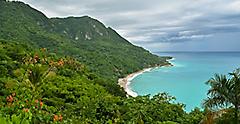
easterN caribbean cruises
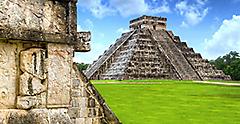
4-7 NIGHTS
western CARIBBEAN CRUISEs
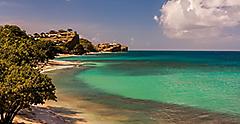
southern CARIBBEAN CRUISES

top cruise destinations

mexican riviera
STARTING FROM

THE CARIBBEAN

SEASONAL CRUISES
Royal Caribbean® elevates holidays to holi-yays any time of year. From spring getaways to family summer vacations and fall escapes to winter wanders. Escape to the most incredible destinations in the world on the best ships in the biz with big seasonal savings on 2024, 2025 and 2026 cruises.

Spring CRUISES

summer CRUISES

FALL CRUISES

WINTER CRUISES

HOP ON A SHORT GETAWAY CRUISE
Short on time? No problem. Royal Caribbean makes it easy to maximize your weekends with short getaways that go long on thrills. Take a break from the daily grind and slip into vacation mode with unbeatable deals on 2-3 night cruises that fit more fun into just a few days.
SIGN UP TO STAY IN THE LOOP
Sign up to receive information about our special offers and deals. You can unsubscribe at any time. For more details about how we use your information, view our Privacy Policy .

EPIC, EXTENDED SAILINGS

ONE-WAY WONDERS
REPOSITIONING CRUISES

ROYAL CARIBBEAN CRUISE 2024-26 GUIDE
When it comes to planning the ultimate getaway, there are so many reasons why cruise vacations rank among the most popular travel options. First of all, they’re completely stress-free. On a cruise vacation, all the planning is taken care of by the cruise line — from the destinations you sail to and the shore excursions available at each port, to a full range of entertainment and activities happening onboard every day. If you’re not a planner, or if the only things you’re looking to focus on during your getaway is savoring great food, relaxing, and soaking up the sights, cruise vacations are the way to go. A cruise vacation is also a great option if you’re traveling with the whole family, especially when you opt for a Royal Caribbean cruise. All of the ships in this cruise line’s fleet offer family-friendly experiences for guests of all ages. Even little ones will find plenty of ways to play with spaces and activities designed for tots to tweens. One of the top reasons savvy travelers love cruising, though, is because of the incredible value it offers. With Royal Caribbean, your cruise fare includes access to most of the ship’s attractions, select dining venues and all of the entertainment onboard. If you want to make your experience even more all-inclusive, you can opt for beverage and specialty dining packages that cover drinks and dinner at some of the most exclusive restaurants in the fleet. On top of all that, the cruise line presents frequent limited-time offers and seasonal sales, making it easy to score big savings when booking your vacation.
EXPLORE MORE
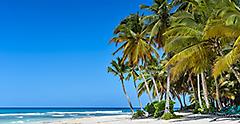
Previewing: Promo Dashboard Campaigns
My Personas
Code: ∅.
I've traveled on all 5 Disney cruise ships. I have 2 clear favorites, and there's only one I'm not in a hurry to book again.
- My family and I have been on nine Disney cruises and all five ships.
- We love the fleet's two smallest ships, Disney Wonder and Disney Magic.
- Although we had a great experience on board Disney Wish , it was my least favorite ship to travel on.

I've been on nine Disney cruises with my husband and two teenage sons. We've sailed on other cruise lines including Carnival, Celebrity, MSC, and Royal Caribbean , but Disney Cruise Line is always our top pick.
Stellar service, subtle theming, top-notch kids' and teen programs, and a dreamy private island in the Bahamas are some of the reasons we keep returning.
So far, we've been on all five Disney Cruise Line ships — Disney Magic, Disney Wonder, Disney Dream, Disney Fantasy, and Disney Wish. We'll soon have more ships to explore, with Disney Treasure planning to set sail in December and Disney Destiny set to embark on its maiden voyage in 2025 .
Out of the five ships we've been on, two stand out as favorites, and there's only one I'm not in a hurry to travel on again.
My favorite ships are Disney Wonder and Disney Magic
Disney Wonder and Disney Magic are my favorite ships in the Disney Cruise Line.
They have nearly identical deck layouts and are the fleet's two smallest ships. Some may see this as a negative, but I prefer the smaller, more intimate size and the ease of getting around the ships.
Disney Wonder also has my favorite Disney Cruise Line restaurant, Tiana's Place. It offers a delicious, Cajun-inspired menu and a fun "The Princess and the Frog" theme. There's even a lively floor show with jazz music.
Related stories
I love Disney Magic , too, but I thought it was more dated and in need of an update than Disney Wonder.
I also didn't love the Magic's Rapunzel-themed restaurant nearly as much as I love Tiana's Place.
The food at Rapunzel's Royal Table was just so-so, but the entertainment and theming more than made up for it. The in-person appearance of Rapunzel and Flynn, capped by a lantern processional to the tune of "I See the Light," was glorious.
Although Disney Wish was great, it was my least favorite ship to travel on
Although I had a great experience on board Disney Wish, it was my least favorite ship to travel on.
The Wish is unarguably beautiful — everything is sparkling new, and the atrium is decked out with a life-size Cinderella sculpture — but I thought the layout was a little clunky.
I may have felt this way because many of Disney's ships are laid out very similarly, and after nine cruises, we're pros at finding our way around.
Disney Wonder and Disney Magic have nearly identical deck layouts, as do Disney Dream and Disney Fantasy. Disney Wish, however, is laid out much differently.
Unlike the other Disney cruise ships we've been on, Disney Wish doesn't have a specific area for adults-only lounges.
Instead, the adults-only bars and lounges, which are off-limits to kids after 7 p.m., are scattered throughout the ship. This means the Wish doesn't have that true kid-free haven that the other ships have.
I also found that many parts of the ship, from the dining rooms to the pools, felt crowded
For all that criticism, my family and I enjoyed sailing on Disney Wish . But now that we've crossed it off our list, we won't be in any hurry to jump on board again unless the route is one we can't pass up.
Correction: June 7, 2024 — An earlier version of this story mislabeled a photo of Disney Wish as Disney Wonder.
Watch: Shipwreck detective rates 11 wreck scenes in movies and television
- Main content
Princess Cruises ships from newest to oldest — a complete list

What is the newest Princess Cruises ship? If you're in the market for a Princess cruise, it's something worth knowing.
The newest Princess cruise ship is typically also the Princess ship with the most up-to-date restaurants, bars, attractions and cabins. It's the one to choose if you want the very latest and greatest in a vessel for your Princess cruise vacation.
As of this year, the newest Princess cruise ship is Sun Princess — the first of a new class of vessels for the line. It just sailed on its maiden voyage in February.
For more cruise guides, news and tips, sign up for TPG's cruise newsletter .
Other relatively new Princess ships include Discovery Princess, Enchanted Princess, Sky Princess and Majestic Princess. All began sailing in the last seven years.
In all, Princess Cruises operates 16 vessels. On average, the line comes out with one new ship every two years or so, and it typically keeps vessels in its fleet for around 20 to 30 years before retiring them. The oldest Princess Cruises ship, Grand Princess, is 26 years old.
In general, Princess Cruises' newest ships are bigger and more venue-packed than its older ships. If you crave a lot of options for restaurants, bars and pool areas for your Princess cruise vacation, you'll want to stick to vessels built in the last 10 or so years.
Related: The 4 types of Princess Cruises ships, explained
The oldest Princess cruise ships — those built in the late 1990s and early 2000s — can be as much as 30% smaller than the line's newest vessels.
Here, every Princess ship currently in operation is ranked from newest to oldest:
1. Sun Princess
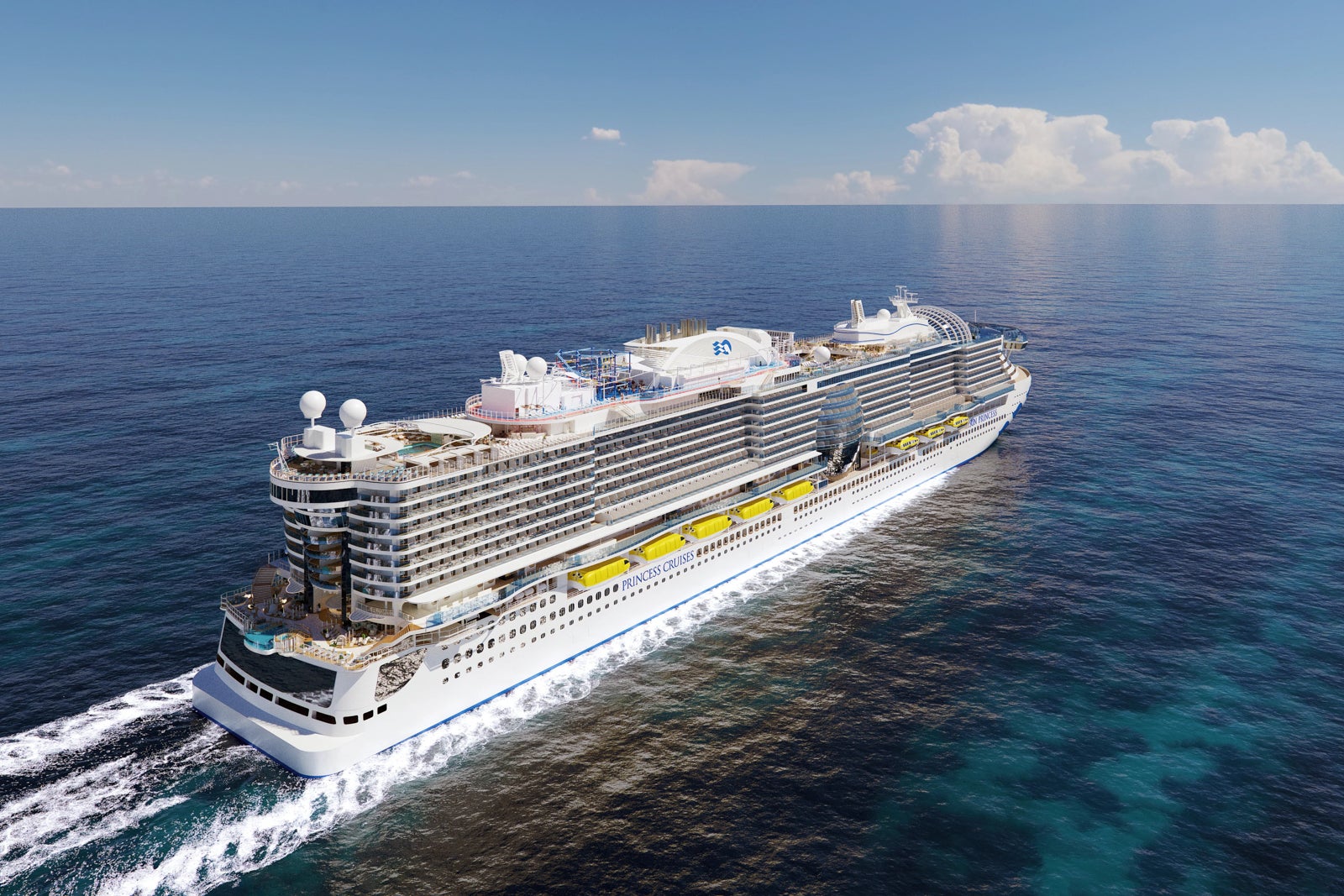
Maiden voyage: 2024 Size: 177,882 gross tons Passenger capacity: 4,300
2. Discovery Princess
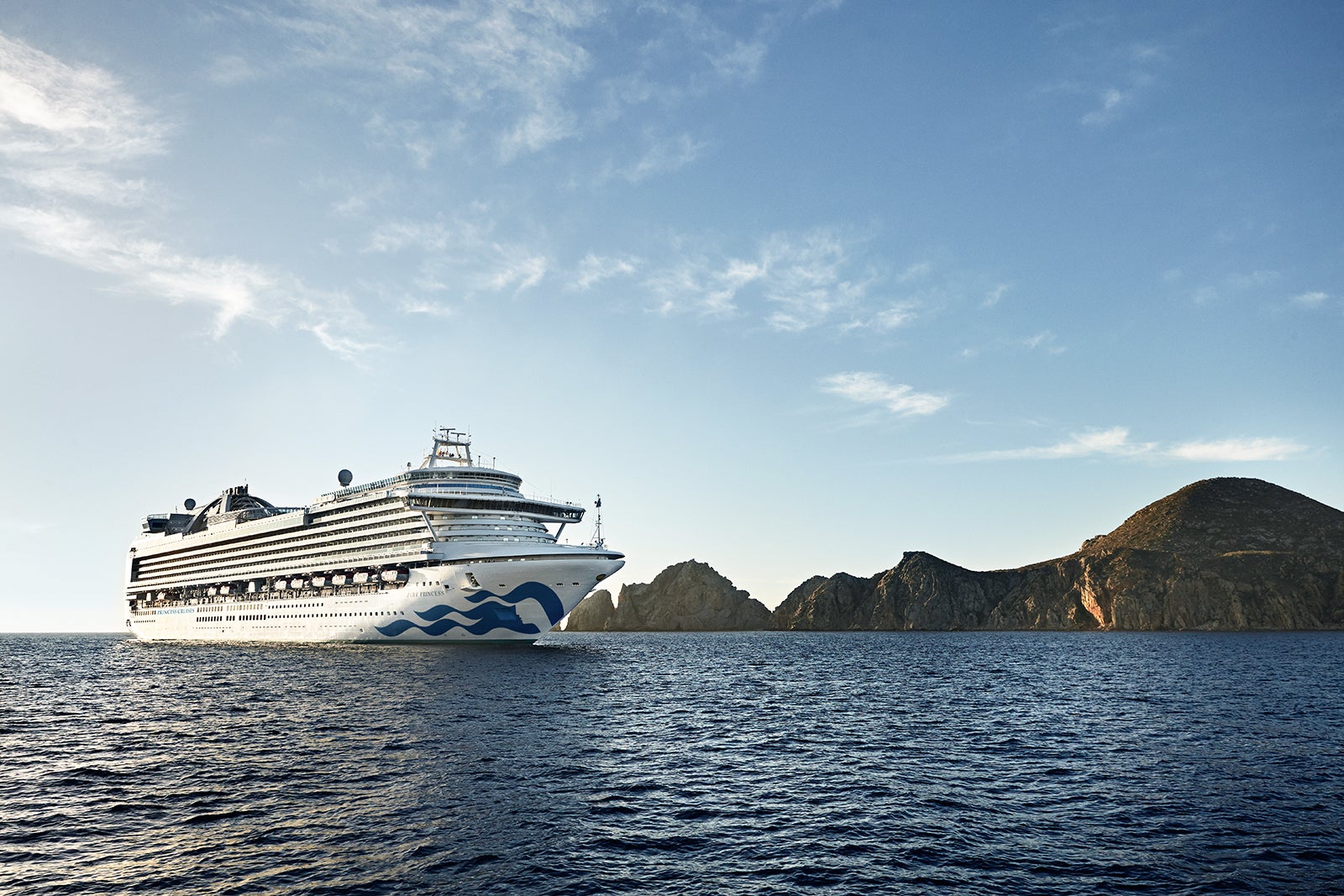
Maiden voyage: 2022 Size: 145,000 gross tons Passenger capacity : 3,660
3. Enchanted Princess
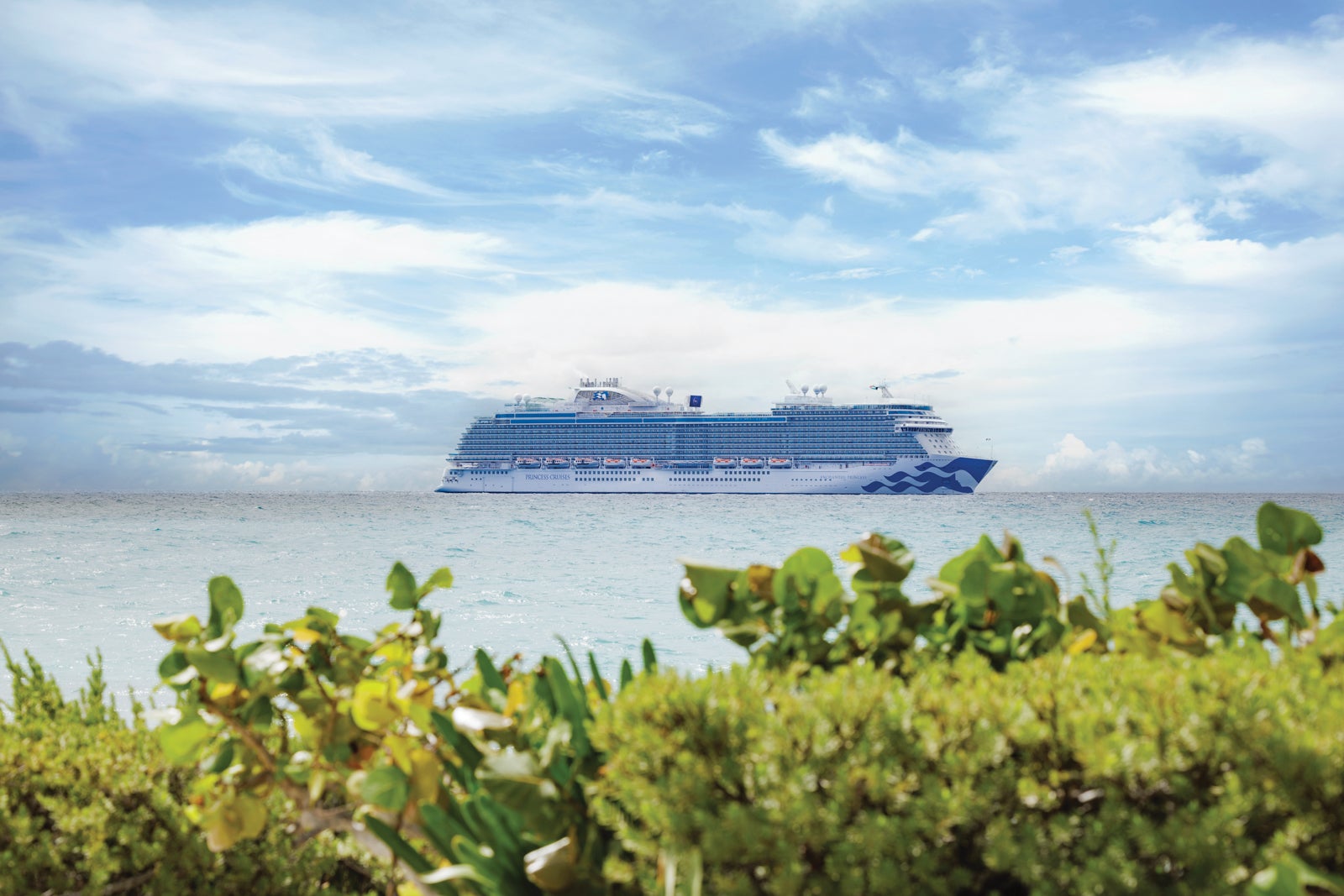
Maiden voyage: 2020 Size: 144,650 gross tons Passenger capacity : 3,660
4. Sky Princess
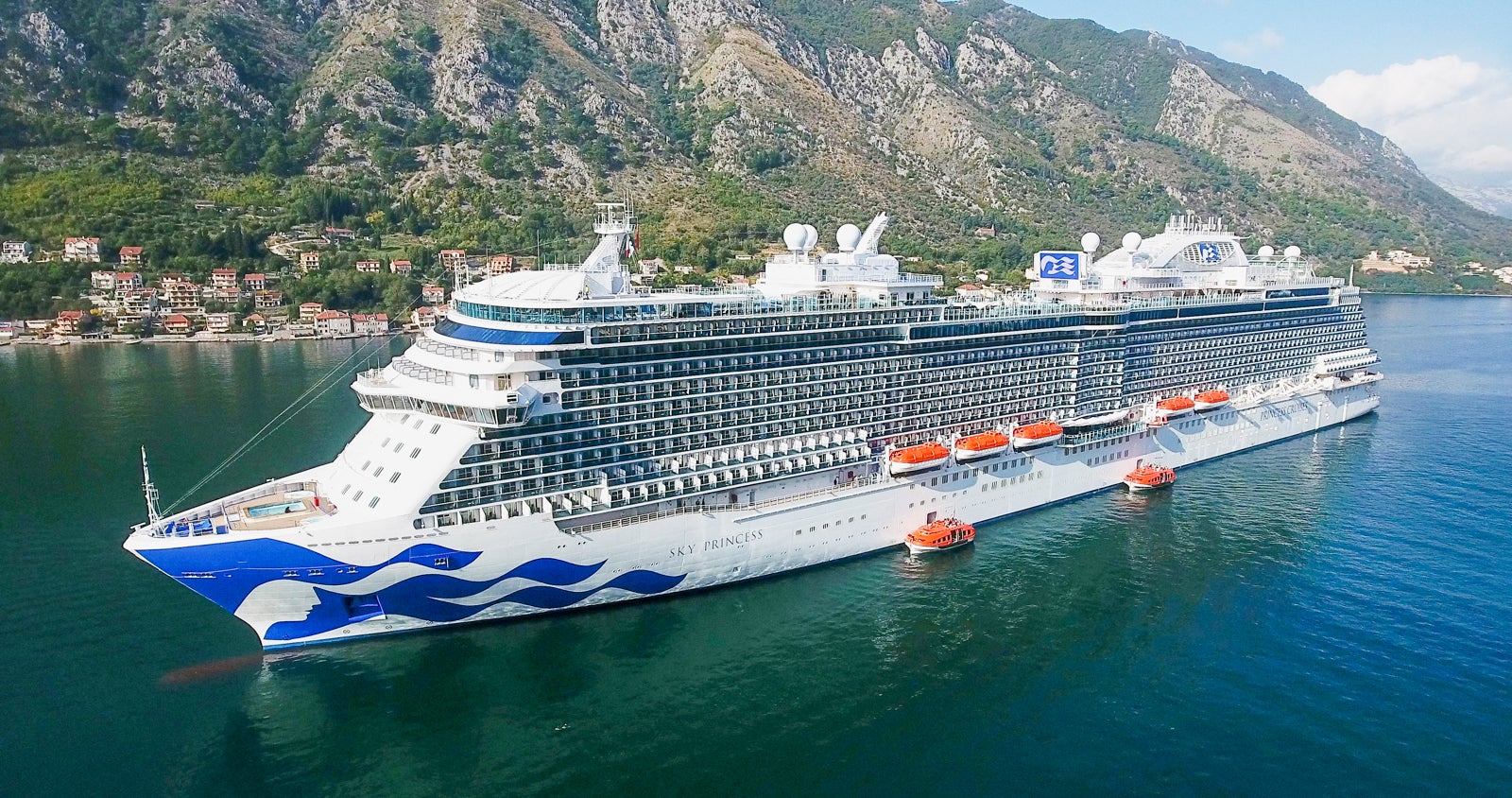
Maiden voyage: 2019 Size: 144,650 gross tons Passenger capacity : 3,660
5. Majestic Princess
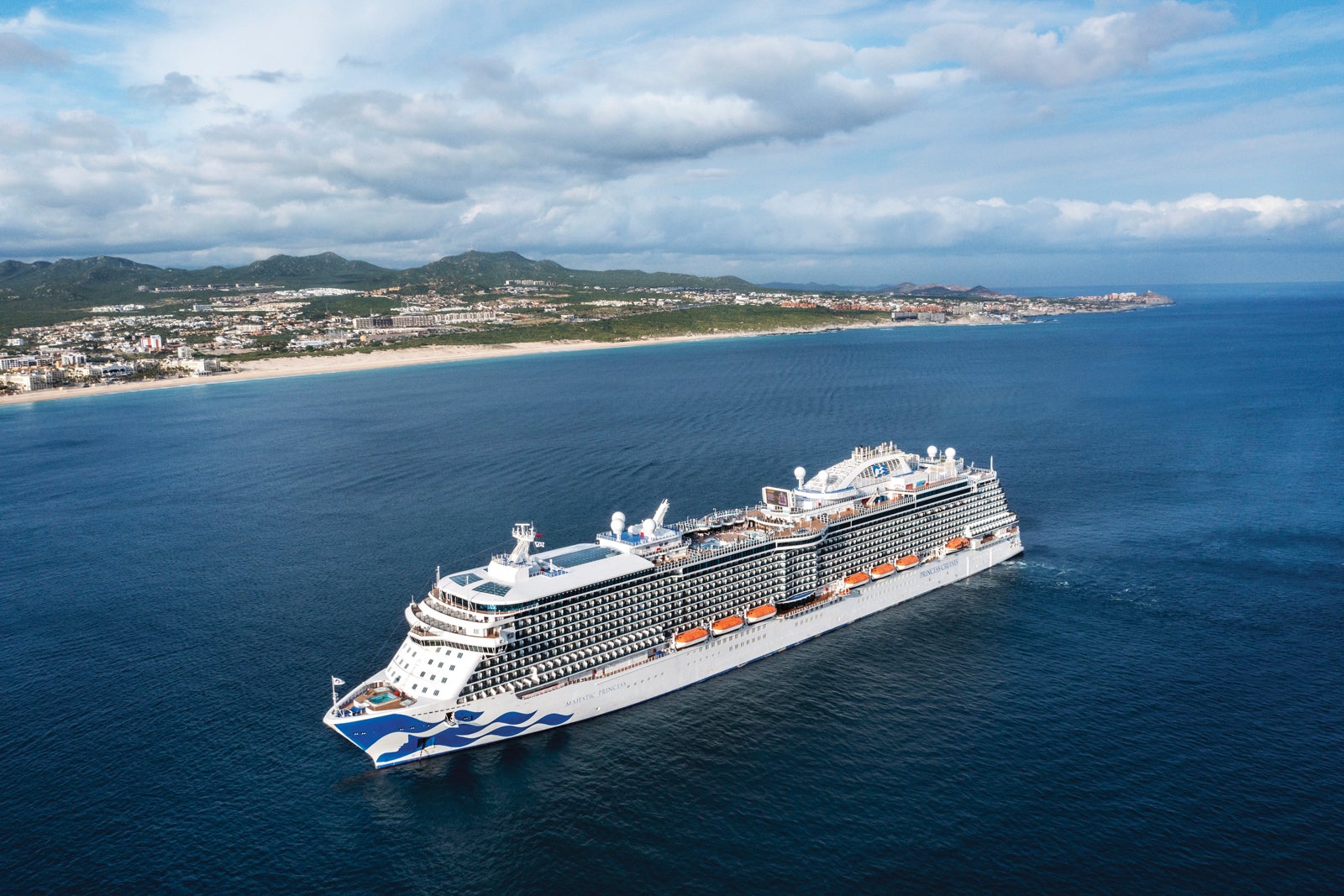
Maiden voyage: 2017 Size: 143,700 gross tons Passenger capacity : 3,560
6. Regal Princess
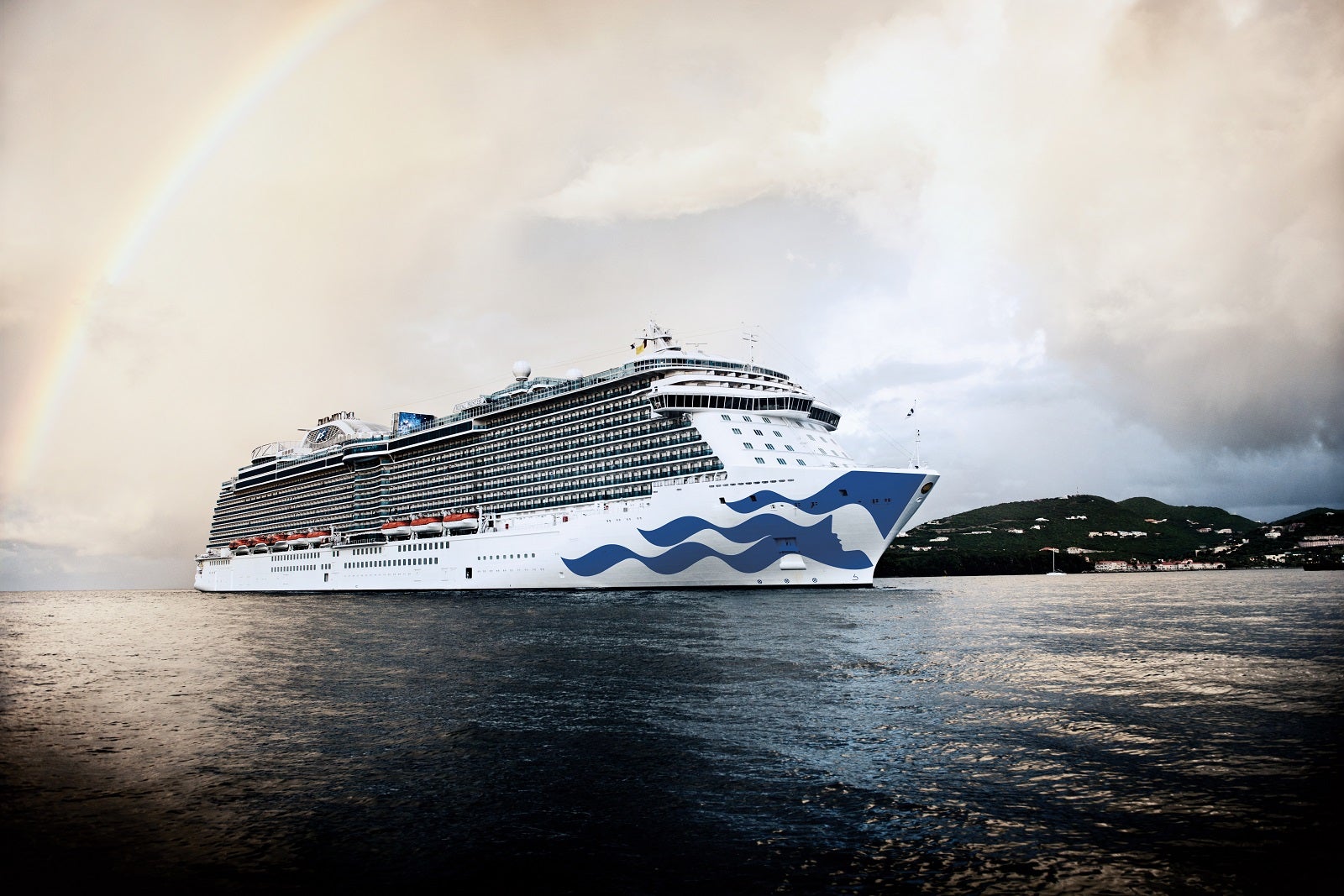
Maiden voyage: 2014 Size: 142,229 gross tons Passenger capacity : 3,560
7. Royal Princess
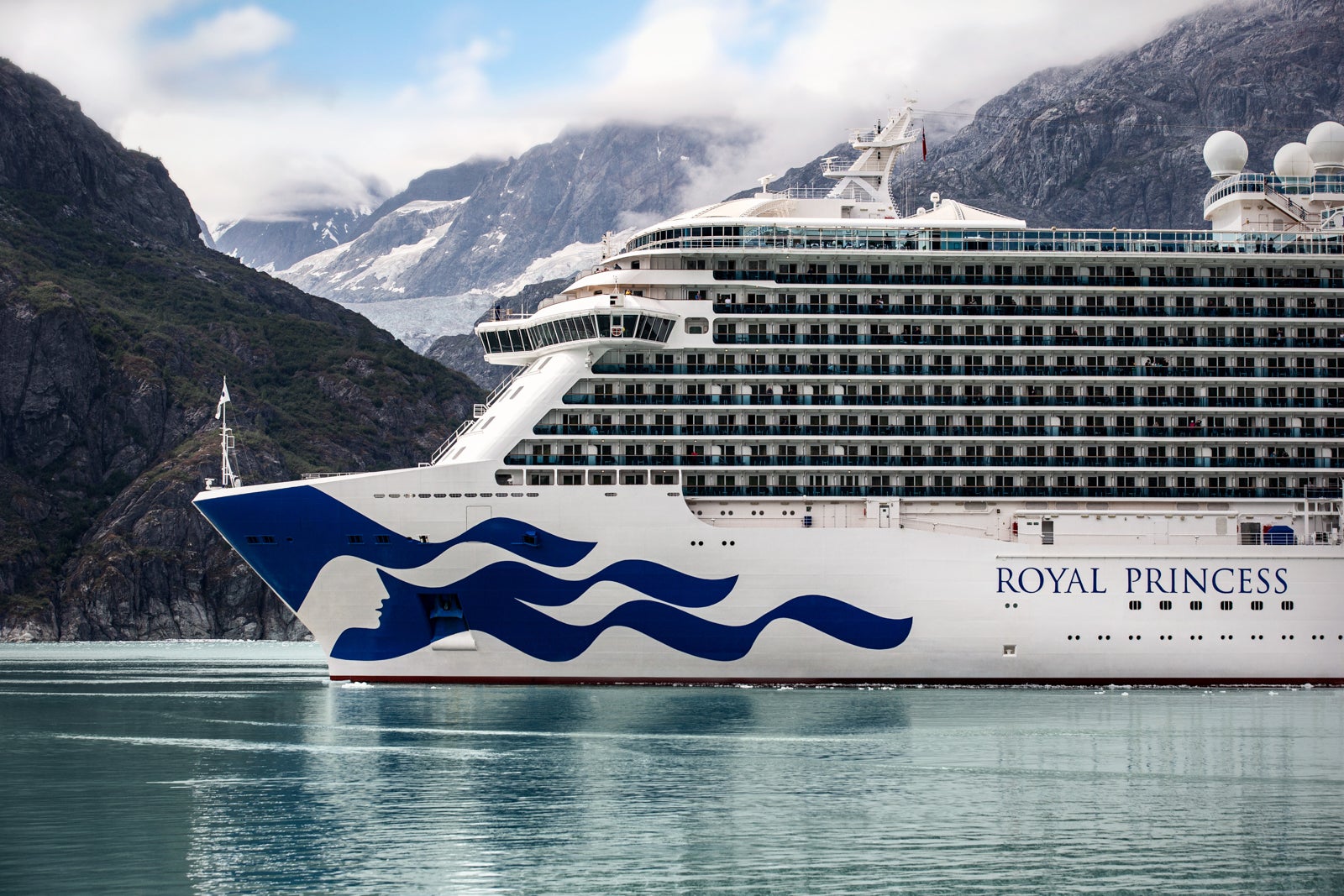
Maiden voyage: 2013 Size: 142,229 gross tons Passenger capacity : 3,560
8. Ruby Princess
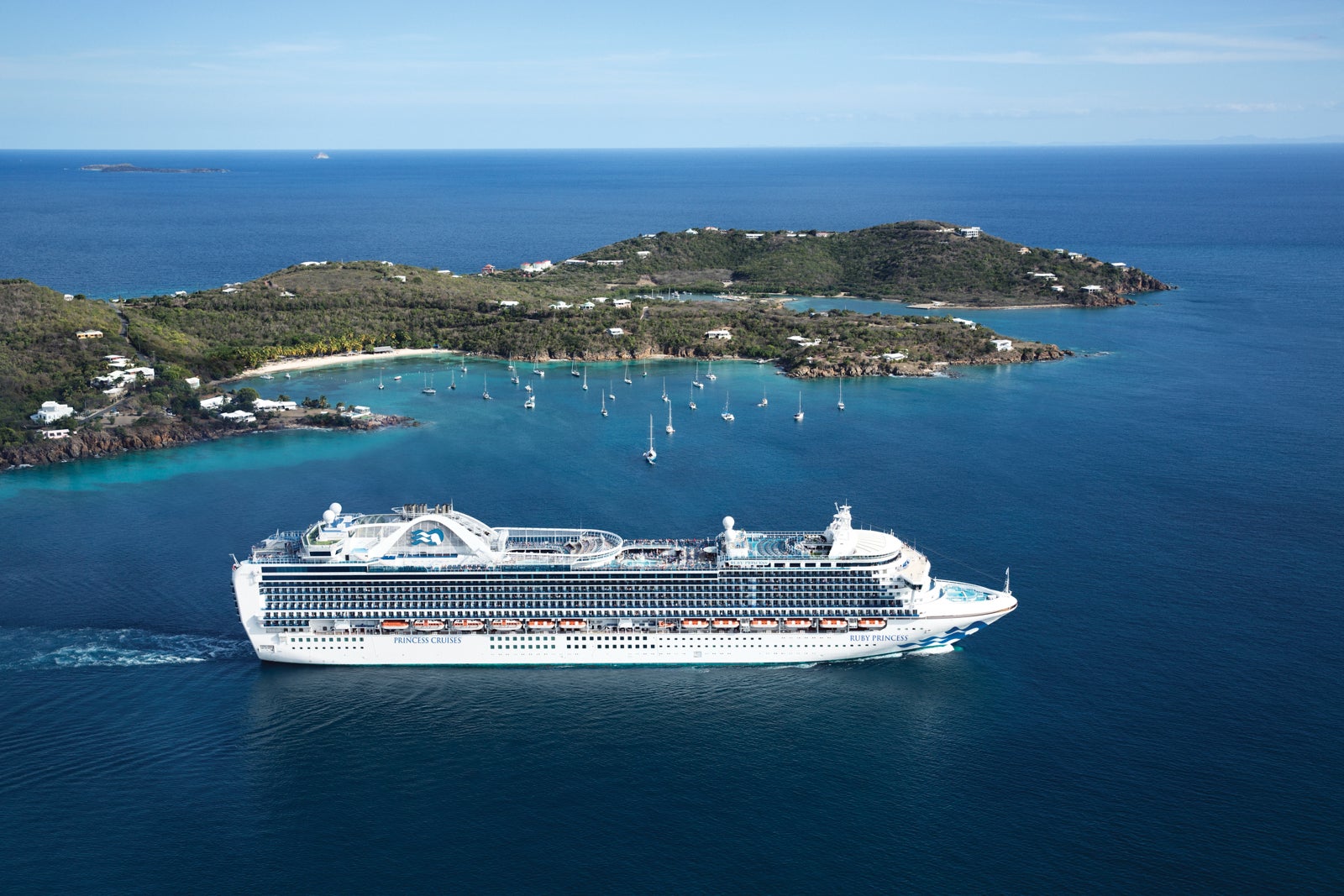
Maiden voyage: 2008 Size: 113,561 gross tons Passenger capacity : 3,080
9. Emerald Princess
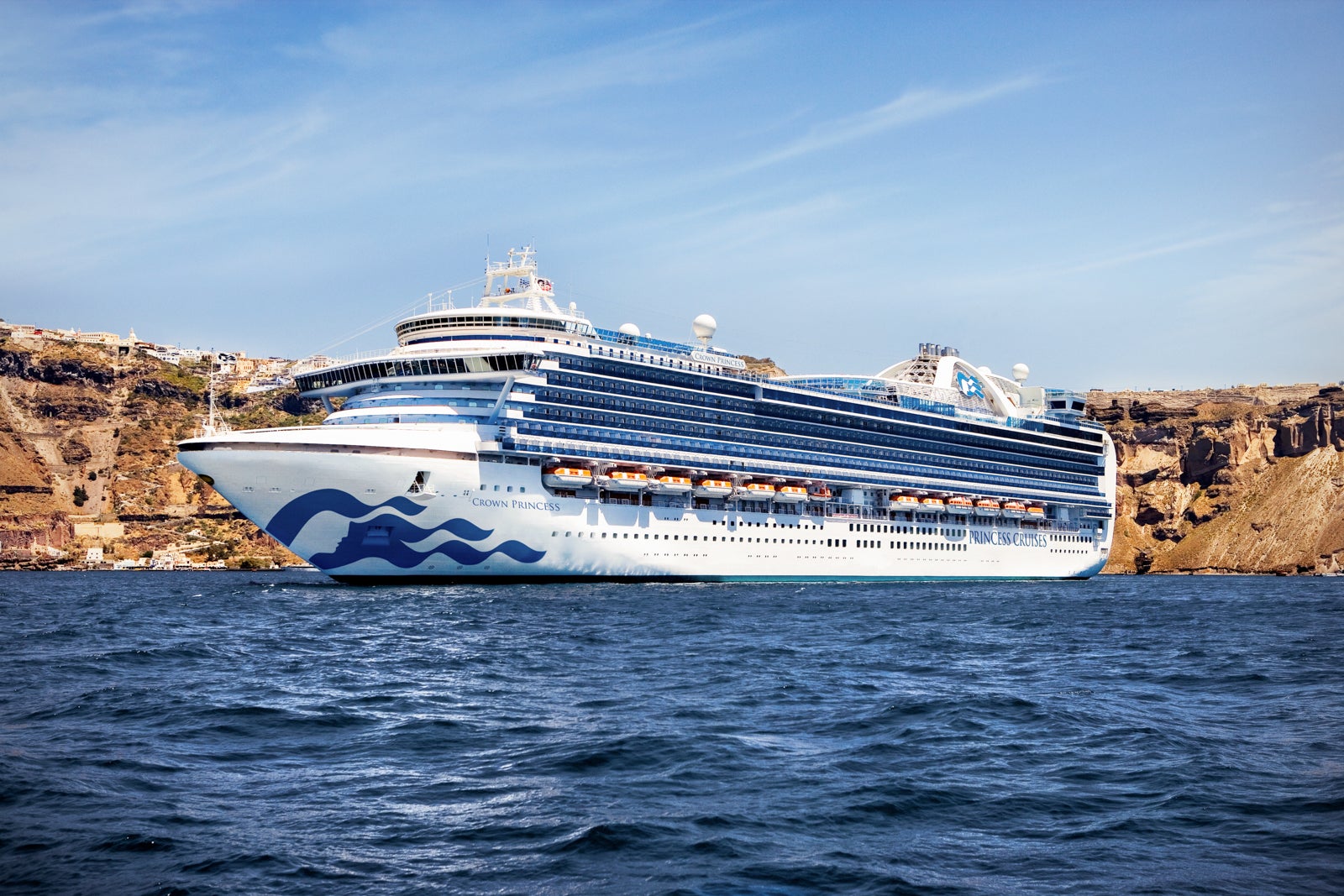
Maiden voyage: 2007 Size: 113,561 gross tons Passenger capacity : 3,080
10. Crown Princess
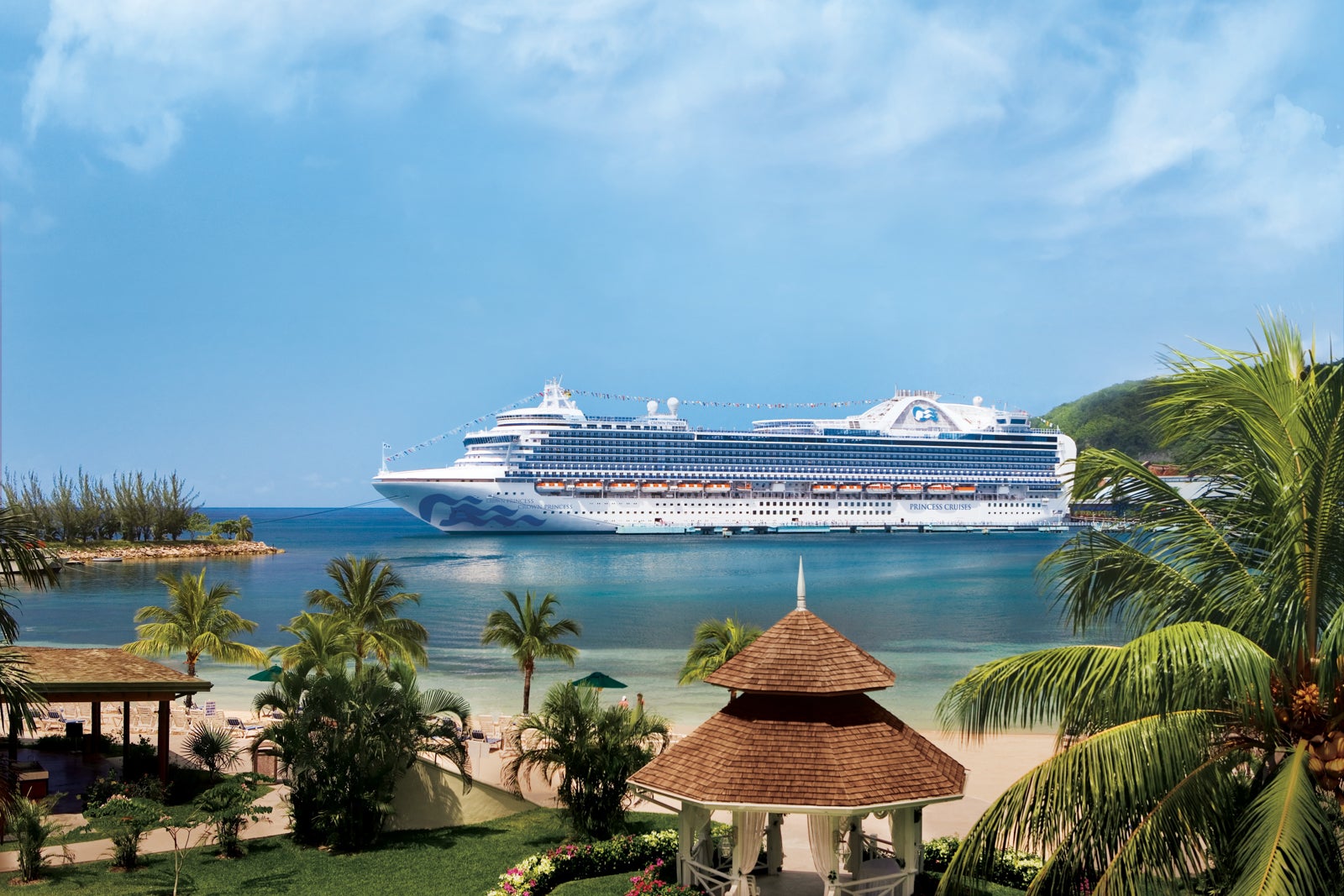
Maiden voyage: 2006 Size: 113,561 gross tons Passenger capacity : 3,080
11. Caribbean Princess
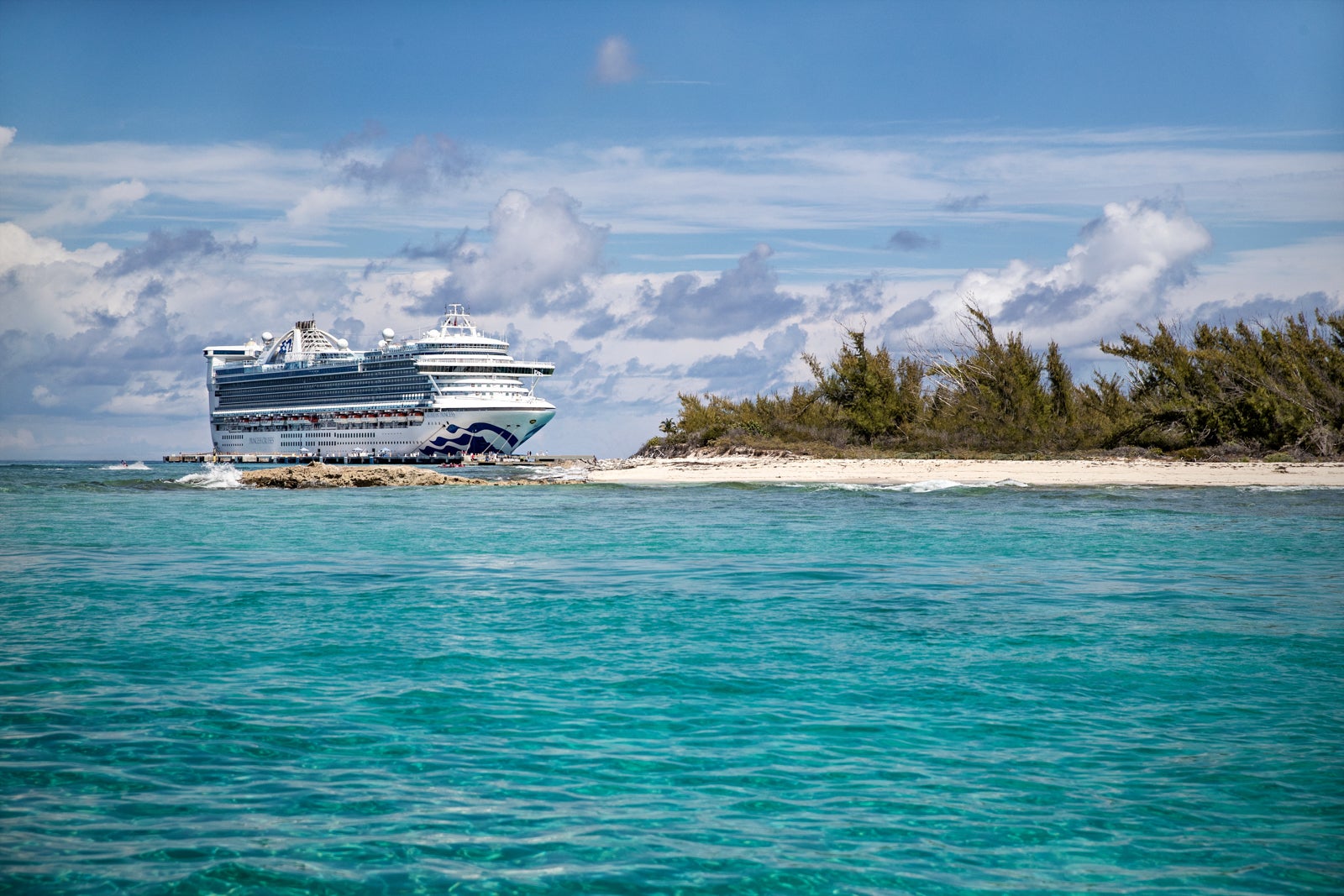
Maiden voyage: 2004 Size: 112,894 gross tons Passenger capacity : 3,149
12. Sapphire Princess
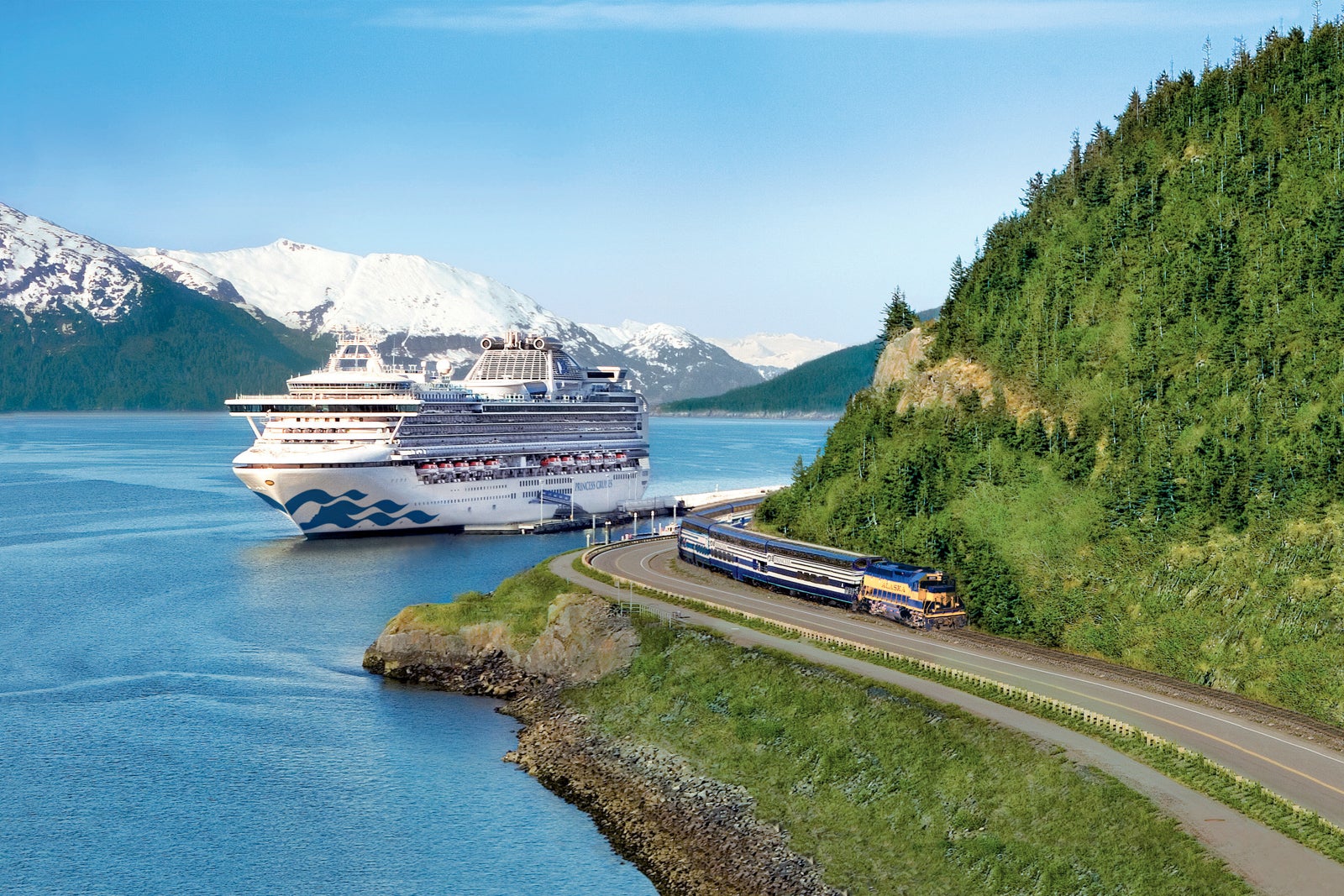
Maiden voyage: 2004 Size: 115,875 gross tons Passenger capacity : 2,670
13. Diamond Princess
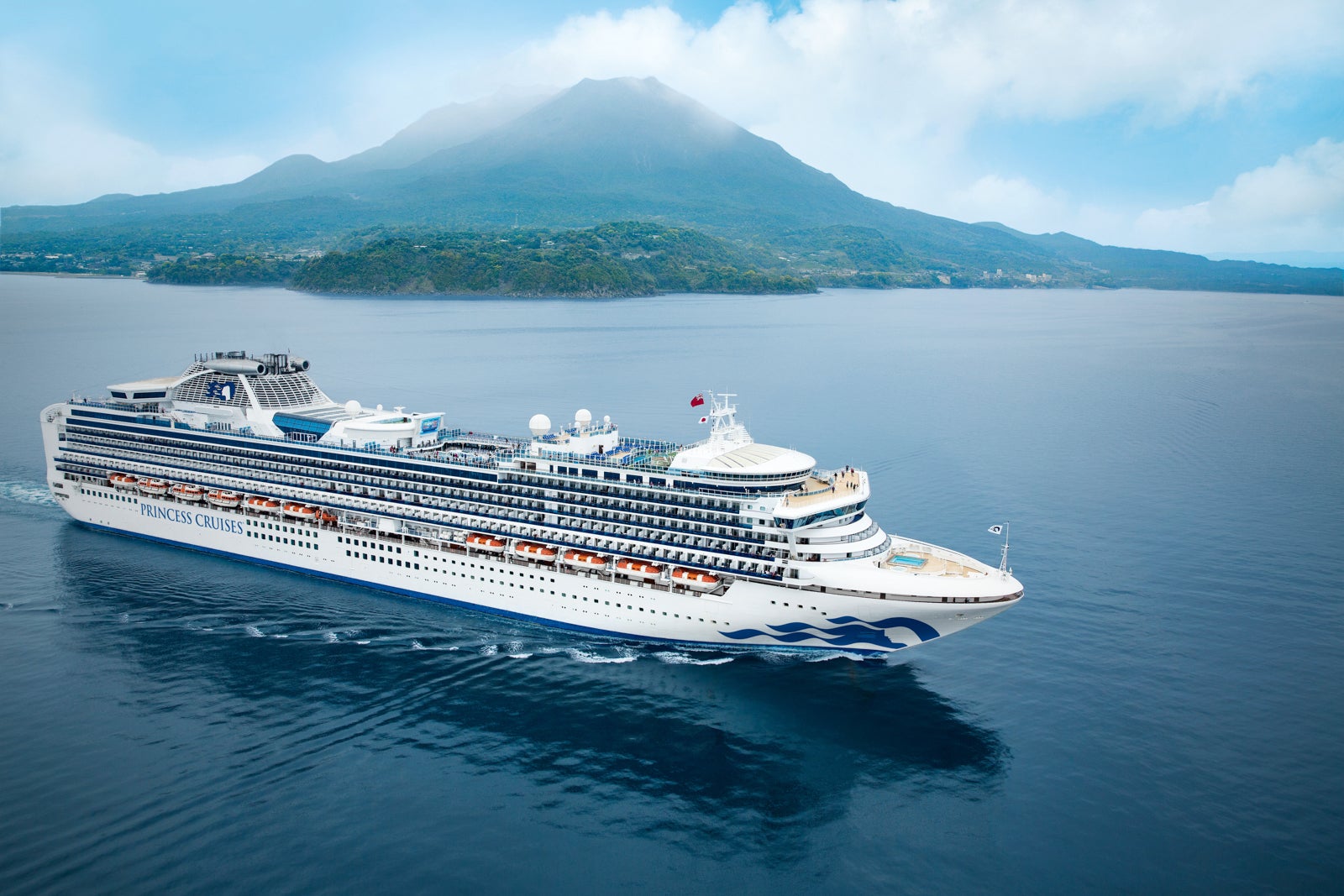
14. Island Princess

Maiden voyage: 2003 Size: 92,822 gross tons Passenger capacity : 2,200
15. Coral Princess
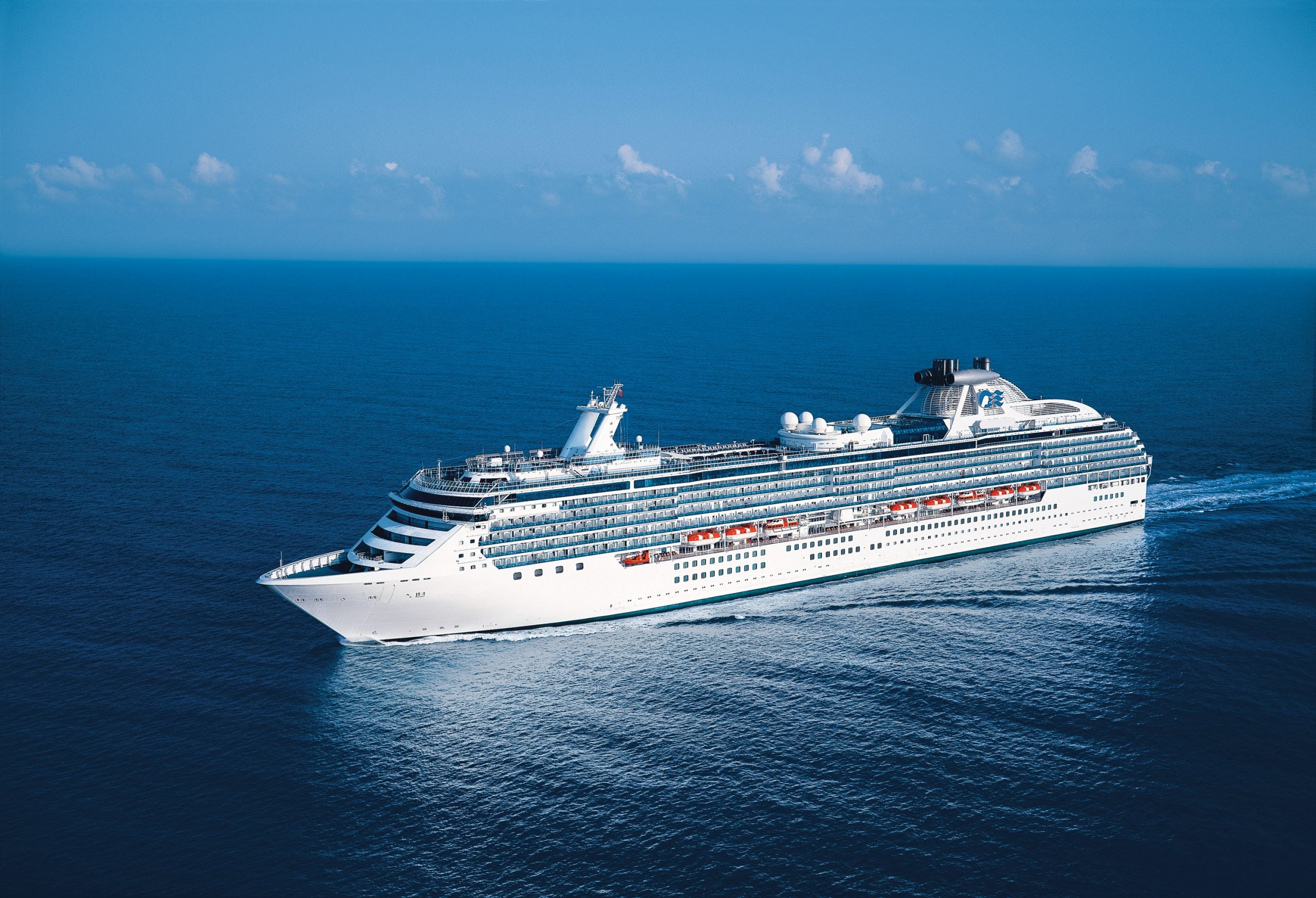
Maiden voyage: 2002 Size: 91,627 gross tons Passenger capacity : 2,000
16. Grand Princess
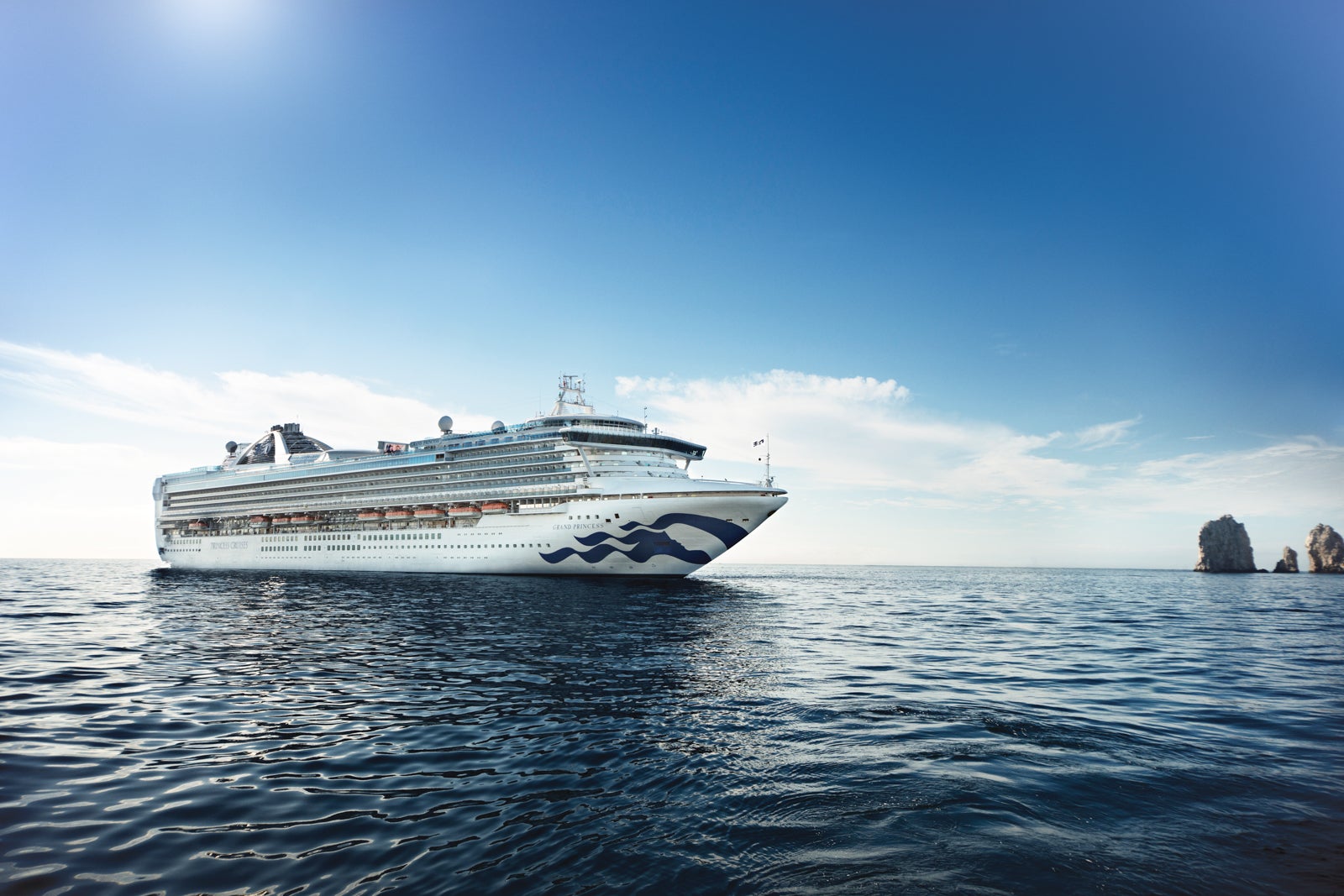
Maiden voyage: 1998 Size: 107,517 gross tons Passenger capacity : 2,600
What is the newest Princess cruise ship?
The newest Princess cruise ship is Sun Princess. As noted above, it just debuted in February.
Measuring 177,882 gross tons, Sun Princess is the biggest Princess cruise ship ever built and has more restaurants, bars, showrooms and deck-top pool space than any other Princess ship.
Sun Princess is the first vessel in Princess Cruises' new Sphere Class of ships and considerably bigger than the vessels in the line's last new series of ships, the Royal Class. A second ship in the Sphere Class series, Star Princess , is under construction and will debut in October 2025.
For more details on Sun Princess, including what venues are on board and what it's like to sail on the vessel, see TPG's comprehensive first look at Sun Princess after an early sailing.
What is the oldest Princess cruise ship?
The oldest Princess cruise ship is Grand Princess. Unveiled way back in 1998, it's the namesake vessel for the line's Grand Class of vessels, which remain at the core of the Princess fleet.
There are seven Grand Class vessels in the Princess fleet in all, making it the biggest grouping of ships at the line. Unveiled between 1998 and 2008, the Grand Class vessels are smaller than the Sphere Class and Royal Class vessels at around 107,000 to 116,000 tons in size. This smaller size allows them to operate a wider range of itineraries than the Sphere Class and Royal Class ships, as the vessels can access some smaller ports that aren't as accessible to the bigger ships.
Related: The ultimate guide to Princess Cruises
Still, the Grand Class vessels are big enough to offer a lot of onboard venues. The Grand Class ships carry between 2,600 to 3,100 passengers at double occupancy.
What new Princess cruise ships are coming?
Princess currently has one new cruise ship on order: Star Princess. As noted above, it's the second vessel in Princess' new Sphere Class series of ships, which for now will be made up of just two ships (Princess could order more Sphere Class ships in coming years — we'll see).
As noted above, Star Princess is scheduled to debut in October 2025. The ship was scheduled to debut earlier in 2025 but recently was delayed by several months due to construction issues.
The Sphere Class vessels are being built at the Fincantieri shipyard near Monfalcone, Italy.
What is the newest Princess cruise ship available for booking?
Star Princess is the newest Princess cruise ship you can book right now. While the vessel isn't yet in operation, its initial sailings scheduled for October 2025 already are on sale, as are future voyages through March 2026.
What is the newest class of Princess cruise ships?
The Sphere Class is the newest class of Princess ships. It'll be made up of at least two vessels, the first of which (Sun Princess) is already sailing.
At 177,882 tons, Sun Princess is about 22% bigger than the previous biggest ships in the Princess fleet — a significant jump in size for the line. And yet, while it's 22% bigger, it's designed to hold just 17% more passengers.
In other words, its space-to-passenger ratio is greater, making the ship feel roomier — if only modestly.
Related: Everything to know about Princess cabins and suites
In addition to being significantly bigger than past Princess ships, Sun Princess is also the first Princess ship with suites that come with exclusive access to a private restaurant, lounge and sun deck — a sign Princess hopes to draw more upmarket travelers.
In all, the vessel is designed to hold 4,300 passengers at double occupancy.
What's the difference between newer and older Princess ships?
Newer Princess ships generally are bigger than older Princess ships and thus have more and bigger onboard venues than the line's older vessels.
On the newest Princess cruise ships, the Sphere Class and Royal Class vessels, for instance, you'll find the largest piazza-like central atriums in the Princess fleet surrounded by lots of bars and restaurants; multiple entertainment venues for live shows, comedy acts and more; and expansive pool decks with more space for sunning than you'll find on smaller Princess vessels.
You'll also find some only-on-the-Royal-class-ships extras, including, on some of the Royal Class ships, a glass-floored "SeaWalk" that extends over the side of the vessel.
Related: The 5 best destinations you can visit on a Princess ship
Princess' oldest cruise ships are significantly smaller than its newest ships and lack some of the above features. They have a more intimate feel, at least in the pantheon of relatively big, mass-market ships, and they hold fewer people. While Sphere Class and Royal Class ships can hold more than 4,500 passengers with every berth full, the line's oldest vessels (particularly the relatively small Island Princess and Coral Princess) often sail with just 2,000 or so passengers on board.
That makes them a good choice for someone who wants to try Princess Cruises but isn't eager to travel with huge crowds. The oldest ships in the Princess fleet thus appeal to a subset of Princess fans who prefer more intimacy in a cruise vessel and don't mind giving up some onboard amenities to get it. They are also often less expensive to sail on, on a per-day basis.
Related: Don't miss out on these Princess loyalty perks
In addition, because of their size, the oldest ships at Princess Cruises are able to operate itineraries to places that aren't as easy for big ships to visit. Not all ports in the world can handle a ship the size of Sun Princess.
Note that all Princess Cruises ships are renovated and upgraded on a regular schedule every few years, so even the oldest Princess vessels have newer carpeting, updated furniture, modern decor in cabins and other updates. In many cases, they also have had entire eateries and bars renovated over the years with concepts that first debuted on newer vessels.
Planning a cruise? Start with these stories:
- The 5 most desirable cabin locations on any cruise ship
- 8 cabin locations on cruise ships you should definitely avoid
- Which cruise brand is best for you? A guide to the most popular lines
- 21 tips and tricks that will make your first cruise go smoothly
- 15 ways that cruising newbies waste money on their first cruise
- The 15 best cruise ships for people who never want to grow up
- Cruise packing list: The ultimate guide to what to pack for a cruise

IMAGES
VIDEO
COMMENTS
The Sinking of MV Jupiter (October 1988) The MV Jupiter, a Greek cruise ship, started sailing in 1961 as the Moledet. On October 21, 1988, it sank after leaving Piraeus, Greece. An Italian freight ship hit it. The ship had nearly 400 British students, 84 adults, and 110 crew members on a study cruise.
Only twenty-four cruise ships—both river and ocean liners—have sunk since 1912. It's important to remember that some cruise ship capsizings happen while the ship was being towed or berthed. Because cruise ships are built sturdy and have current safety mechanisms, we can explain why there aren't many cruise ship sinkings.
Here, in chronological order, are the 24 cruise ships that have sunk in history: 1. April 1912: Titanic. Titanic Ocean Liner. Perhaps the most infamous cruise ship sinking took place on April 14 ...
List of all sunken cruise ships since 1912. For the sake of this list, I've looked back at the last 110 years or so, so that we cover everything from possibly the most famous cruise ship sinking ever. Important - I've also decided to keep this list to cruise ships (both ocean and river), and ocean liners that served as cruise ships.
In the past 100 years, approximately 24 cruise ships have sunk. The causes and impacts of these incidents vary, including wartime activities, accidents, and severe weather conditions. In some cases, ships sank only while being towed. In modern times, cruise ships rarely sink, thanks to strict safety rules, ship stabilizers, modern technology to ...
5. October 1927, Principessa Mafalda. Built in 1909 and named for Princess Mafalda of Savoy, the Italian cruise ship Principessa Mafalda suffered tragedy in 1927. The ship sustained structural damage when it sank while traveling between Argentina and Italy as a result of a major propeller shaft failure.
Here are some notable ones in the past 100 years. Titanic (1912) The most famous cruise ship sinking in history, the Titanic sank after colliding with an iceberg. Empress of Ireland (1914) This large passenger liner sank after colliding with a Norwegian cargo ship, the Storstad, during foggy weather. Lusitania (1915) For a few months before her ...
It's important to understand that cruise ship sinkings are incredibly rare occurrences. Over the past 100 years, only 22 cruise ships have sunk. However, several sinkings occurred while ships were moored or being towed. Cruise ship sinkings are rare when you consider the number of cruise ships operating year-round.
Sunken cruise ships. Cruise ships that sank, including ones that were later salvaged. Including ocean liners converted into cruise ships during or after the 1960s, but excluding ocean liners which sank before the 1960s, and ocean liners which sank after the 1960s without ever being converted into a cruise ship. See also List of cruise ships .
How Many Cruise Ships Have Sunk? Only 22 cruise ships, including river cruise ships and ocean liners, have gone down in the last 100 years. Over half of the nearly 2,000 people killed in these disasters may be traced back to ships going down before 1940. There were no fatalities in several of the cases.
Thankfully, very few cruise ships have actually sunk in modern history. Even so, the Titanic's sinking impacted maritime law so much that there are more than enough lifeboats for all passengers and crew onboard any given sailing. Within the last 111 years, over 20 cruise ships and ocean liners have sunk. Titanic (April 1912)
1. The Unfateful RMS Titanic. The most infamous cruise ship accident has to be the RMS Titanic. The Olympic-Class Ocean liner was owned by White Star Line and built in Northern Ireland. It was the largest passenger ship of its time, designed by Thomas Andrews, capable of carrying over 3000 people.
The sinking of RMS Titanic in April 1912 remains the worst, and the most infamous, cruise ship disaster in history. The sinking of the biggest passenger ship ever built at the time resulted in the death of more than 1,500 of the 2,208 people onboard. The accident occurred when the ship hit an iceberg while cruising at its maximum speed of 23k ...
Since 1900, only 16 cruise ships have sunk. This includes ocean liners and river cruises as well. The Costa Concordia is the biggest cruise ship to sink in the last 100 years. But no sinking was as severe and deadly as the Titanic's. If cruise ships, ocean liners, and river cruises are considered, the number will be well over 16.
As a cruise enthusiast, I was astounded to discover that historically, 16 cruise ships have succumbed to the depths of the sea. These incidents underscore the hidden dangers that lie beneath the tranquil waters. In this article, we will explore the historical sinking incidents, delve into the causes behind these tragedies, and examine the impact […]
Famous Cruise Ship Sinking Cases. Throughout history, there have been several high-profile and memorable cruise ship sinking cases that have captured worldwide attention. These incidents serve as reminders of the potential risks and challenges faced by cruise ships on the open seas. Let's explore some of the most famous cruise ship sinking ...
This is a list of cruise ships, both those in service and those that have ceased to operate. Ocean liners are included on this list only if they also functioned as cruise ships. (See: list of ocean liners.) As some cruise ships have operated under multiple names, all names will be listed in the Status section, along with the history of the vessel, under the vessel's current or most recent name.
On 13 January 2012, the seven-year-old Costa Cruises vessel Costa Concordia was on the first leg of a cruise around the Mediterranean Sea when she deviated from her planned route at Isola del Giglio, Tuscany, sailed closer to the island, and struck a rock formation on the sea floor.This caused the ship to list and then to partially sink, landing unevenly on an underwater ledge.
Fortunately, since 2020, no confirmed cruise ship capsizing or sinking has occurred. The last one was the Orient Queen suffering no crew or passenger casualties, which sank due to a nearby ammonium nitrate explosion while moored. Below is a list of some available records of cruise ship sinkings since the iconic Titanic.
This is a list of ships sunk by missiles.Ships have been sunk by unguided projectiles for many centuries, but the introduction of guided missiles during World War II changed the dynamics of naval warfare. 1943 saw the first ships to be sunk by guided weapons, launched from aircraft, although it was not until 1967 that a ship was sunk by a missile launched from a ship outside a test environment.
The 9 Worst Cruise Ship Disasters. Neil Gladstone Dec 20, 2023. The Titanic may be the most famous ship disaster, but surprisingly, it's not even close to being the deadliest wreck that ever occurred on a luxury liner. If you're trying to dissuade someone from taking a cruise, you should show them this list of maritime misadventures ...
The Atlantic Ocean, not including Arctic and Antarctic regions. This is a partial list of shipwrecks which occurred in the Atlantic Ocean.The list includes ships that sank, foundered, grounded, or were otherwise lost. The Atlantic Ocean is here defined in its widest sense, to include its marginal seas: the Baltic Sea, the Black Sea, the Caribbean Sea, the Gulf of Mexico, the English Channel ...
List of shipwrecks: 1 January 2022 Ship State Description Baragoola Australia Baragoola The then 99-year-old ferry quickly sank at her moorings after a decade of being poorly maintained. Two people were aboard, and left the vessel soon after it started taking on water. The vessel is scheduled to be broken up in place, as refloating is considered impossible.
The 1916 sinking of the schooner "Endurance," carrying Antarctic explorer Ernest Shackleton, serves as a stark reminder of the unforgiving nature of these waters. ... As recently as 2023, a terrifying ordeal unfolded on the cruise ship Spirit of Discovery after it encountered a fierce storm in the Bay of Biscay. Roughly 100 people were injured ...
List of ships 2014 annexation of Crimea Russian Navy. Ochakov — The Kara-class cruiser was scuttled in Donuzlav Bay, Crimea, Ukraine, on 6 March.The scuttling was part of the Russian annexation of Crimea and intended to block ships of the Ukrainian Navy. Ochakov was raised and scrapped at Inkerman in 2015.; VM-416 — The Yelva-class diving support vessel was scuttled next to Ochakov on 7 March.
Costa Cruises. #10 in Best Cruise Lines for the Money. Read More ». A member of the Carnival family, Costa Cruises is primarily based in Europe. The fleet offers lower rates than its competitors ...
SEASONAL CRUISES. Royal Caribbean® elevates holidays to holi-yays any time of year. From spring getaways to family summer vacations and fall escapes to winter wanders. Escape to the most incredible destinations in the world on the best ships in the biz with big seasonal savings on 2024, 2025 and 2026 cruises. 2025.
Absolutely not. At most, I was about 50% prepared to take on the world's largest floating family vacation machine. I was, however, very confident in my ability to sip my way through Icon's ...
Disney Wonder and Disney Magic are my favorite ships in the Disney Cruise Line. They have nearly identical deck layouts and are the fleet's two smallest ships. Some may see this as a negative, but ...
The oldest Princess Cruises ship, Grand Princess, is 26 years old. In general, Princess Cruises' newest ships are bigger and more venue-packed than its older ships. If you crave a lot of options for restaurants, bars and pool areas for your Princess cruise vacation, you'll want to stick to vessels built in the last 10 or so years.